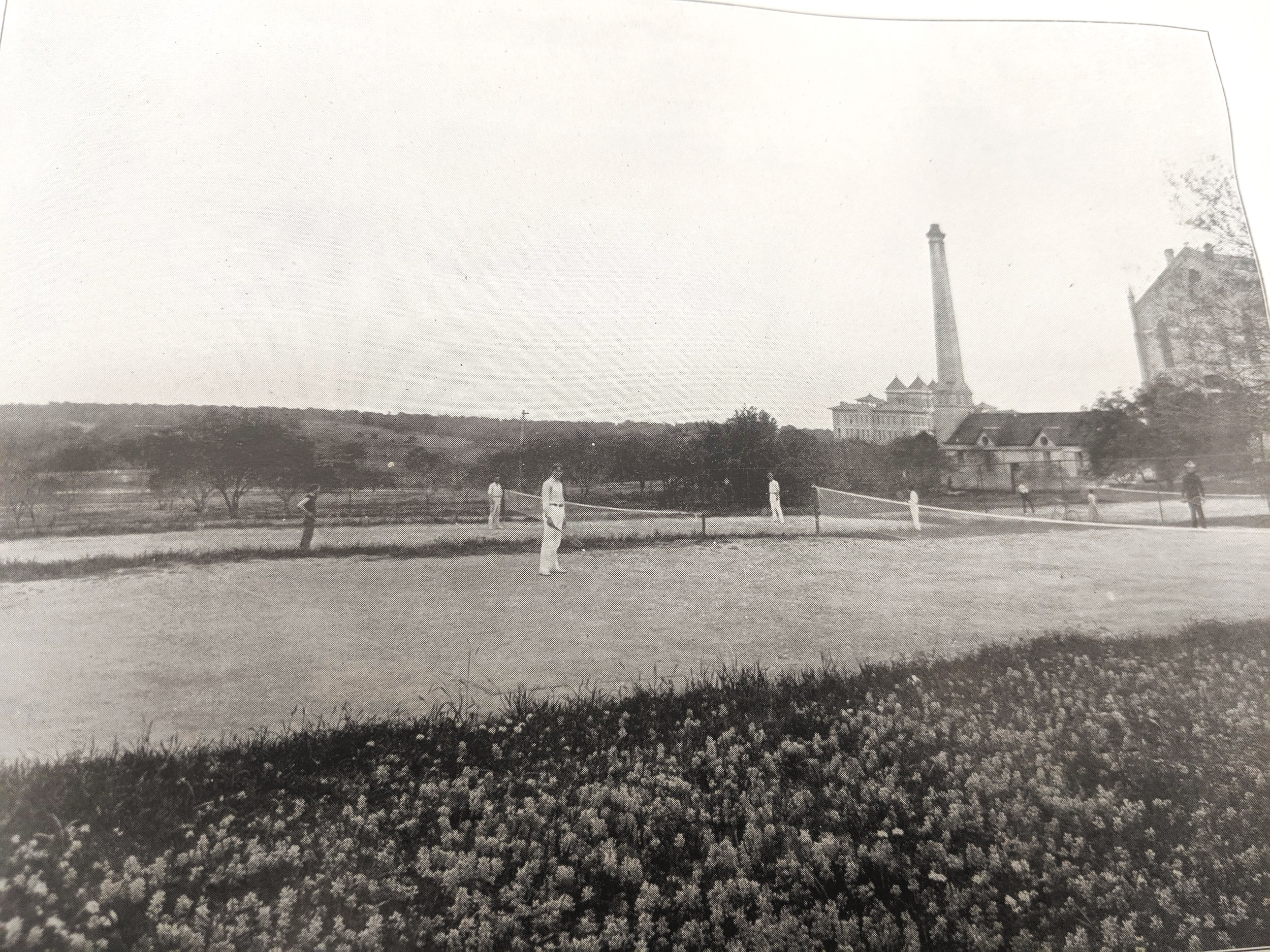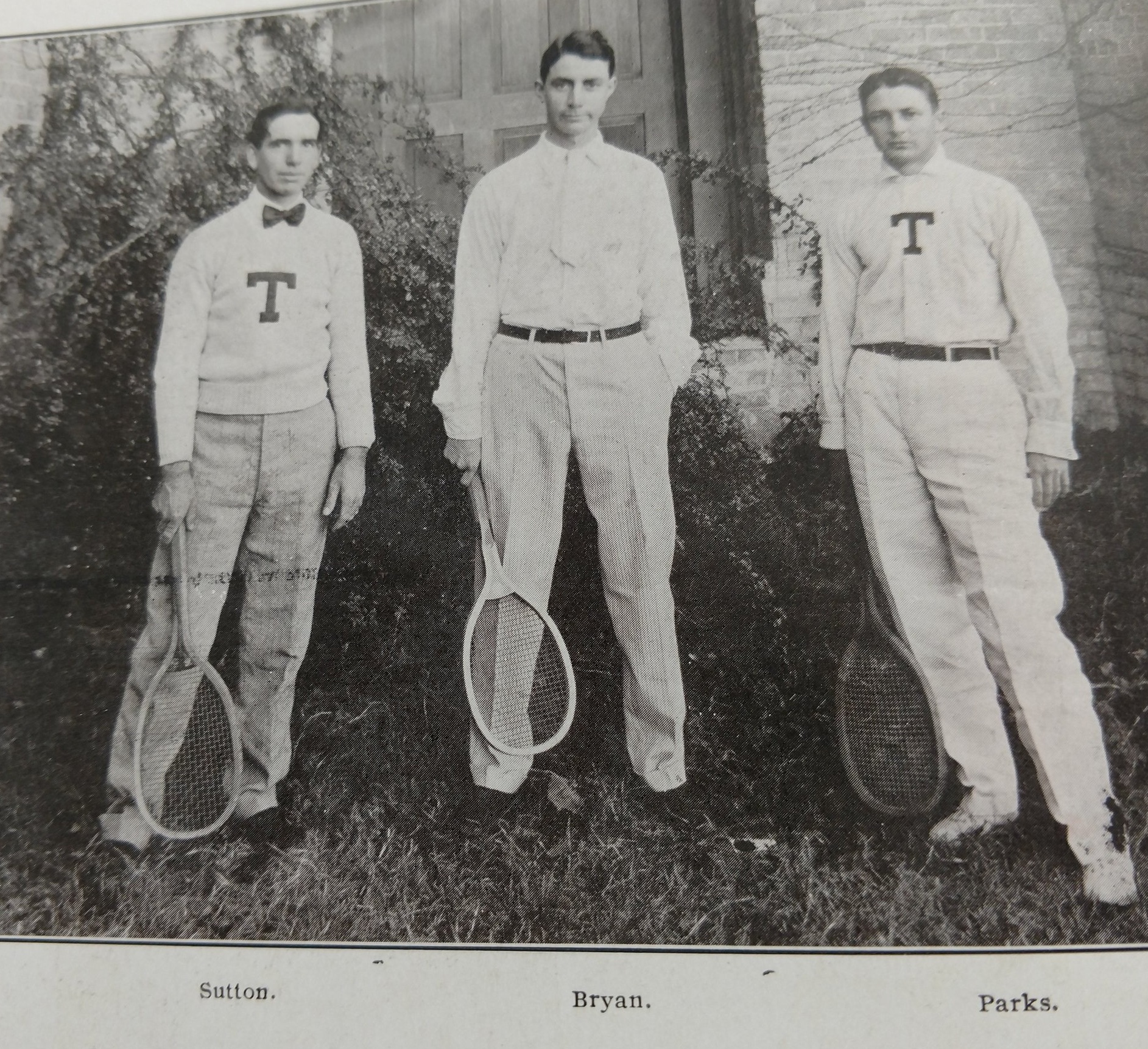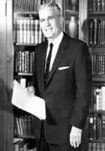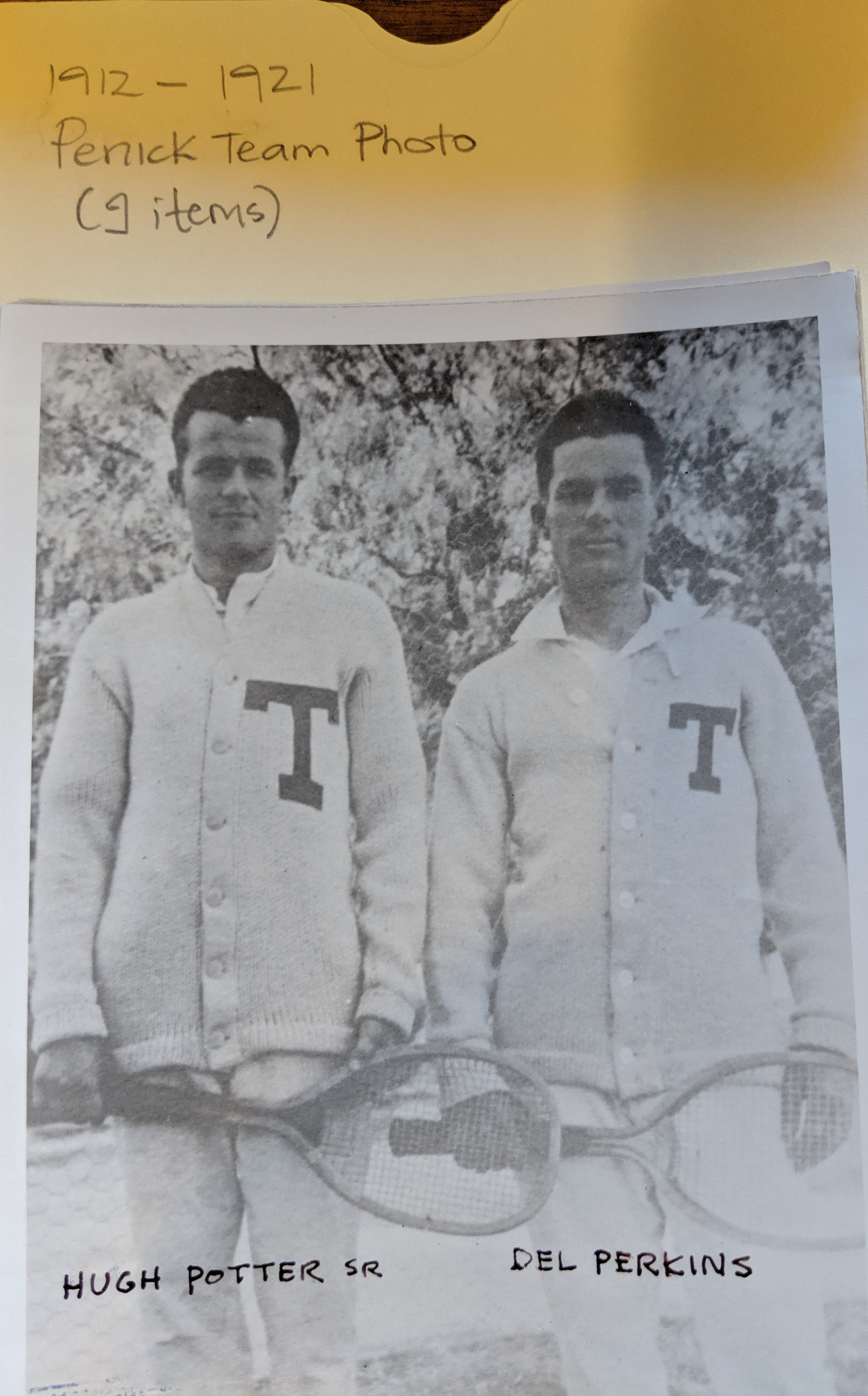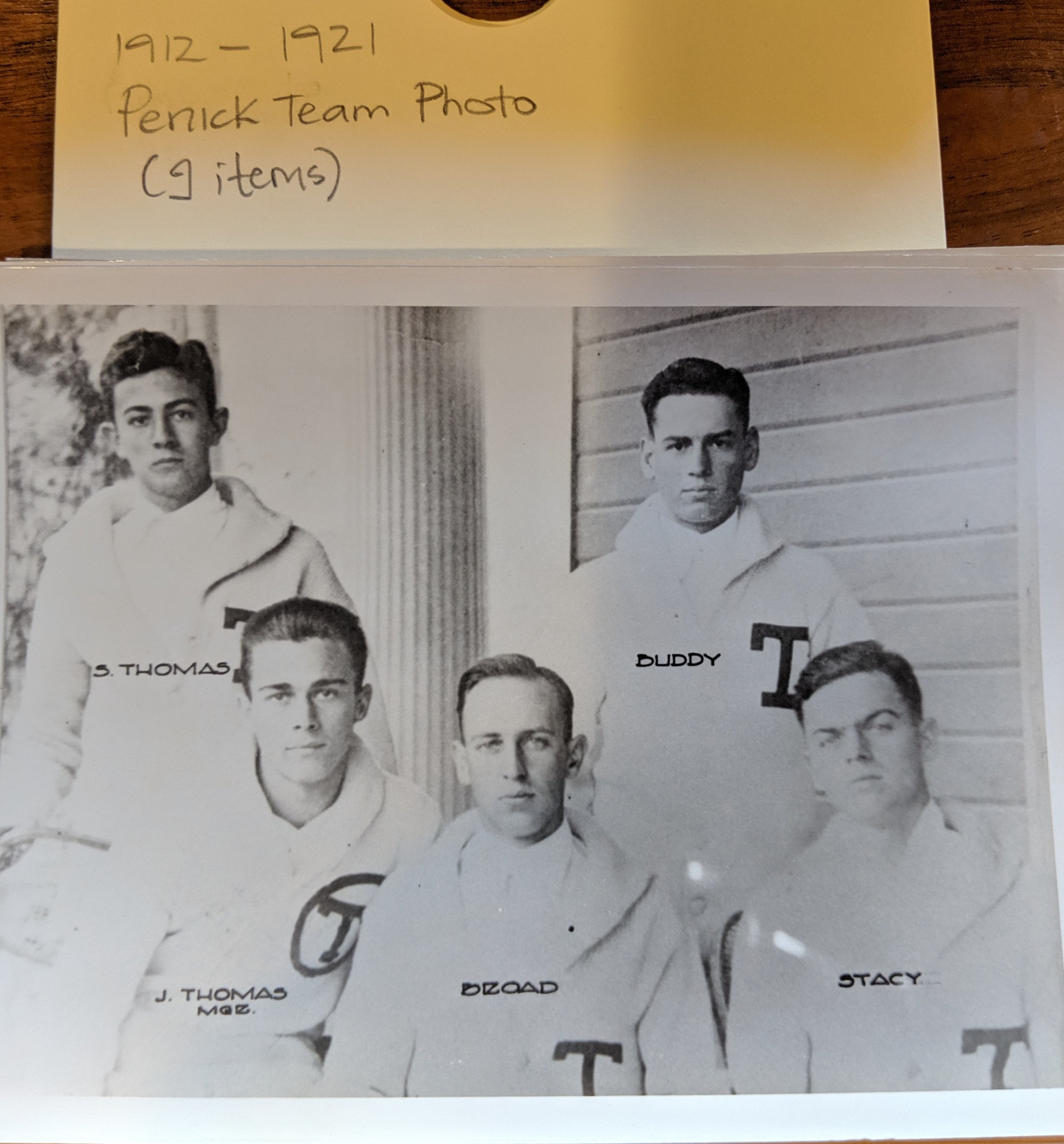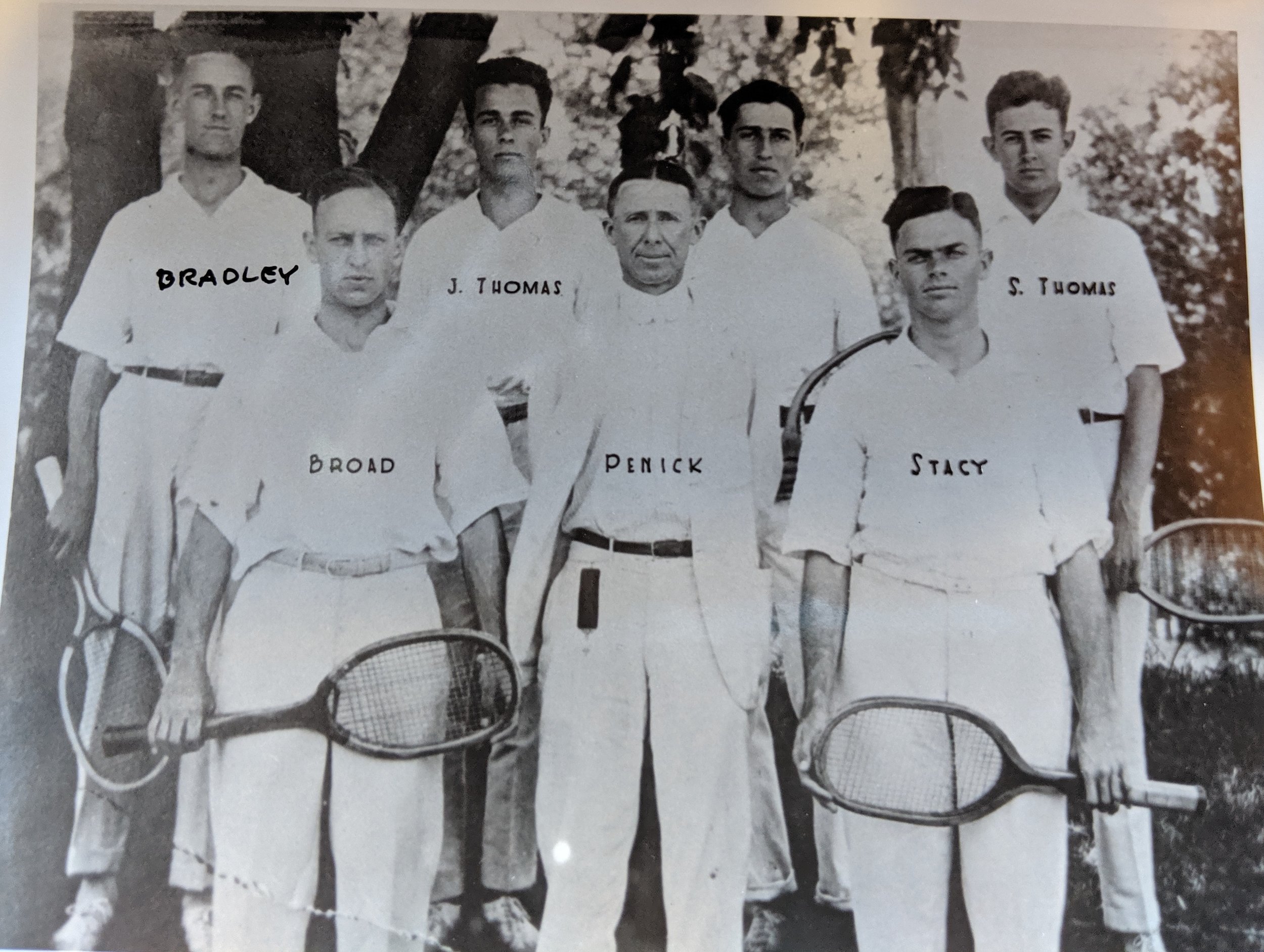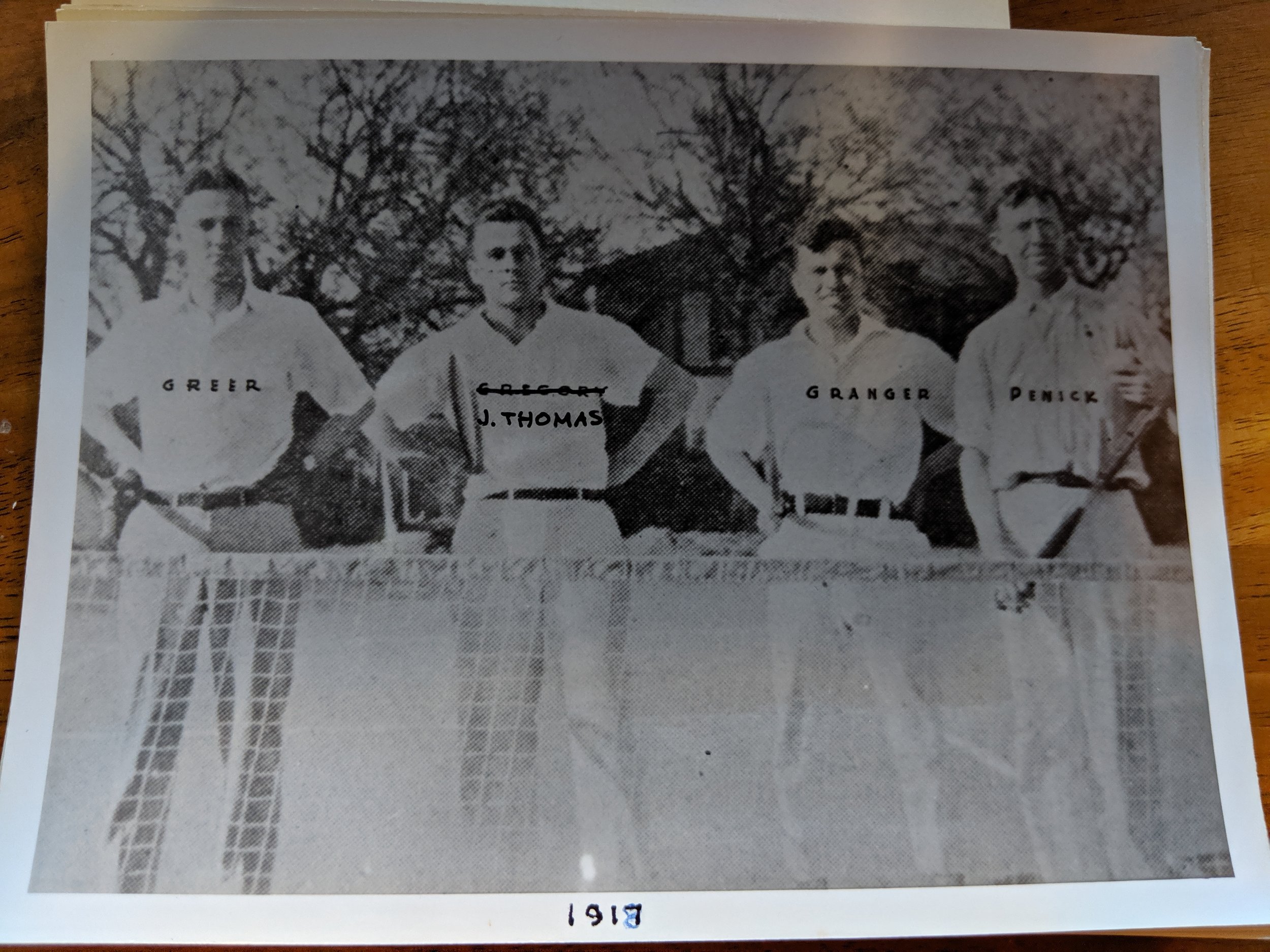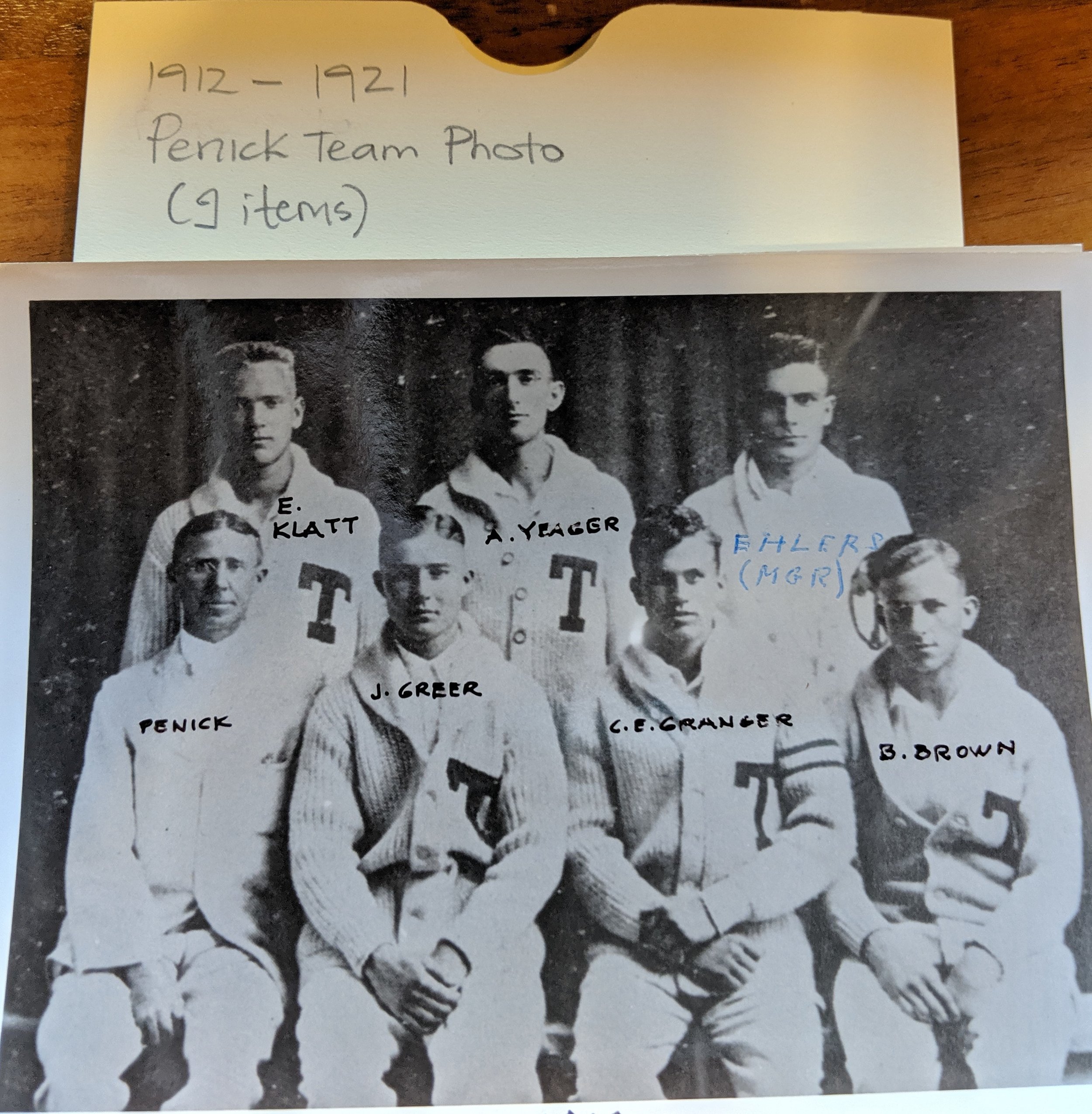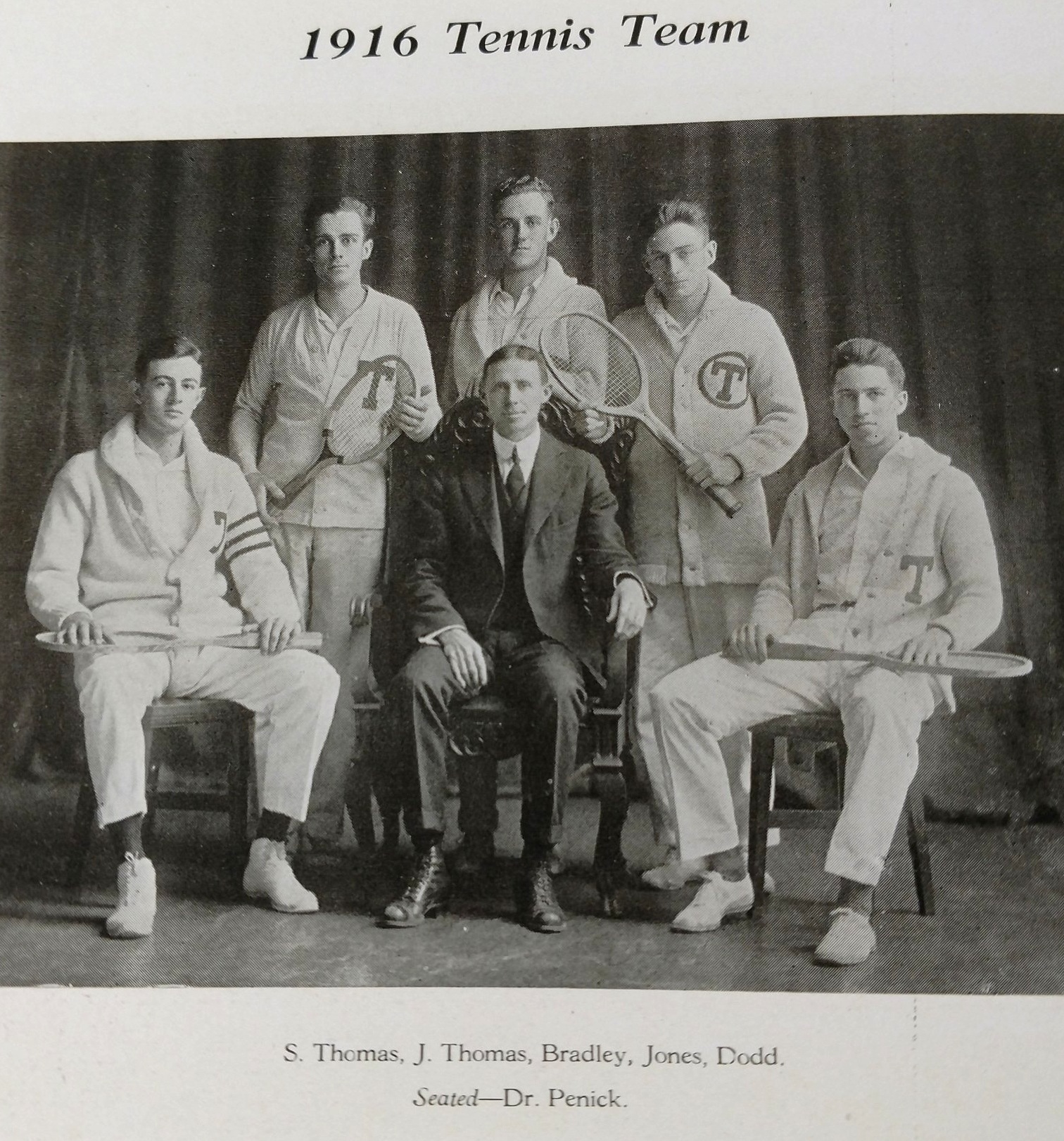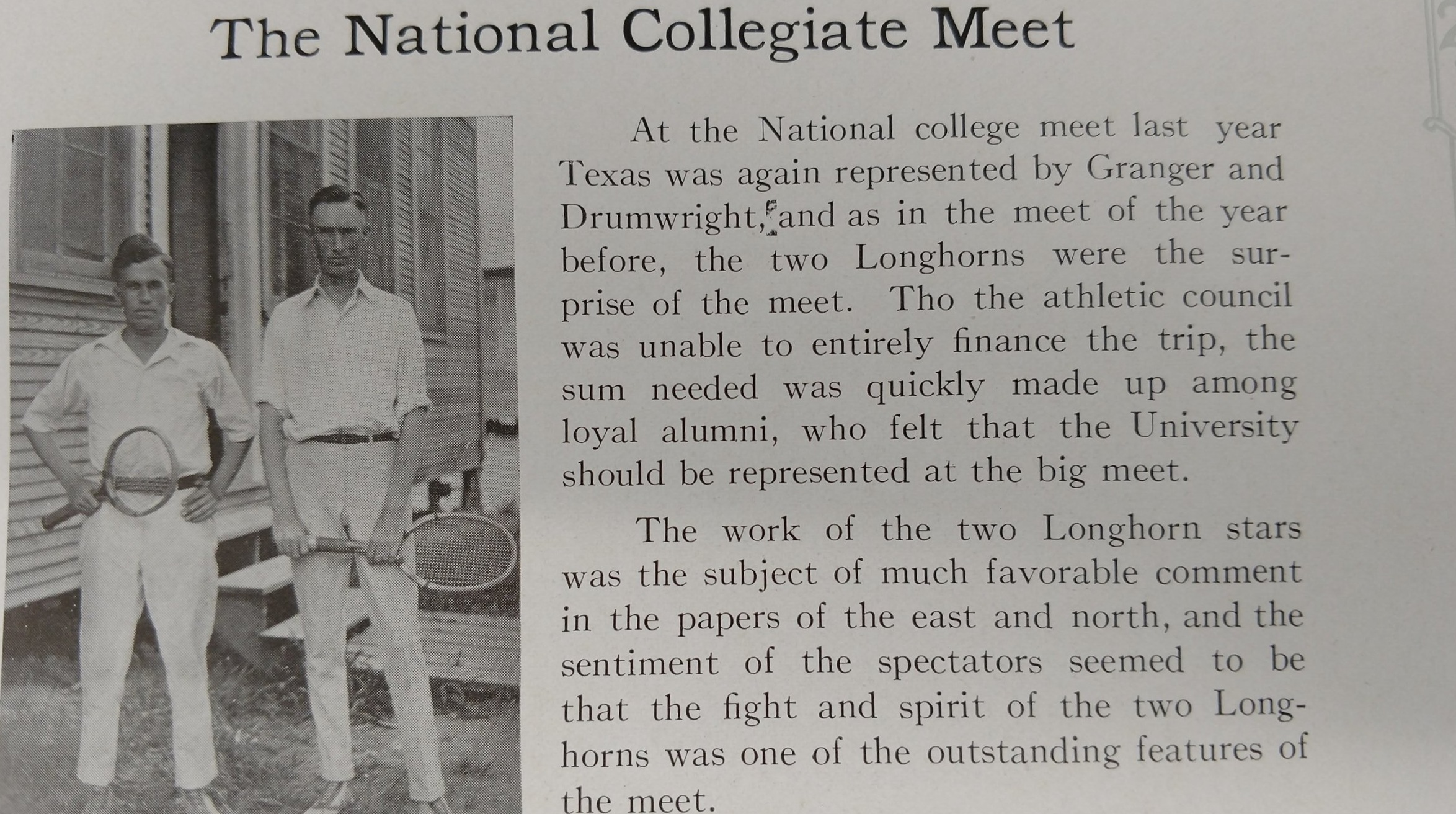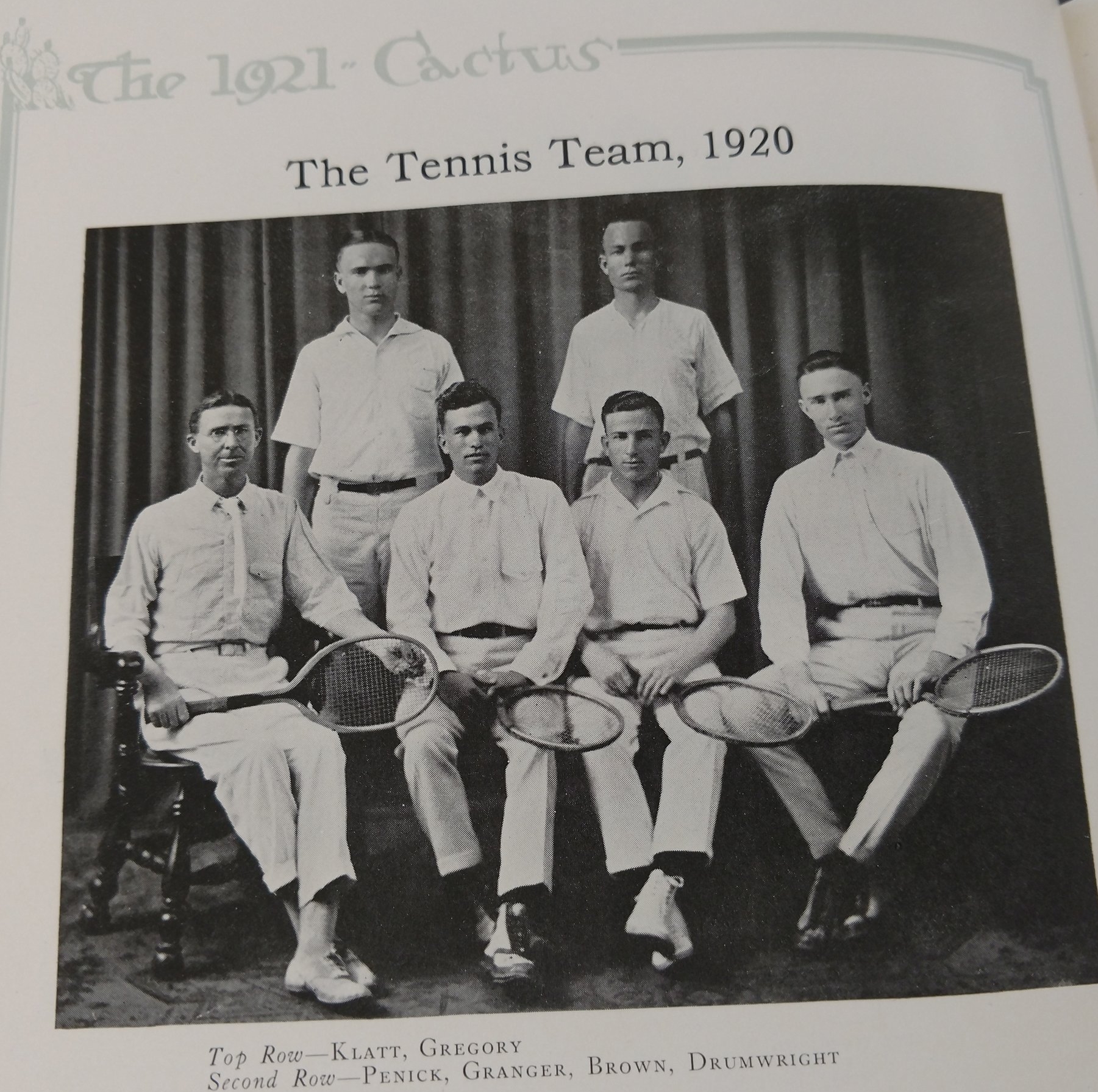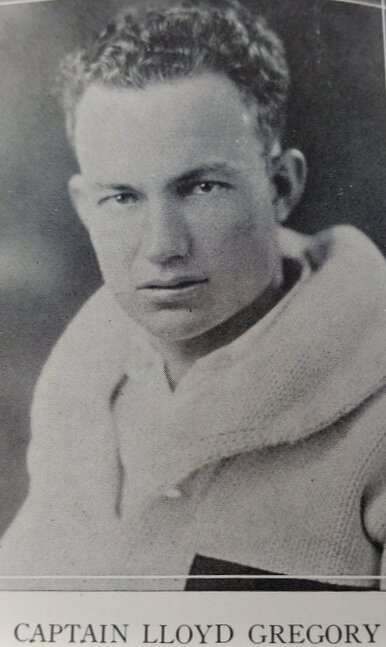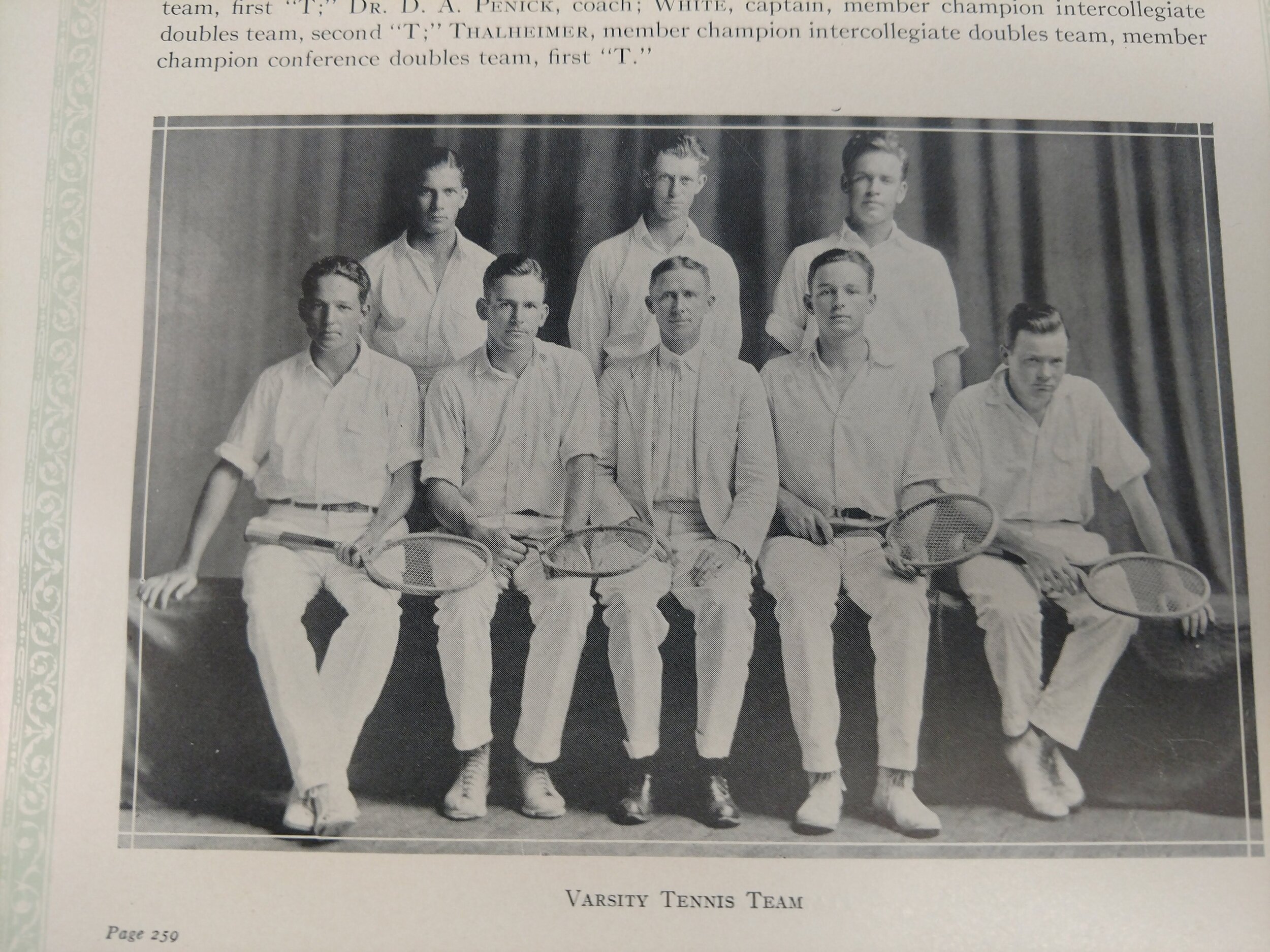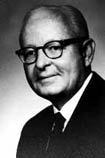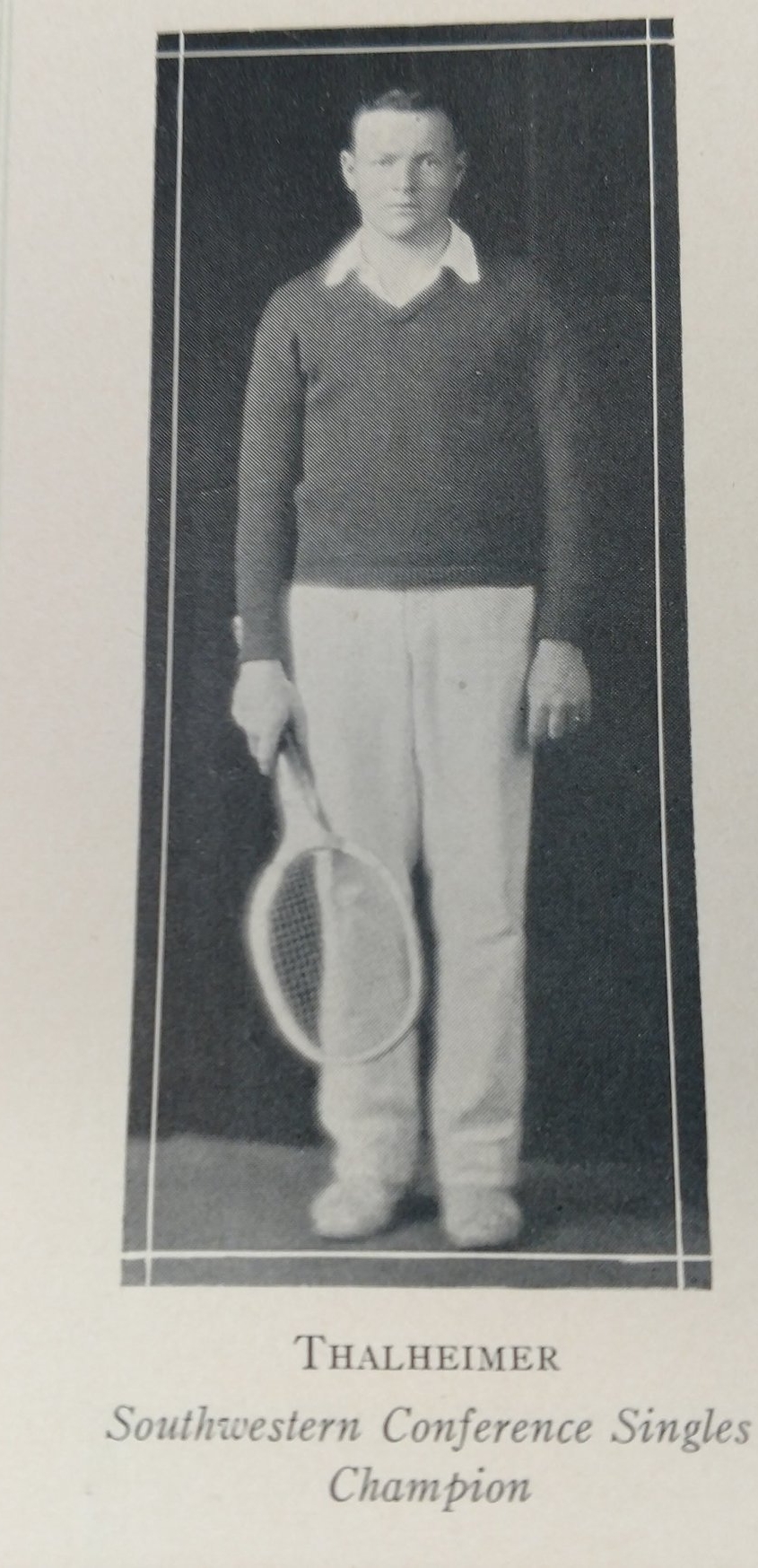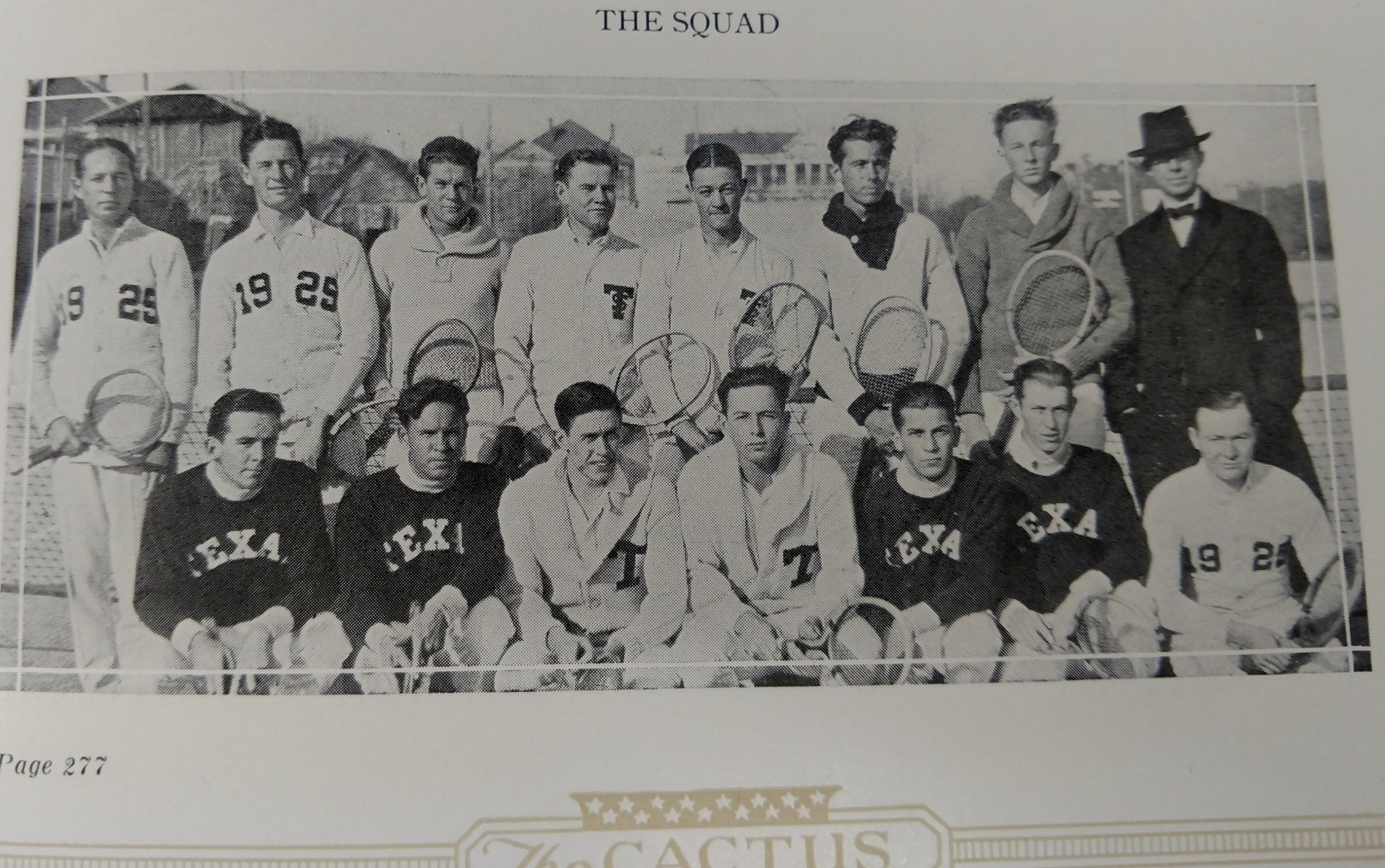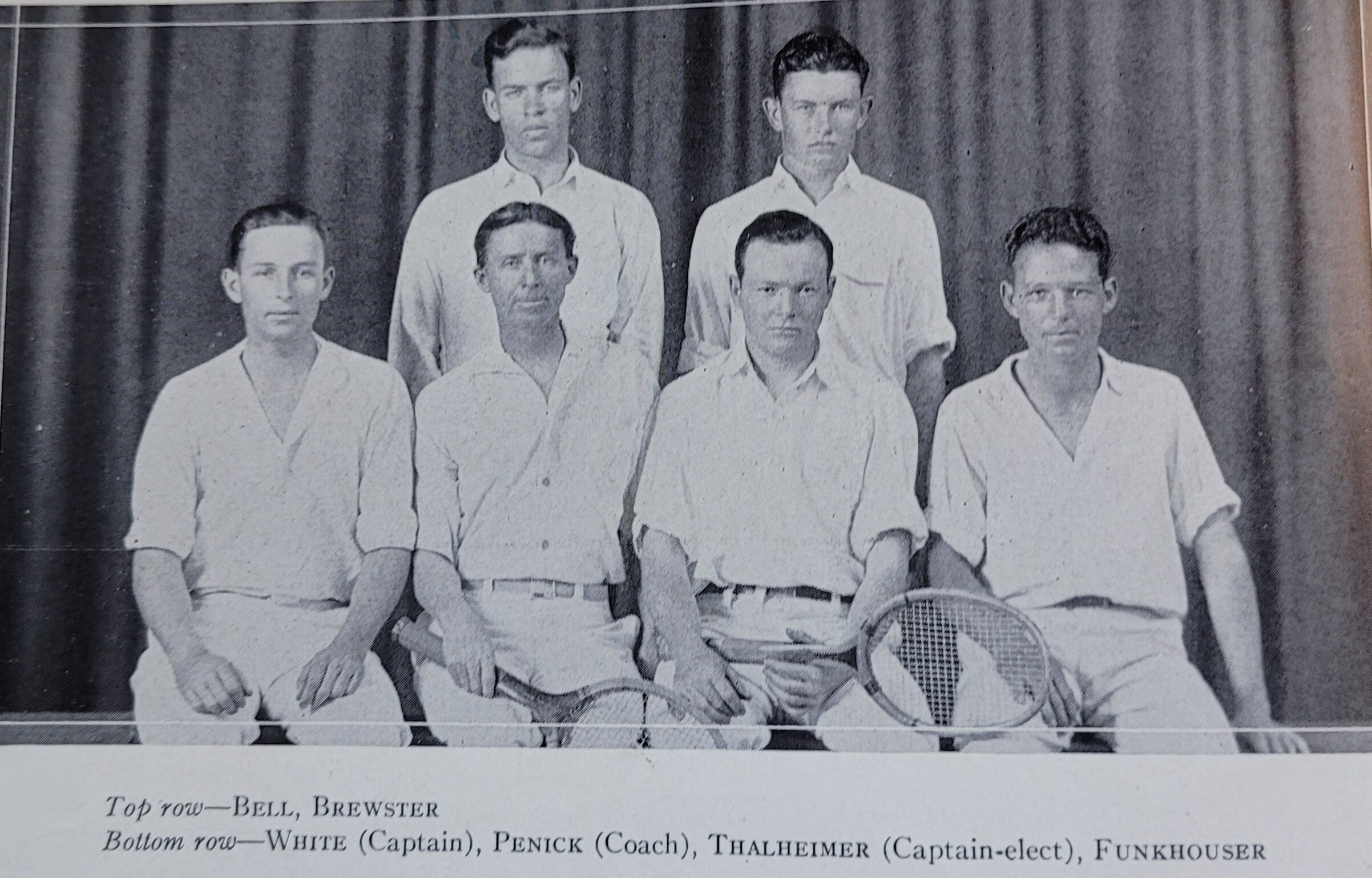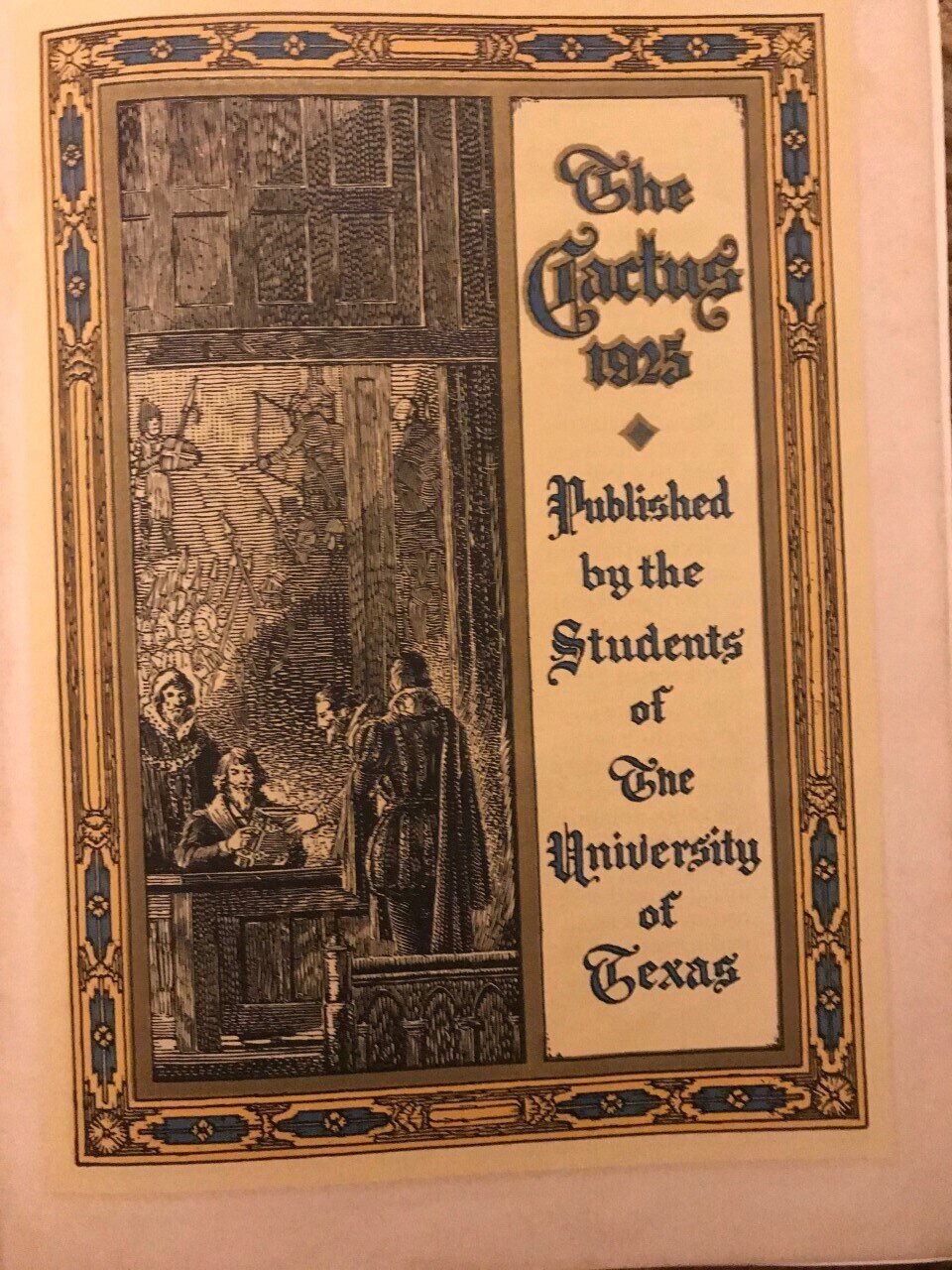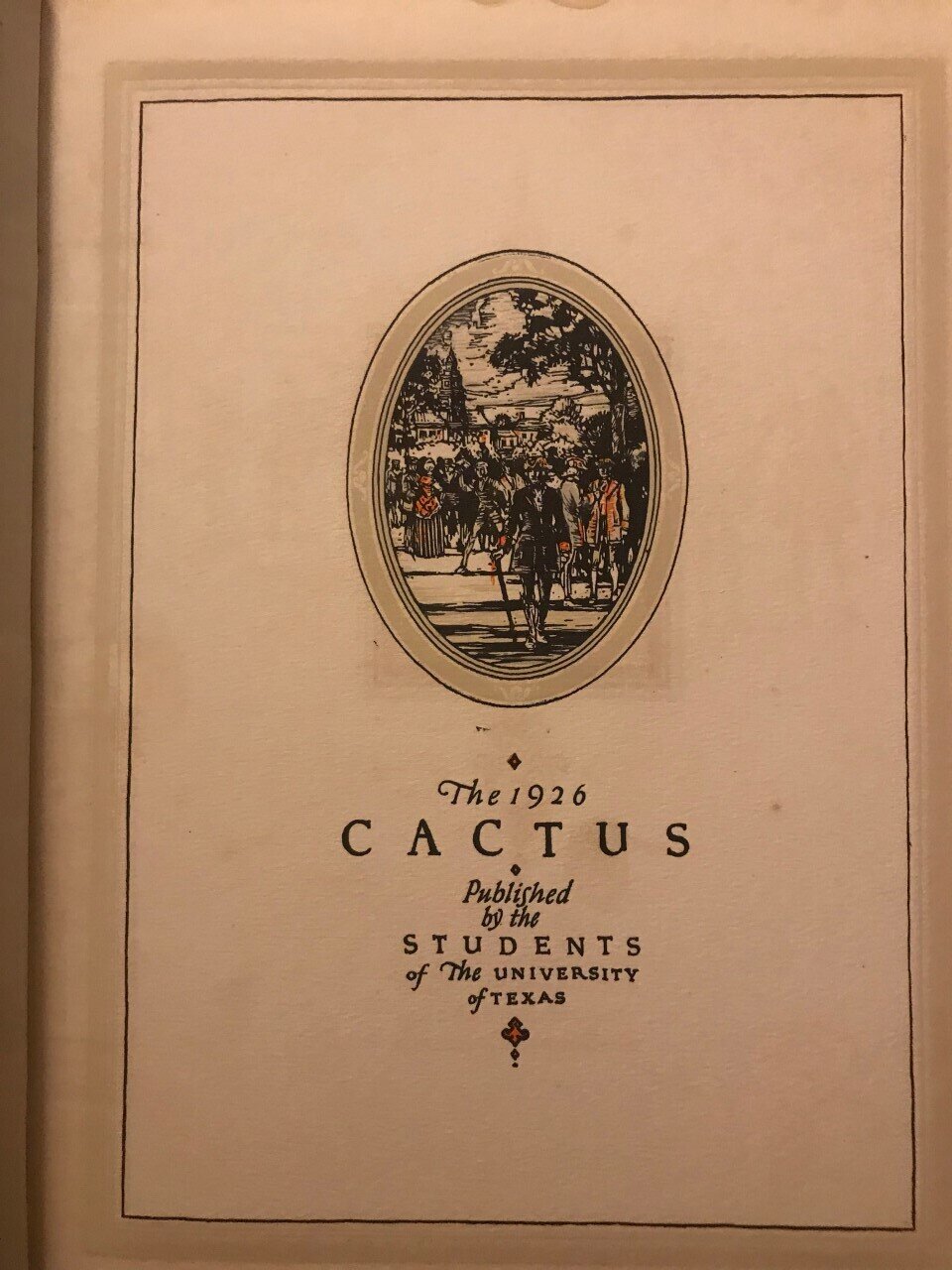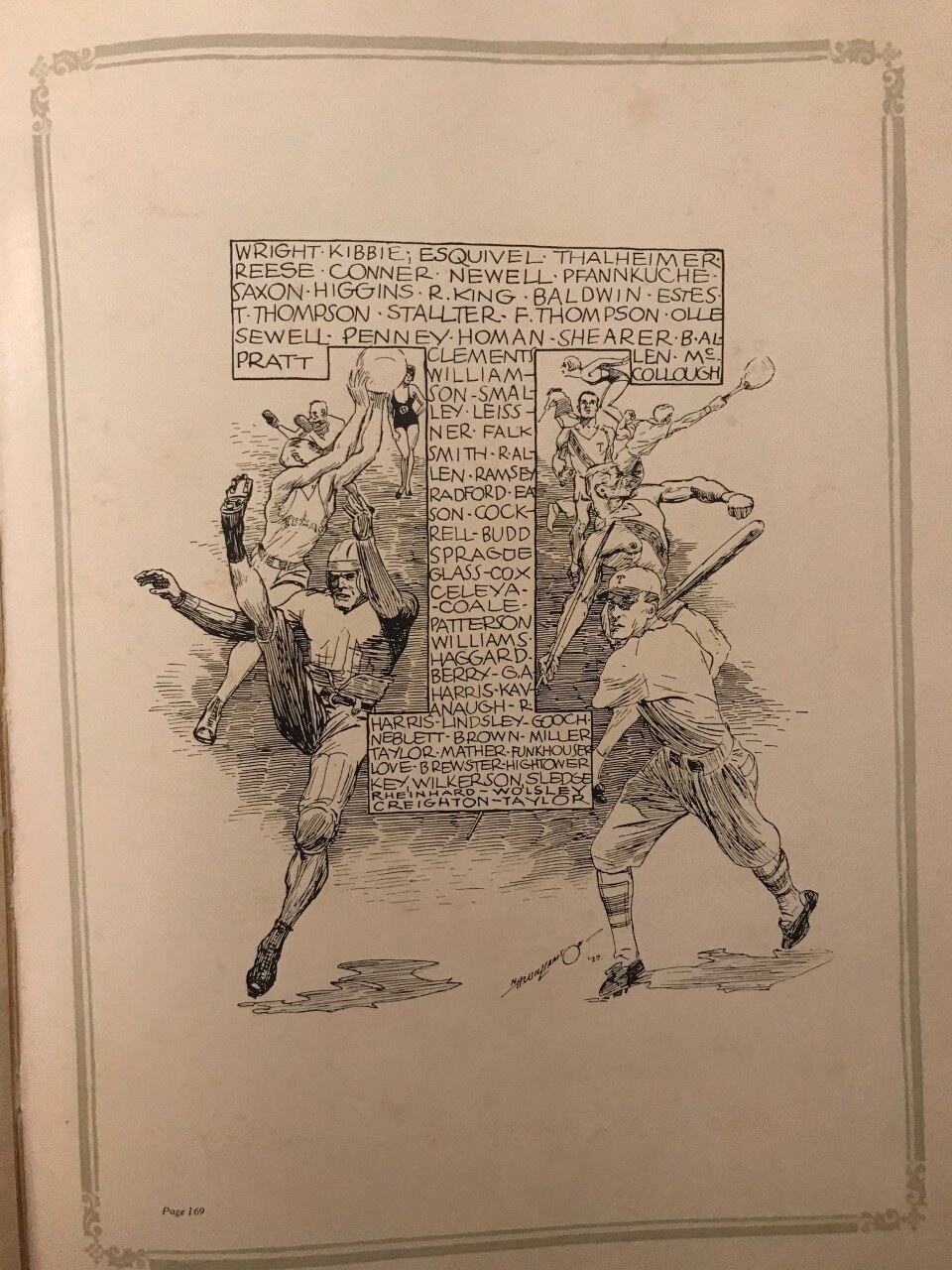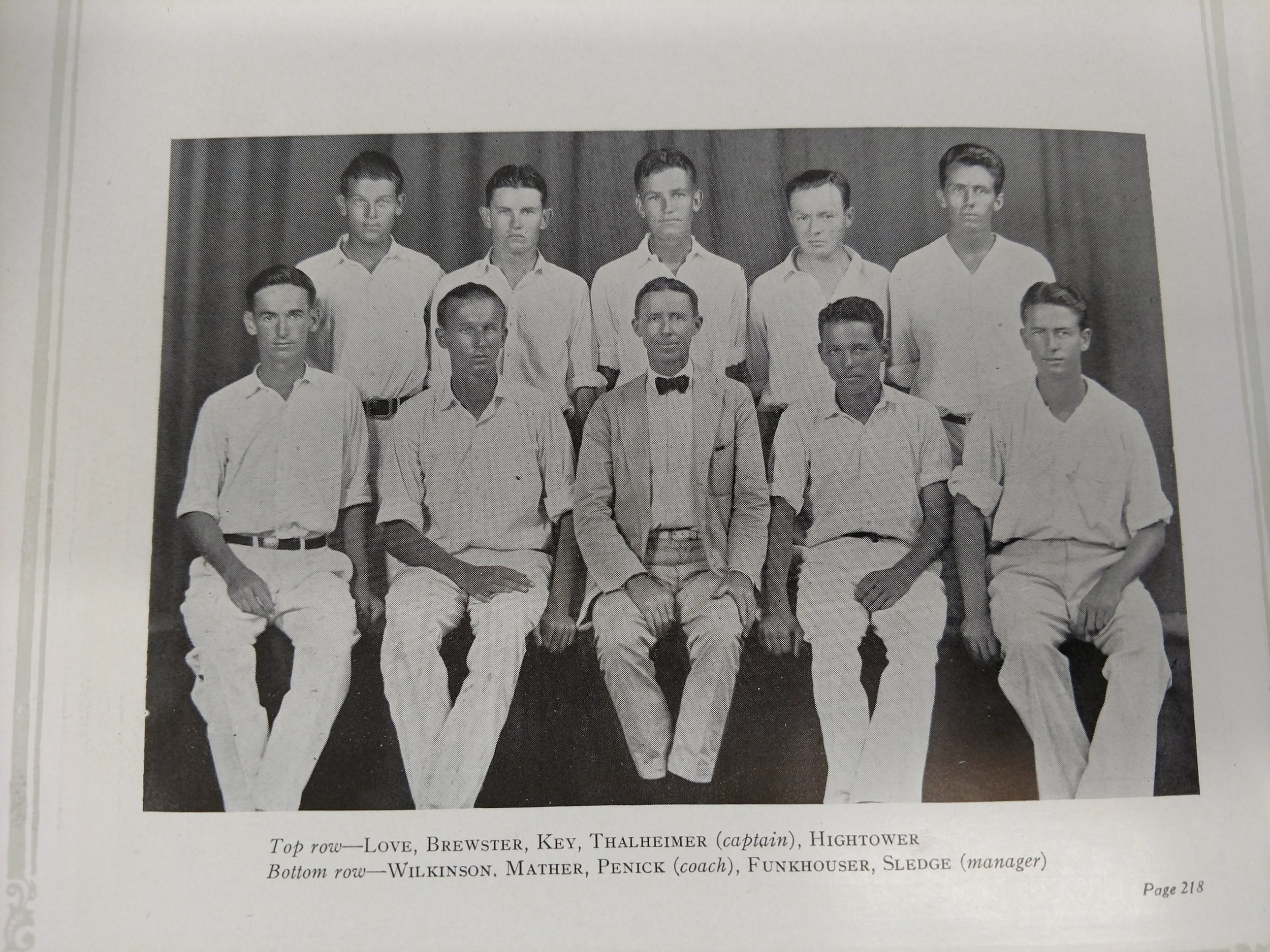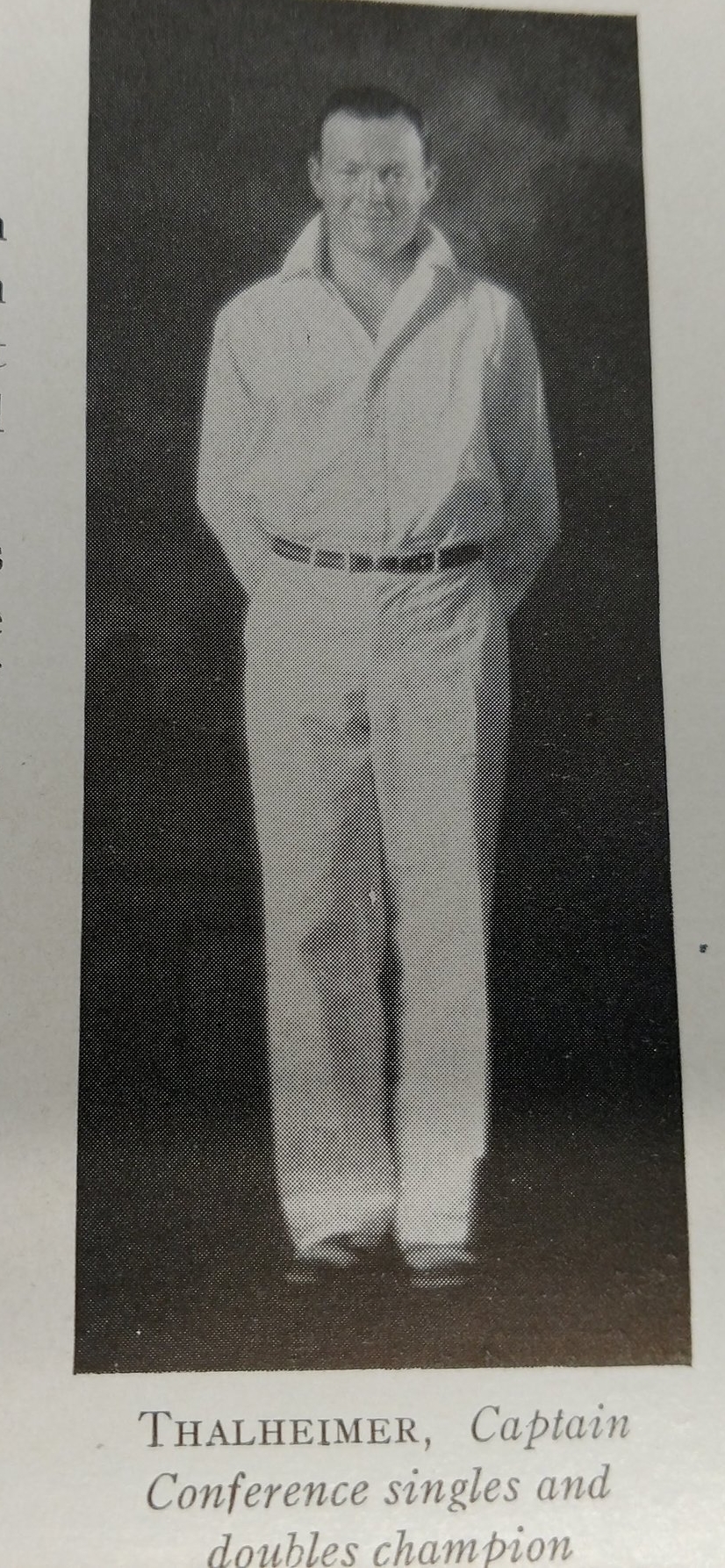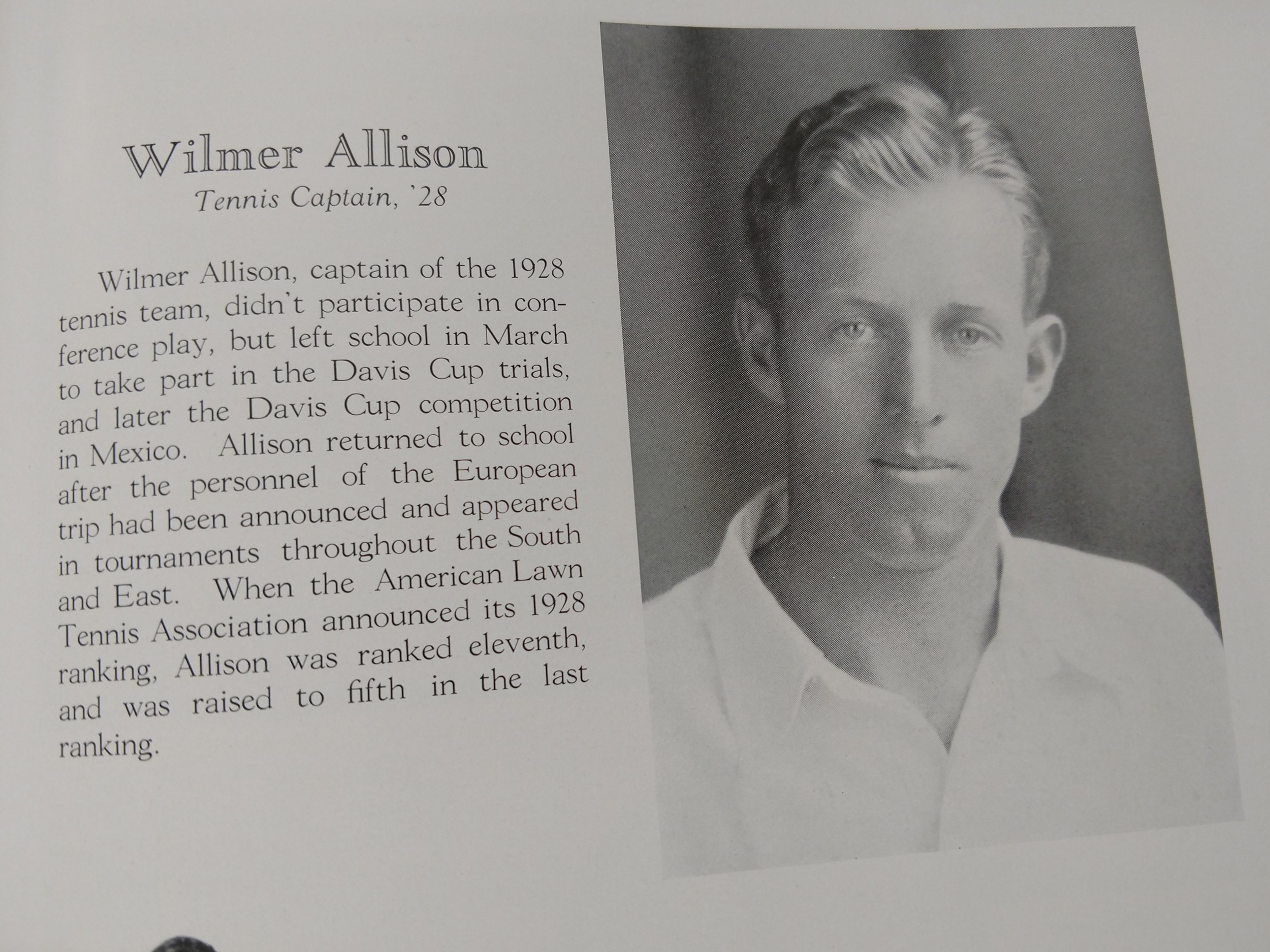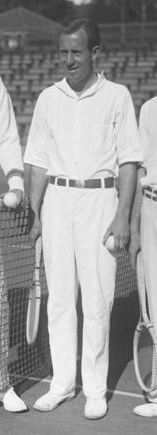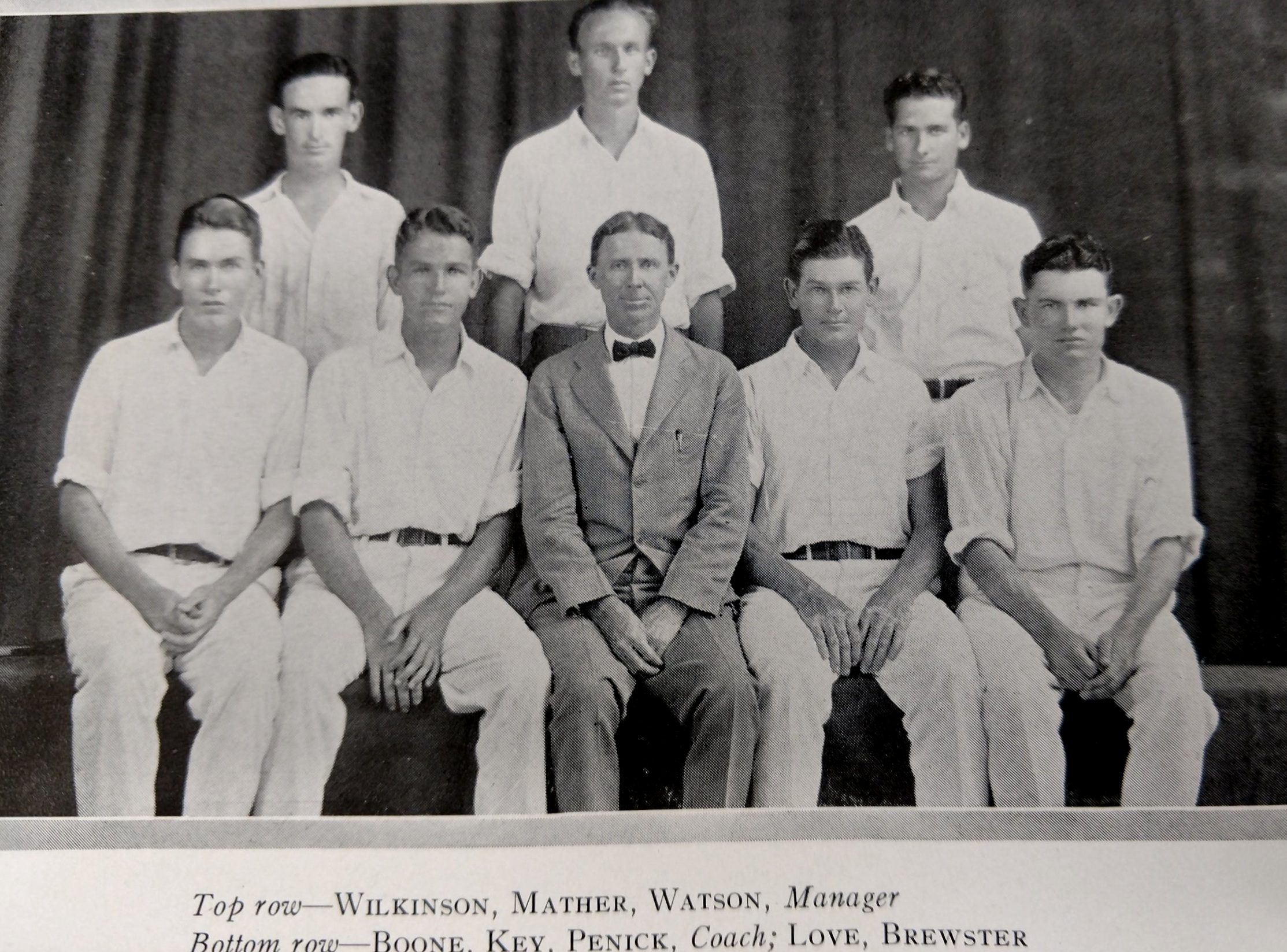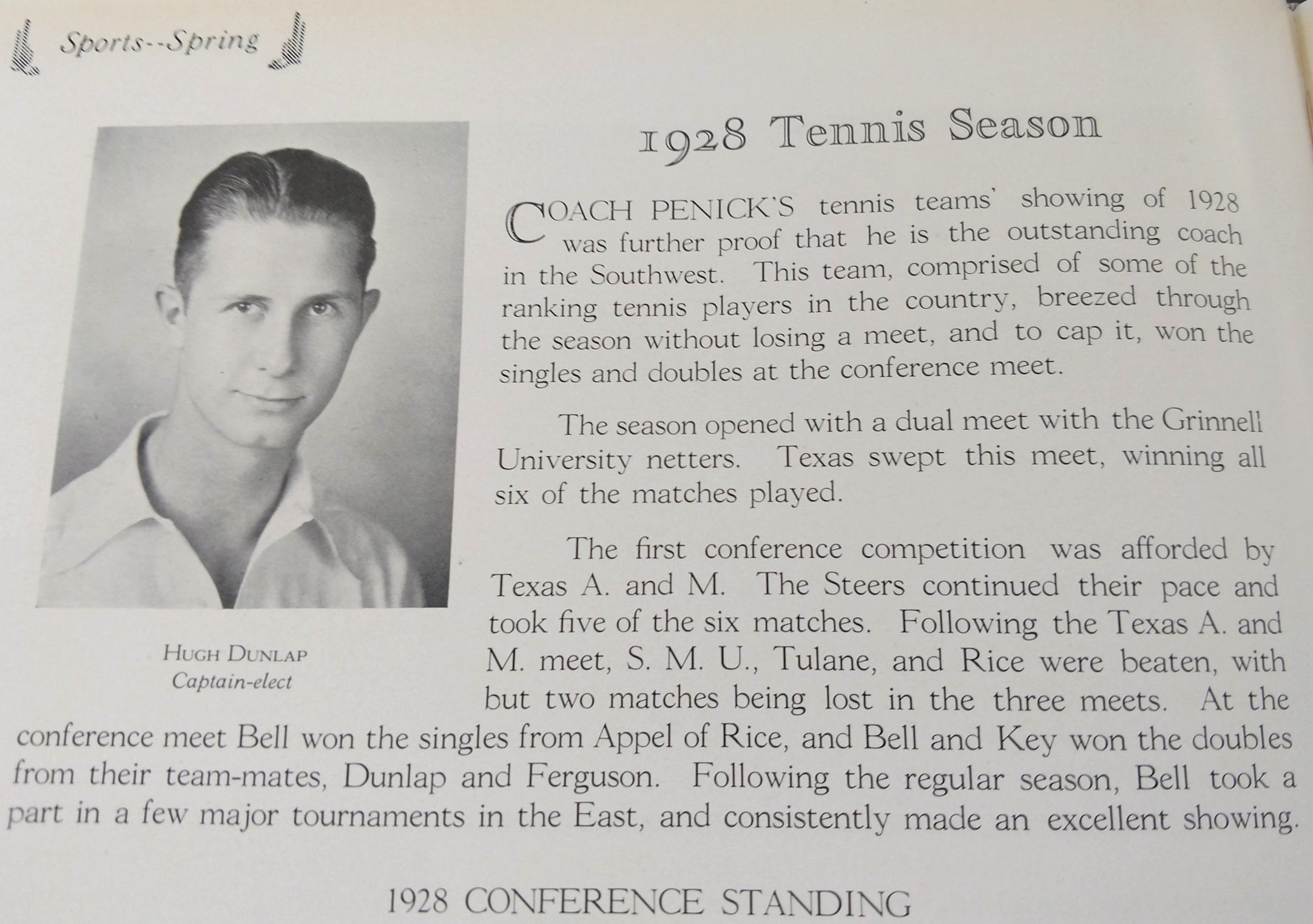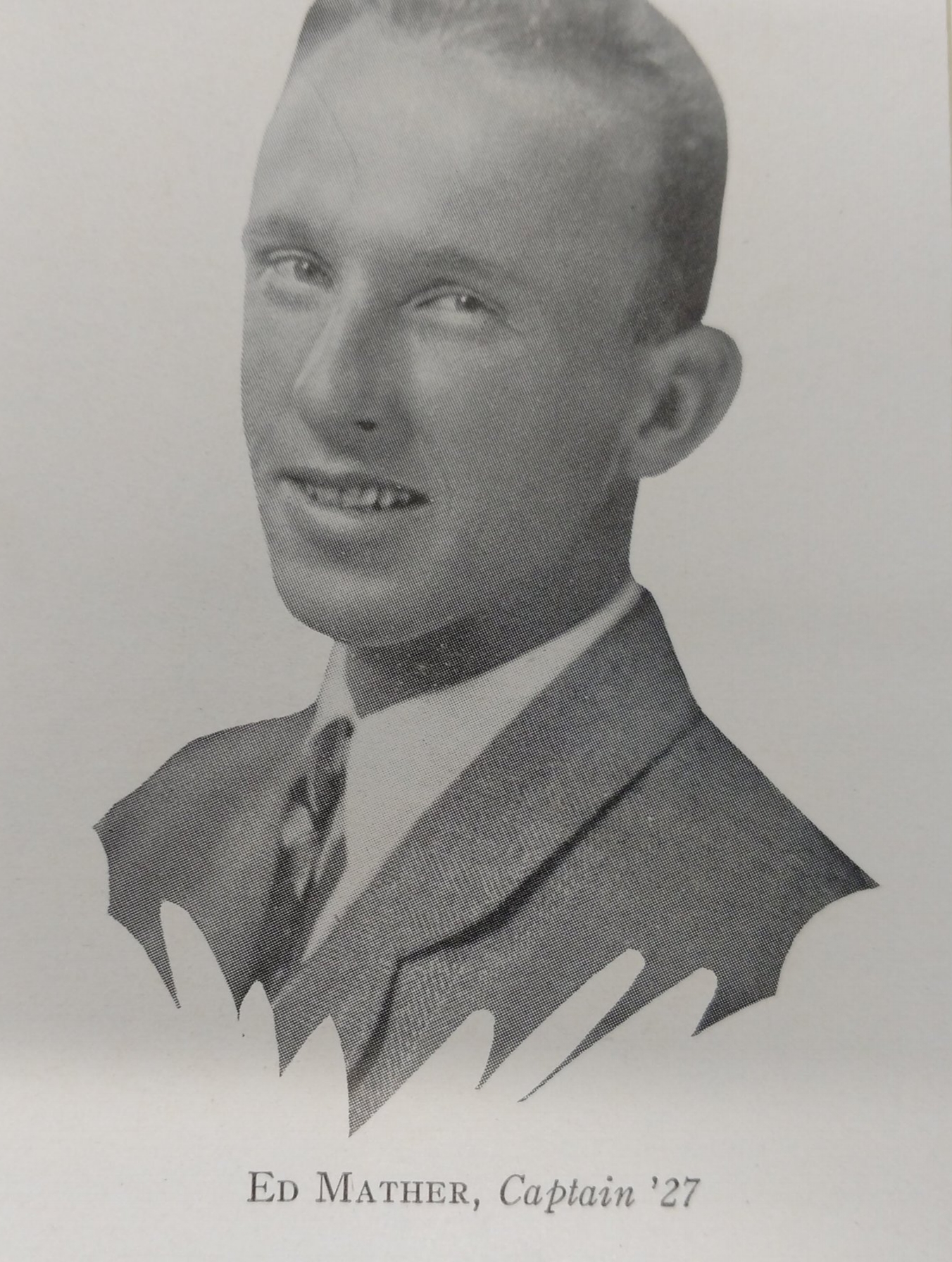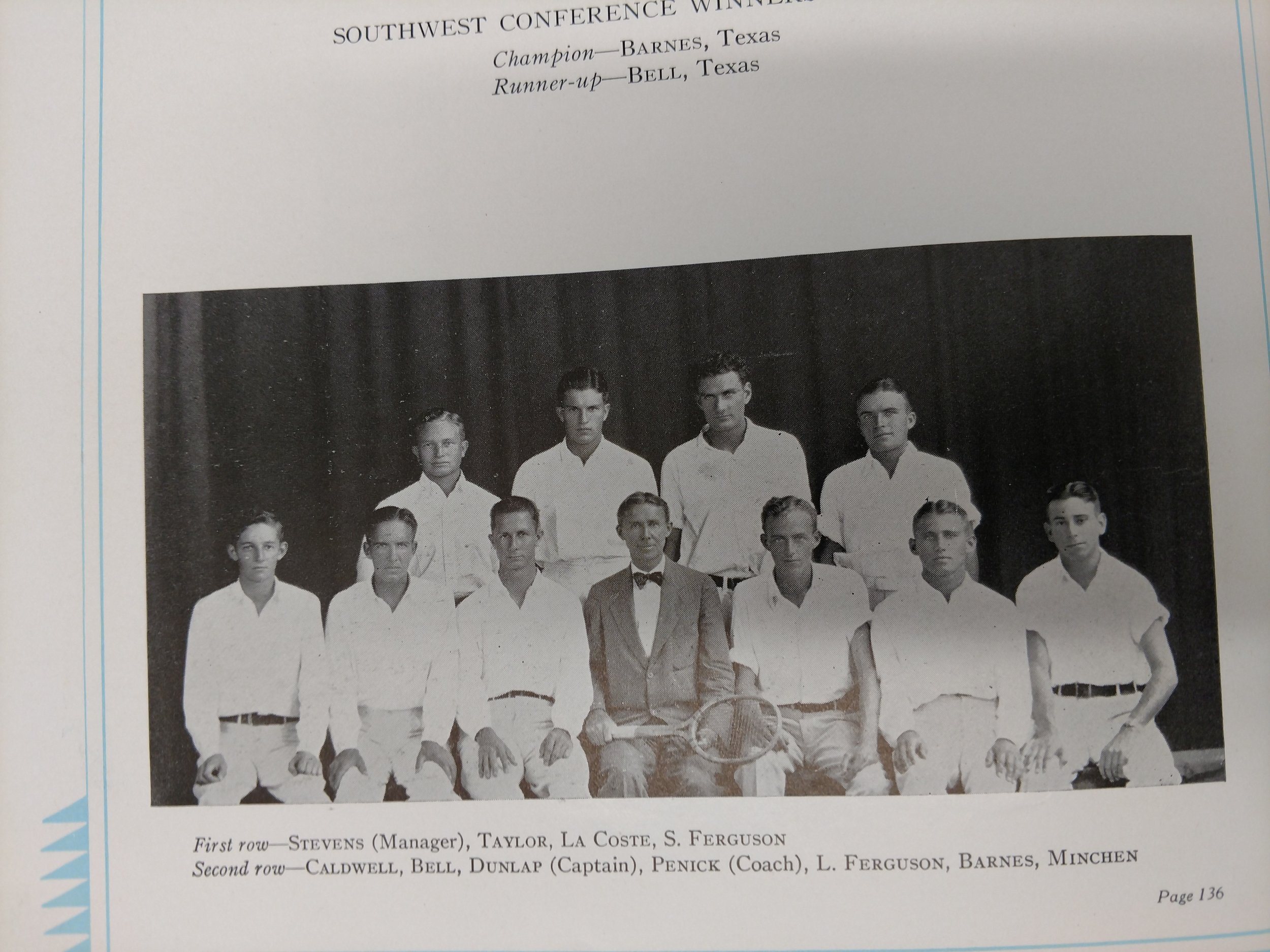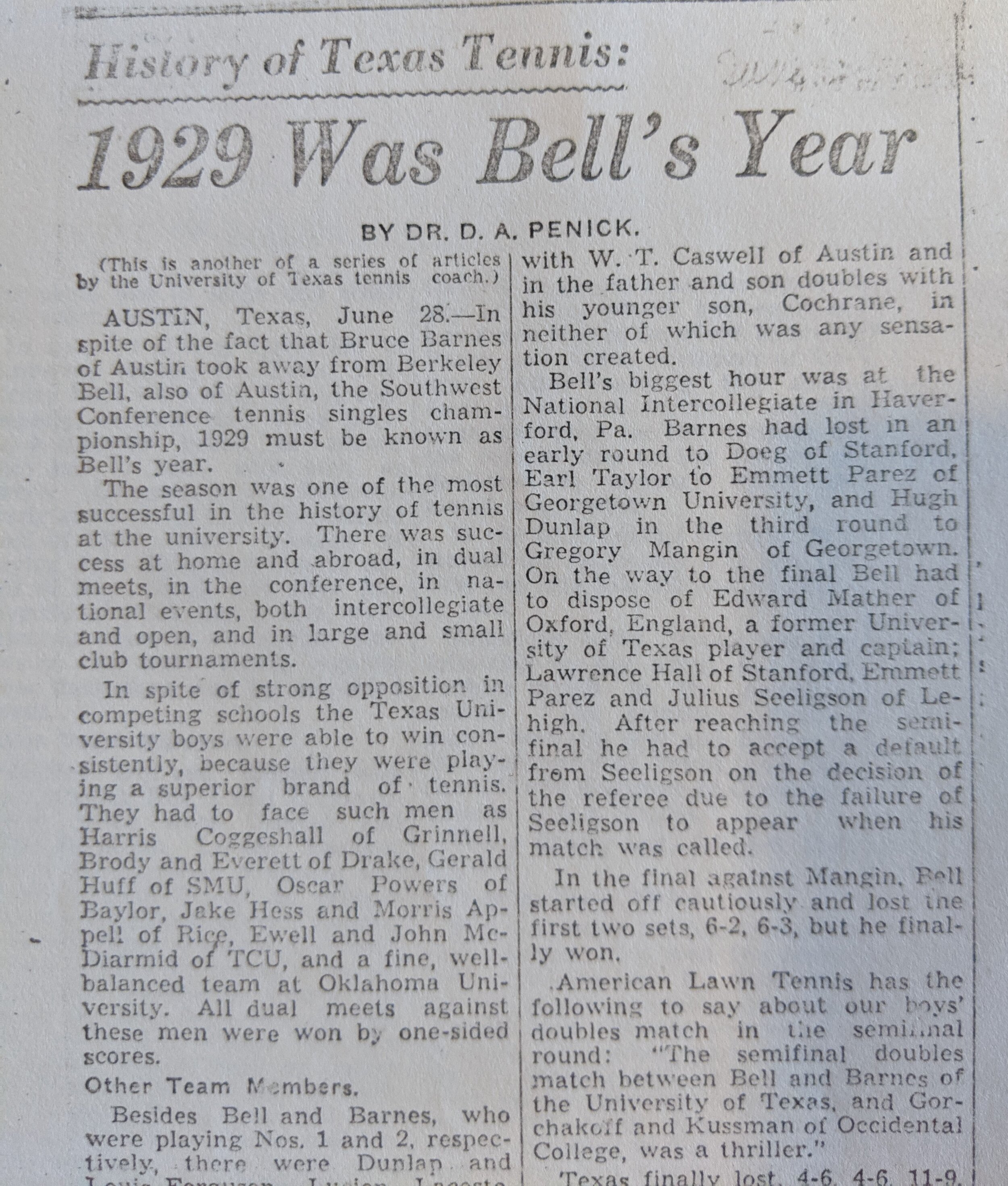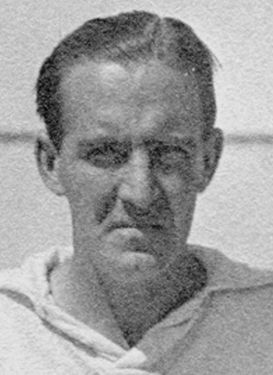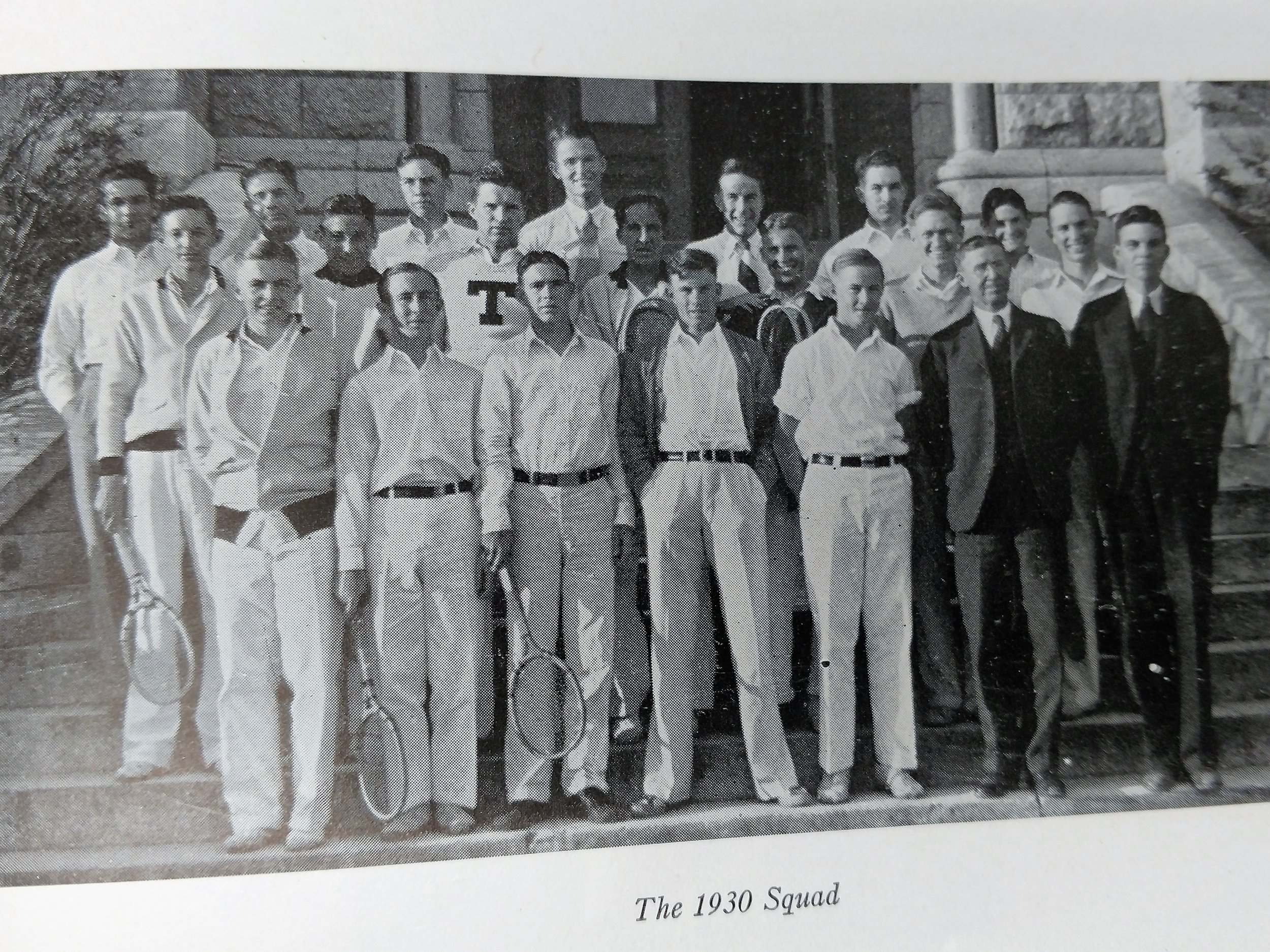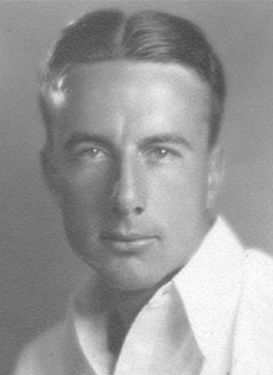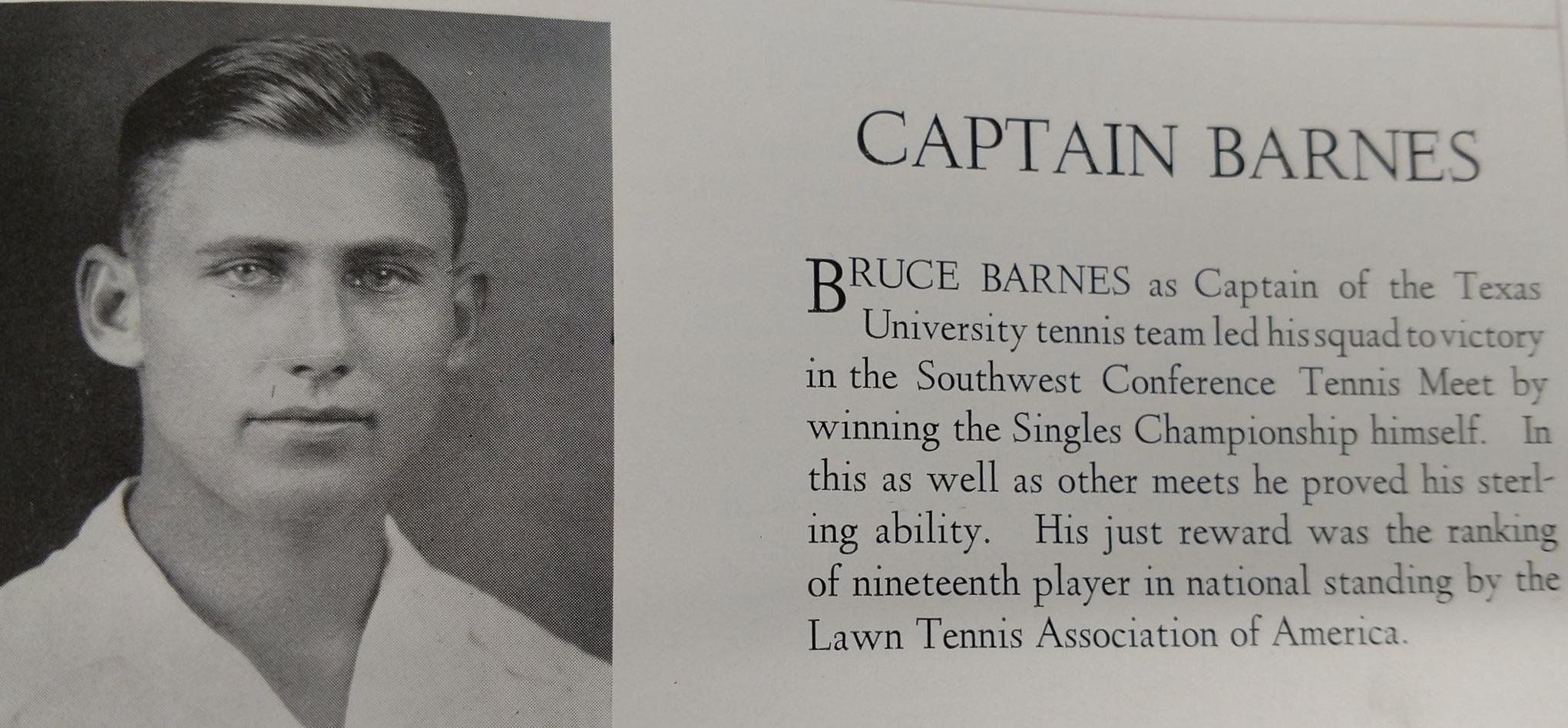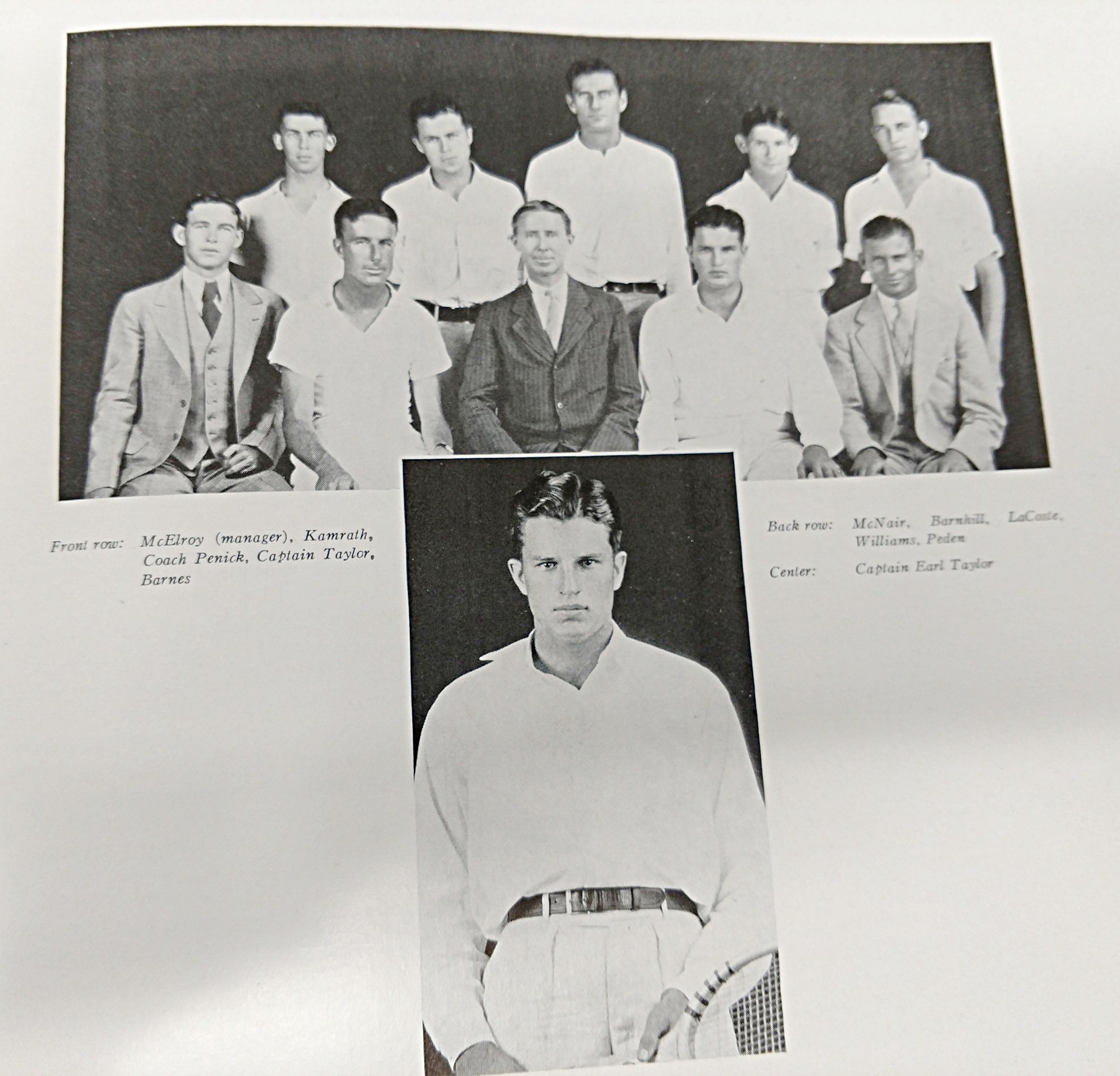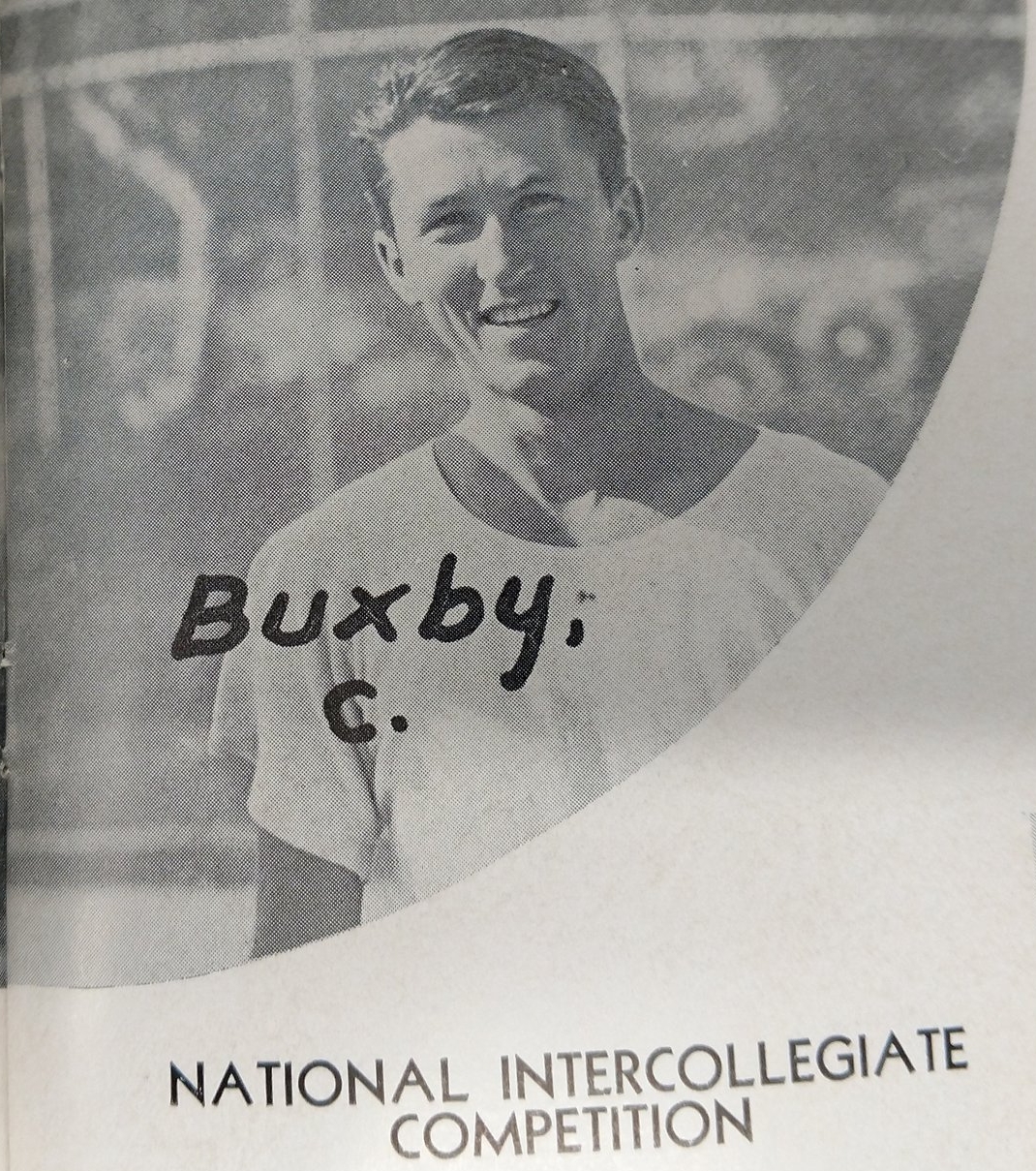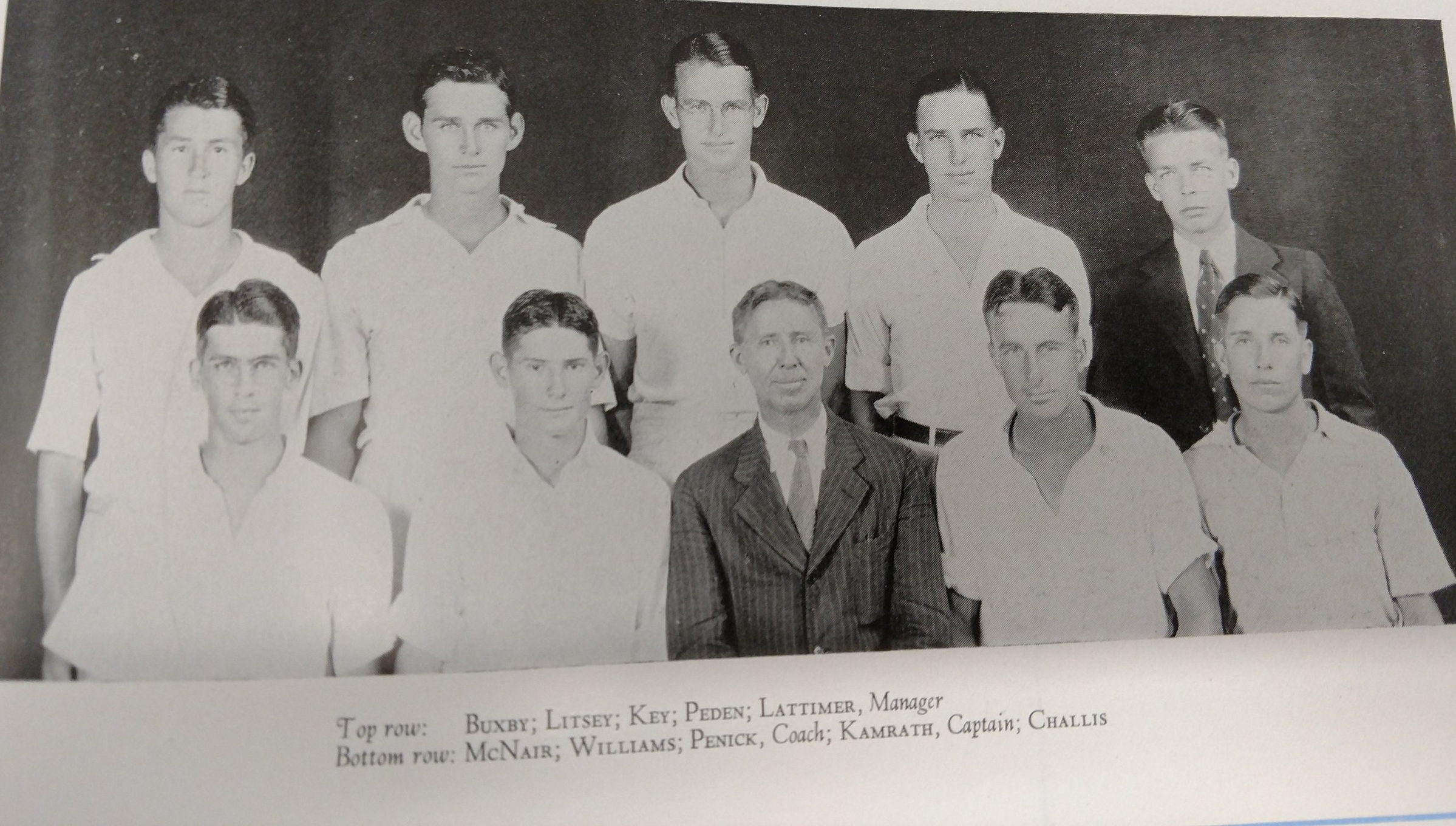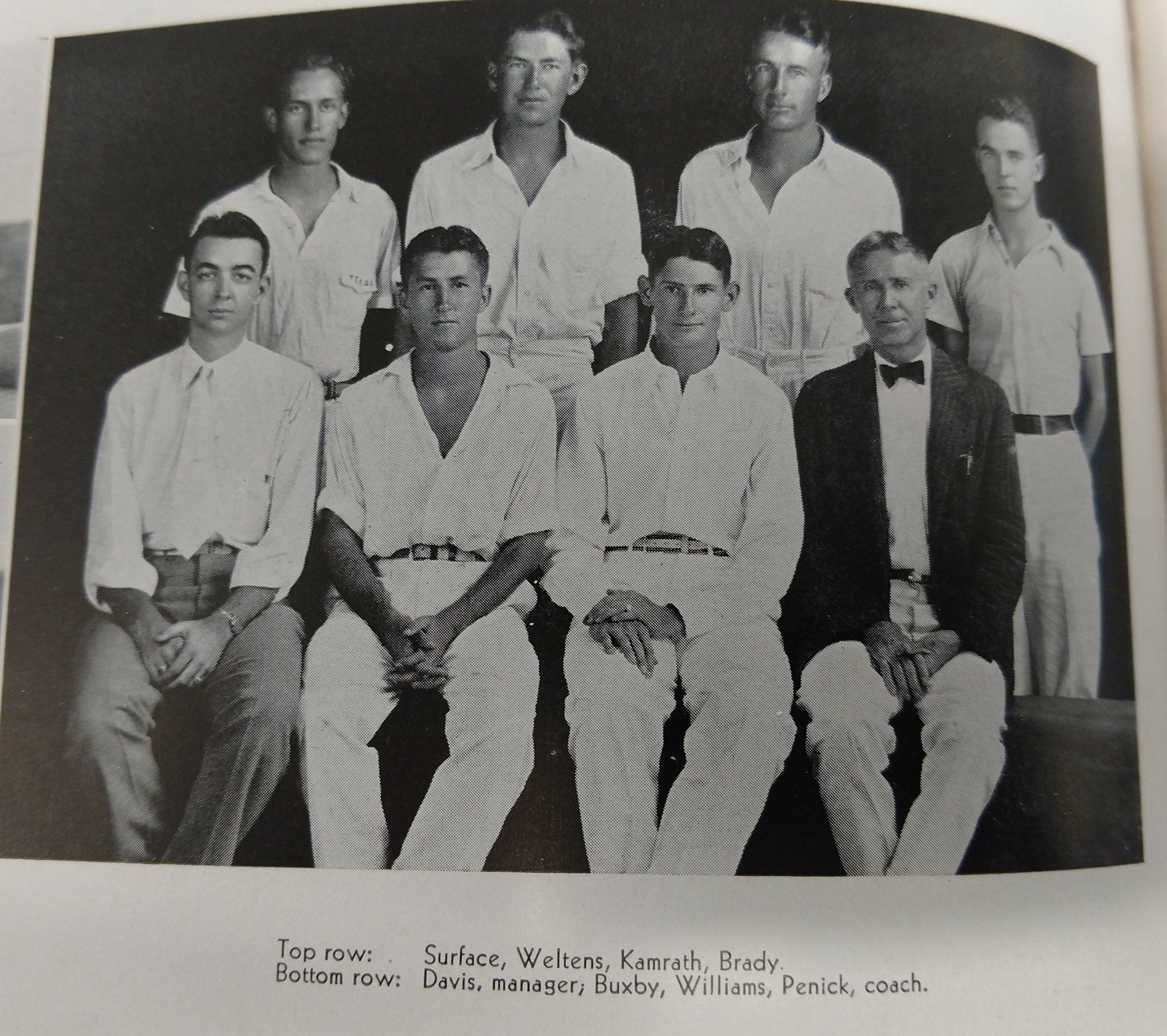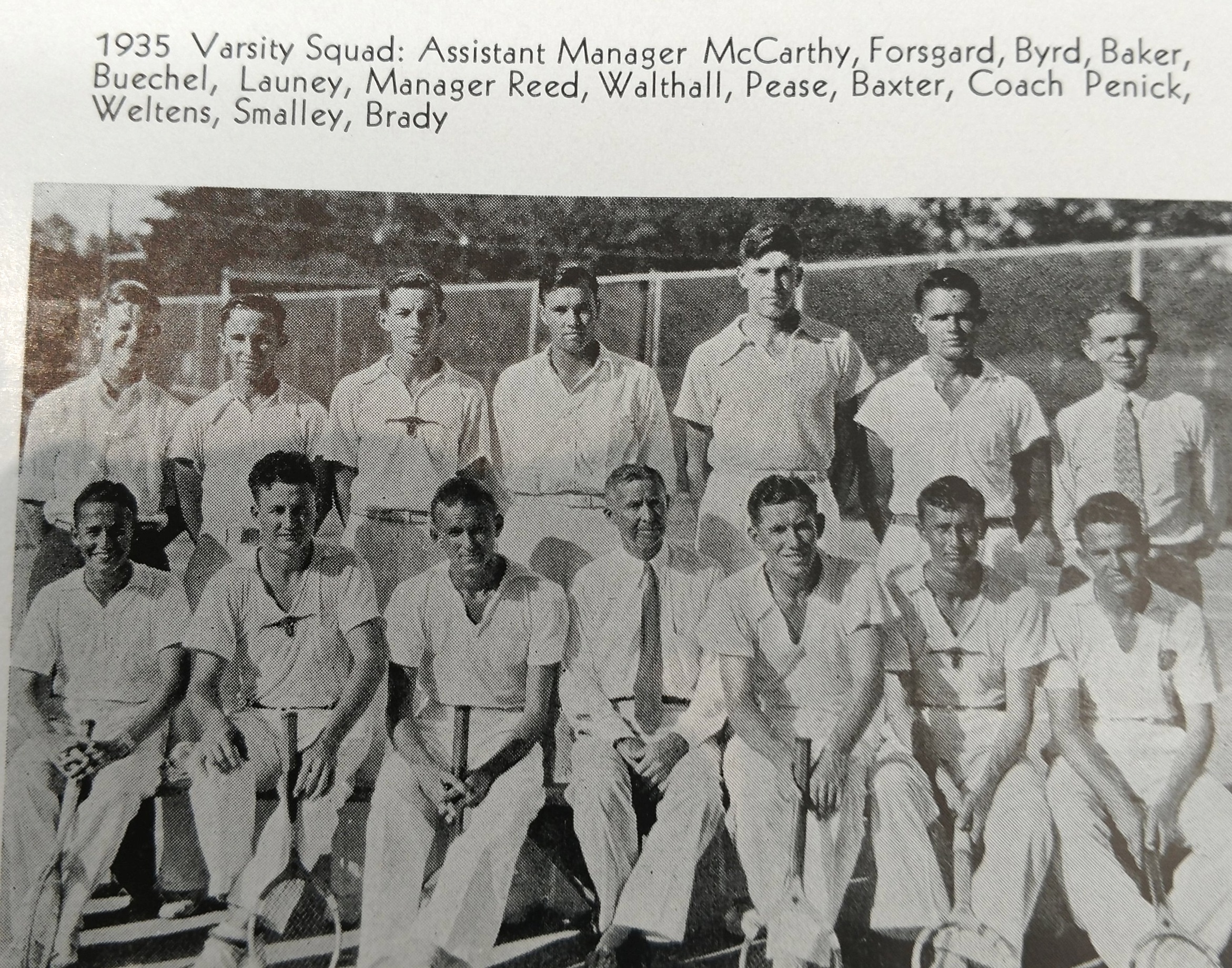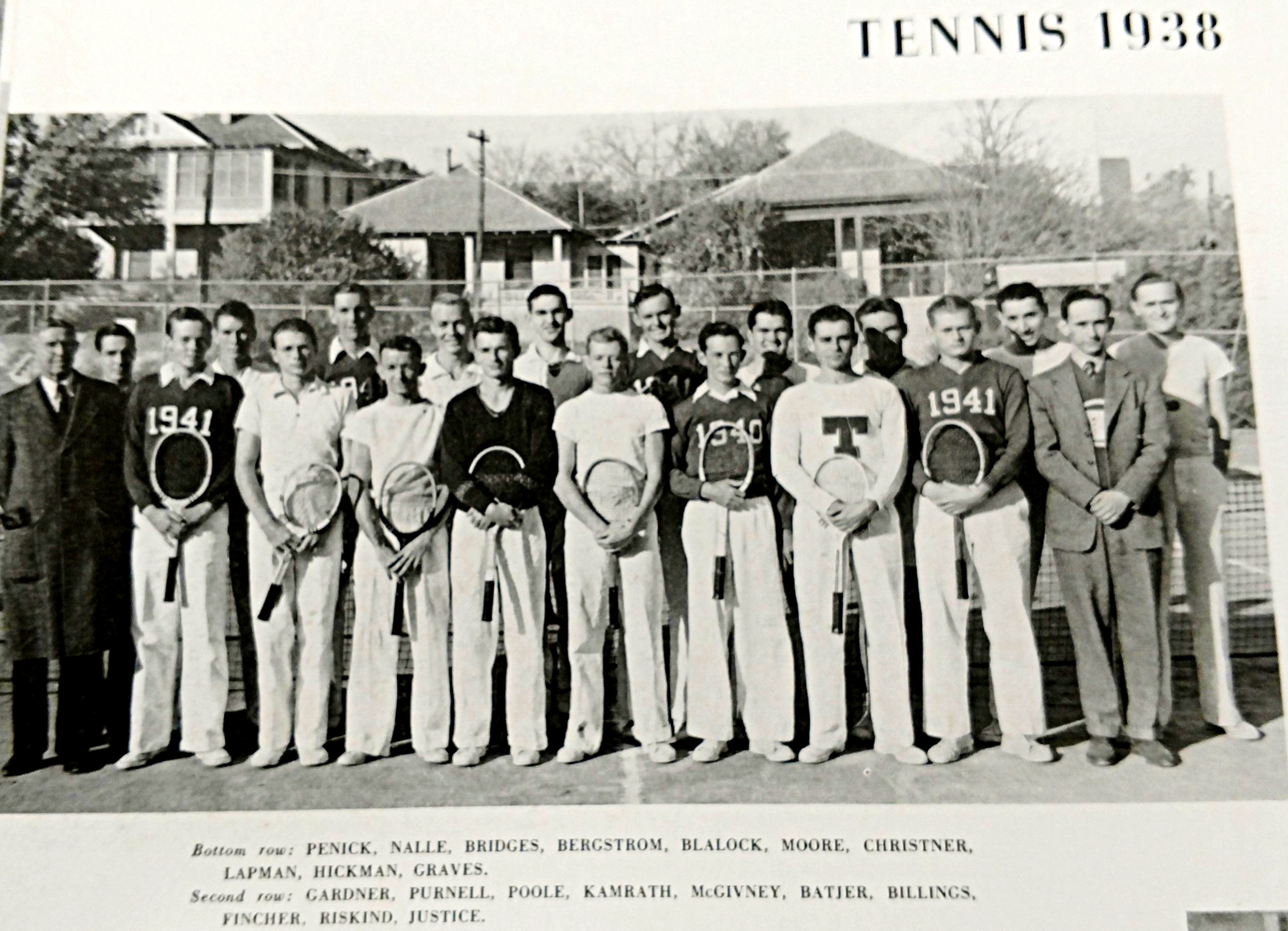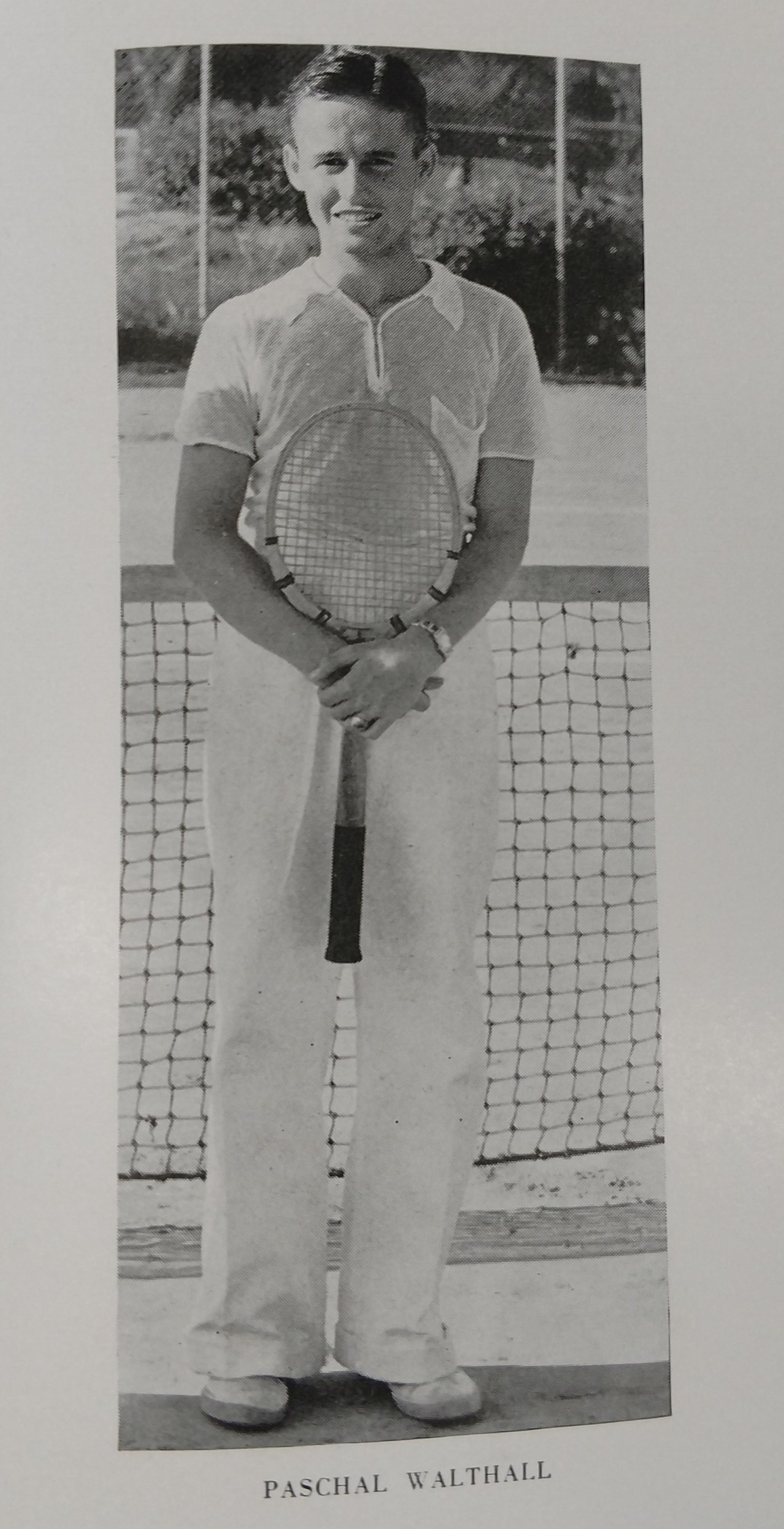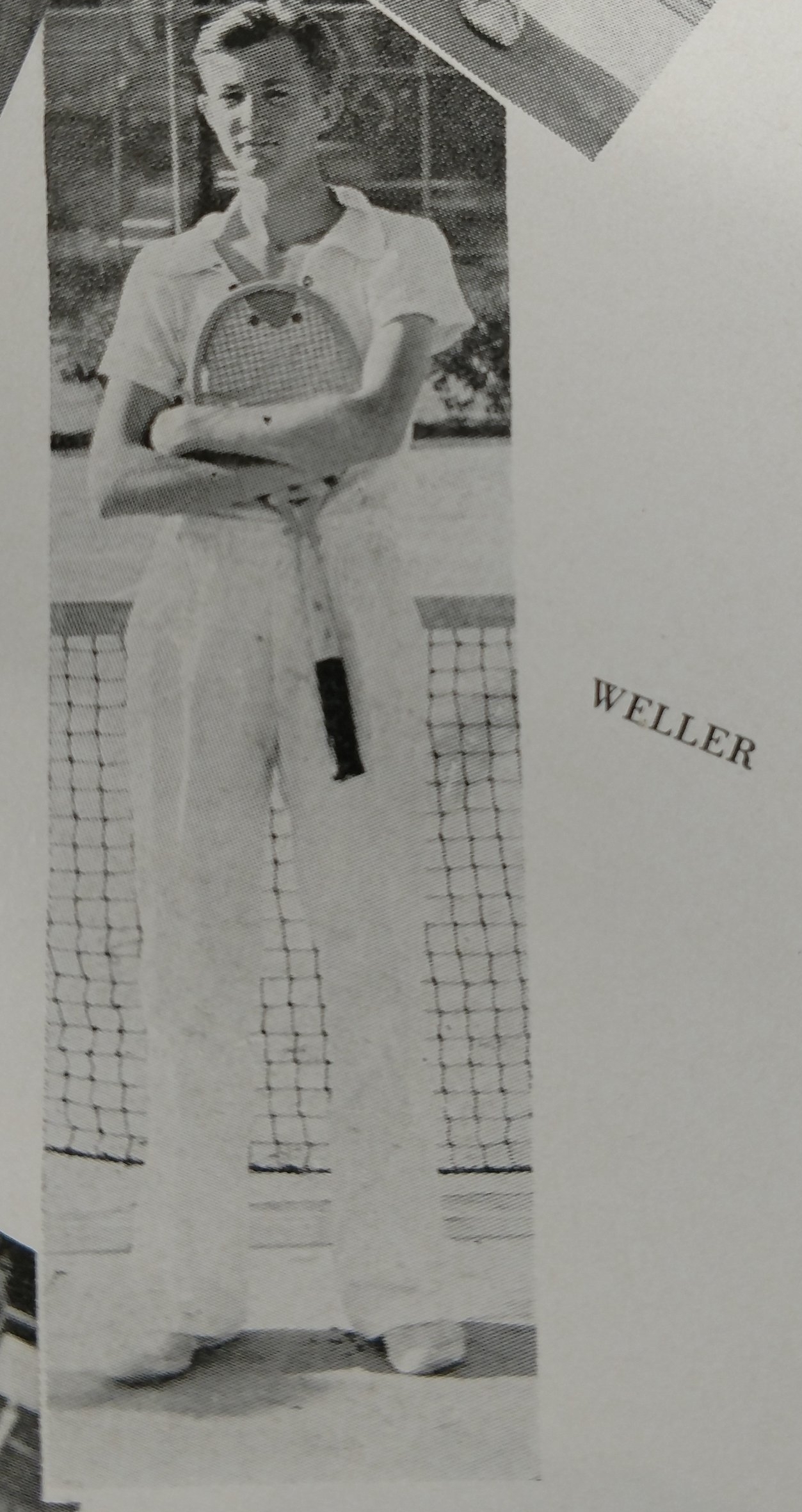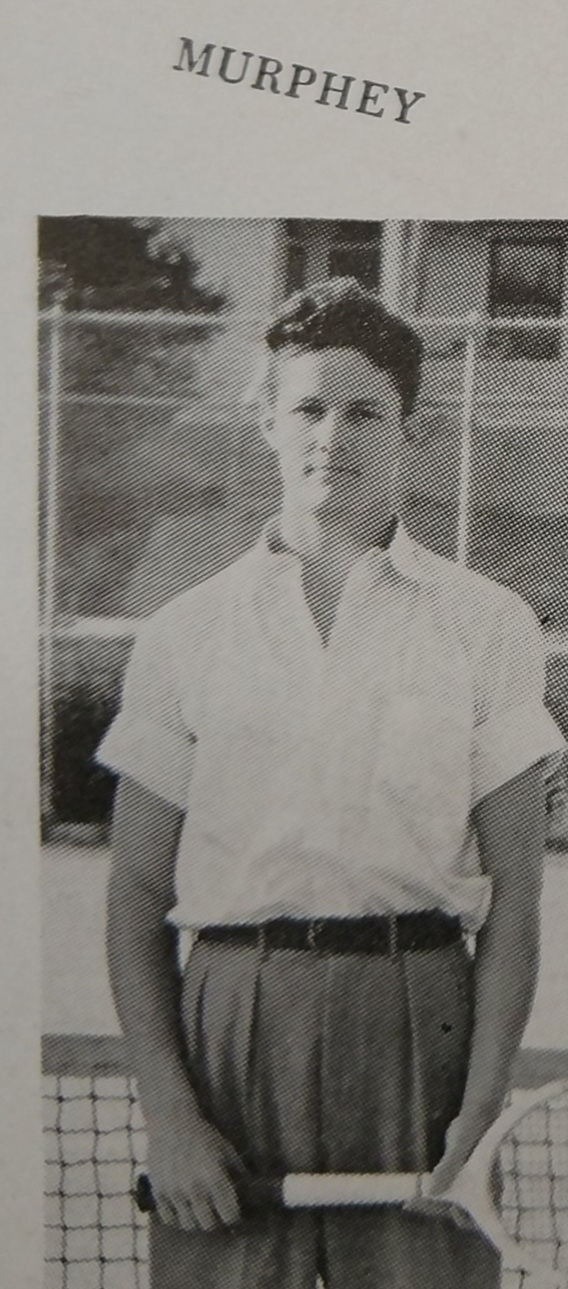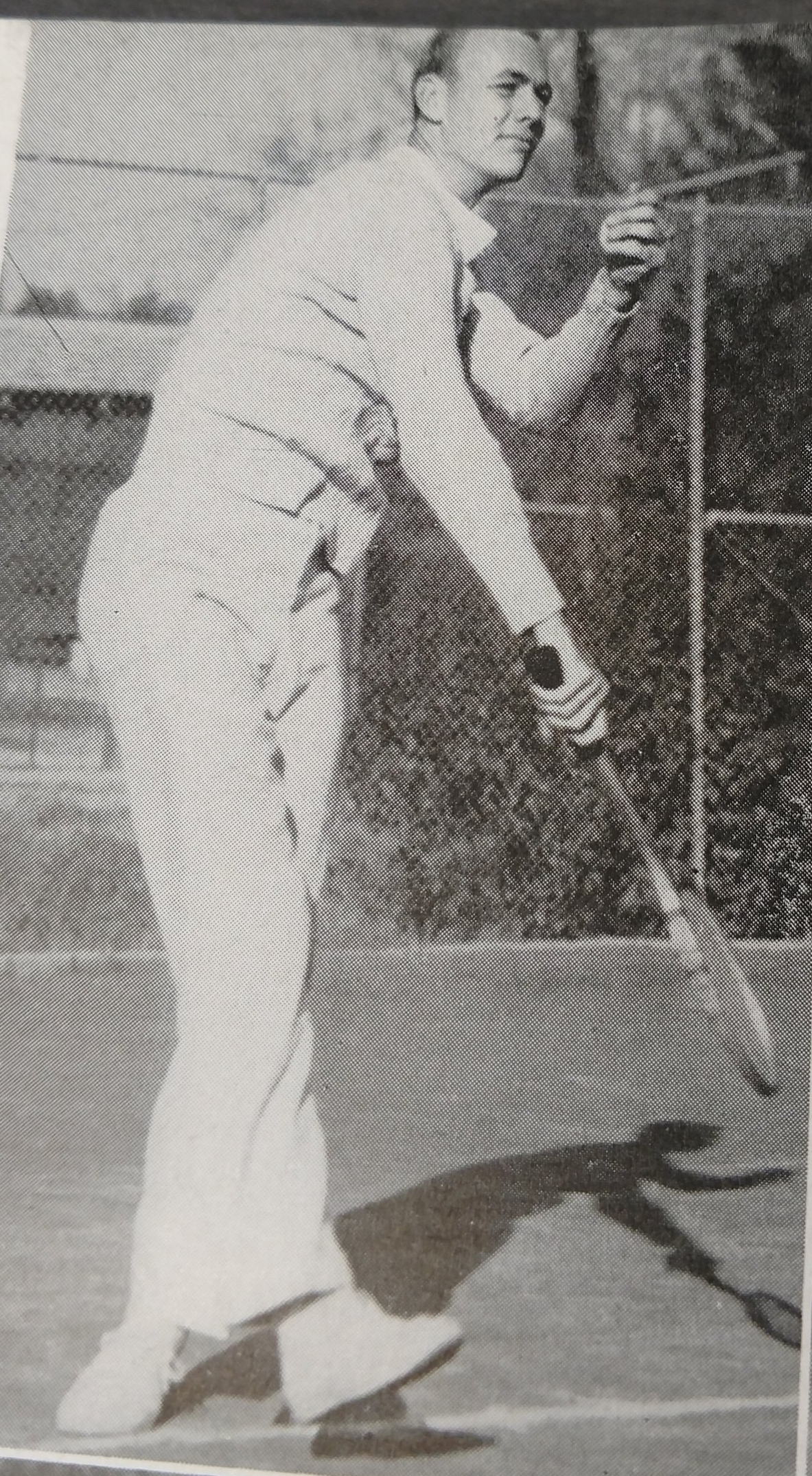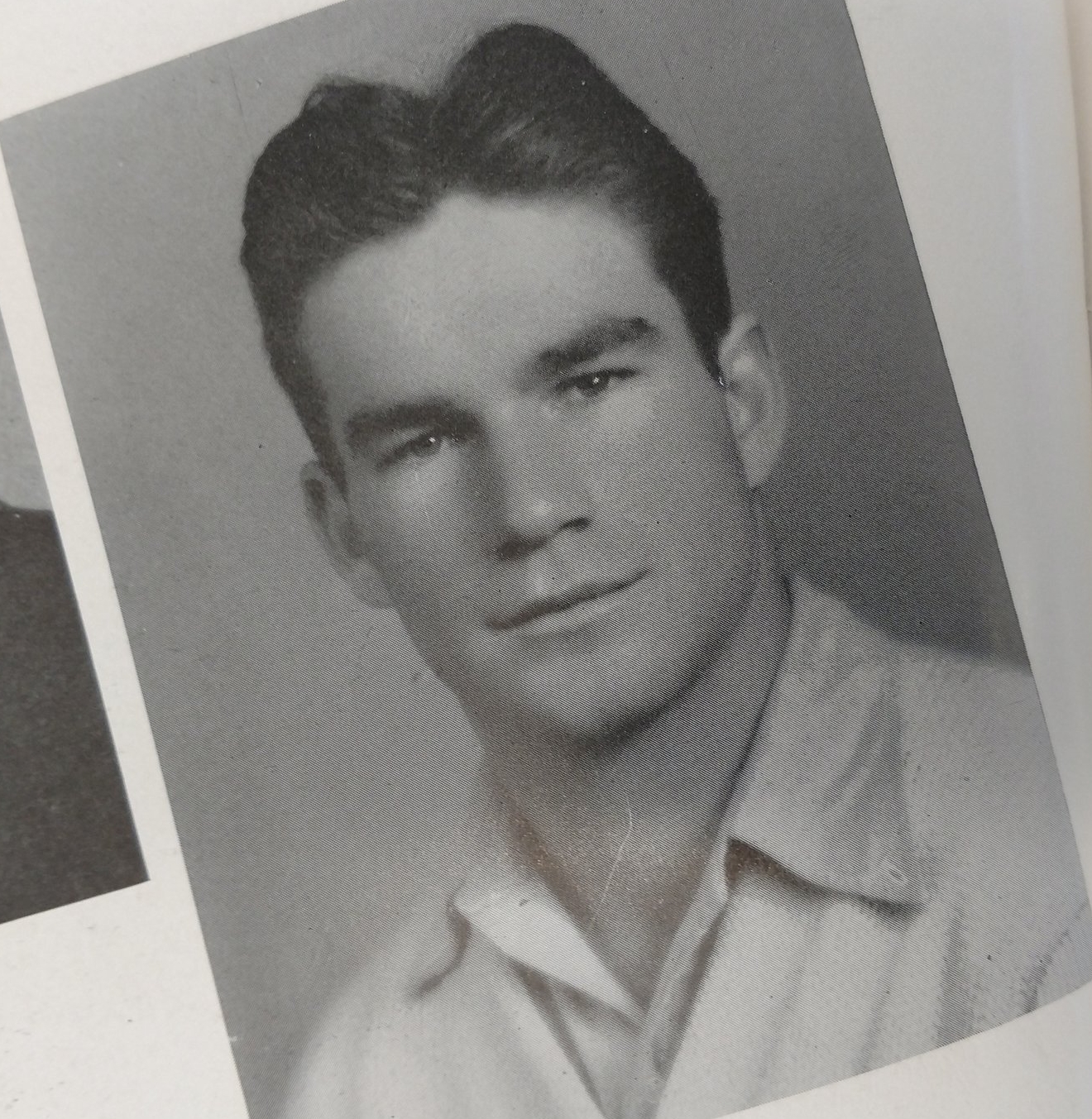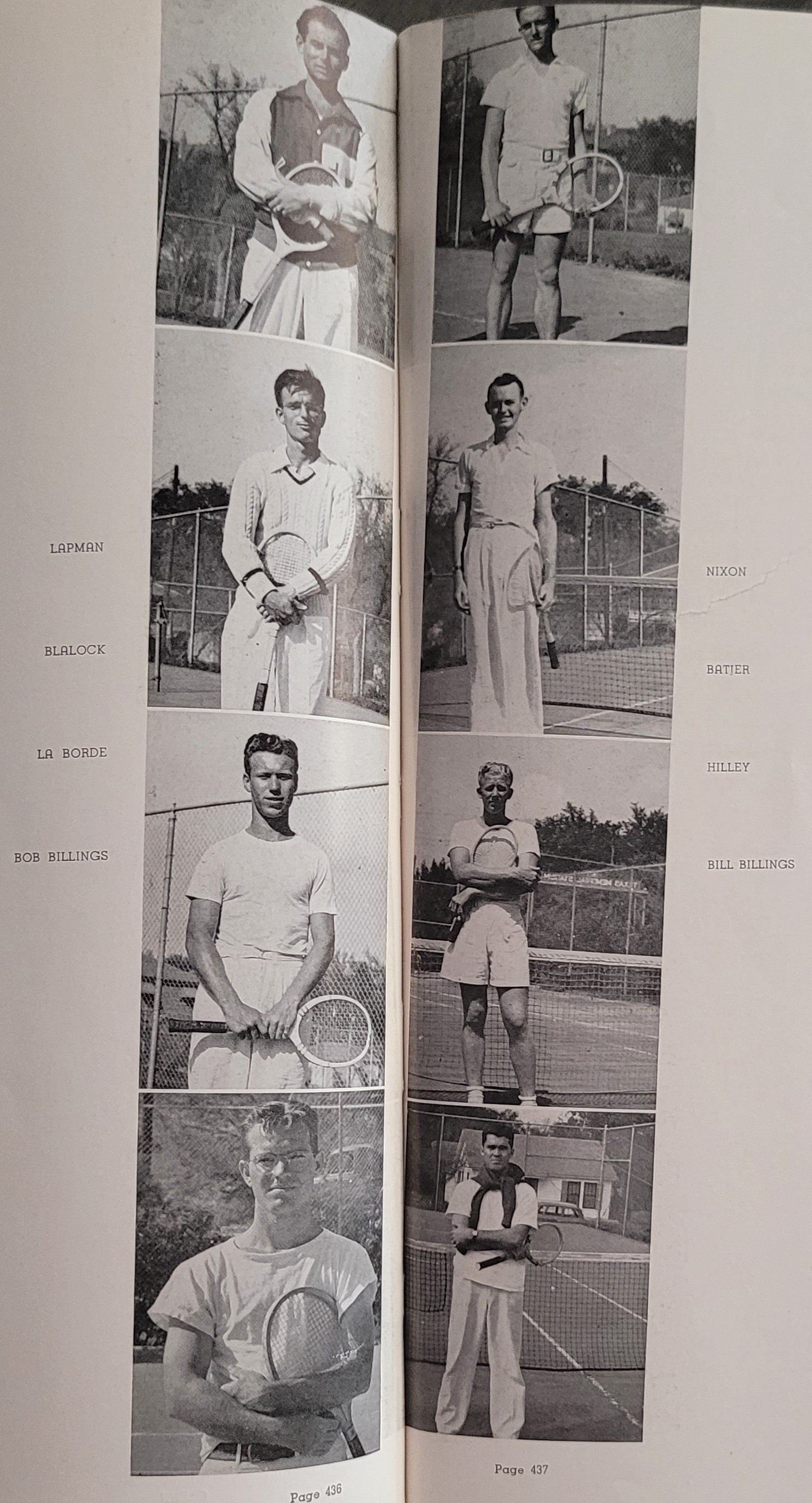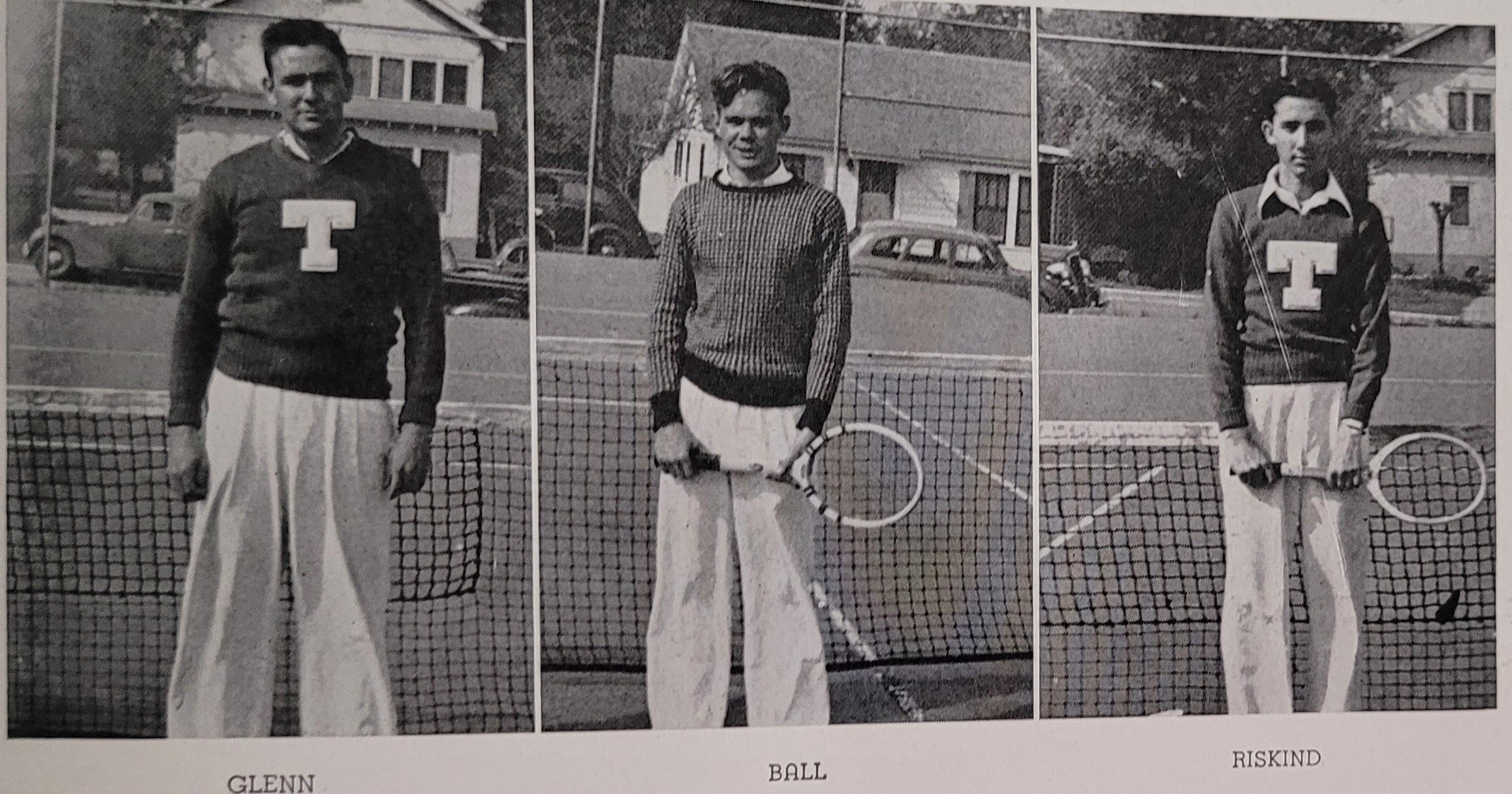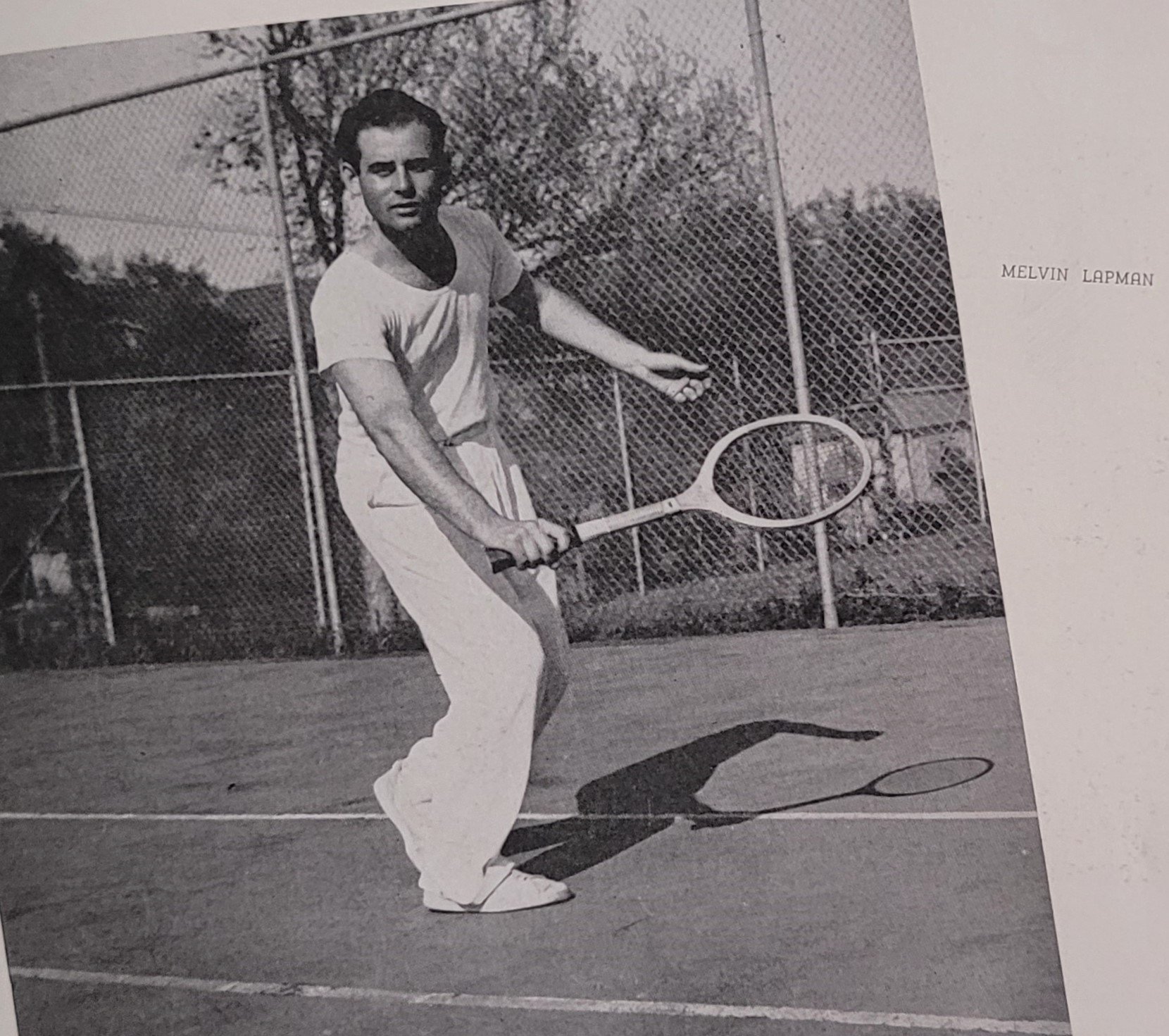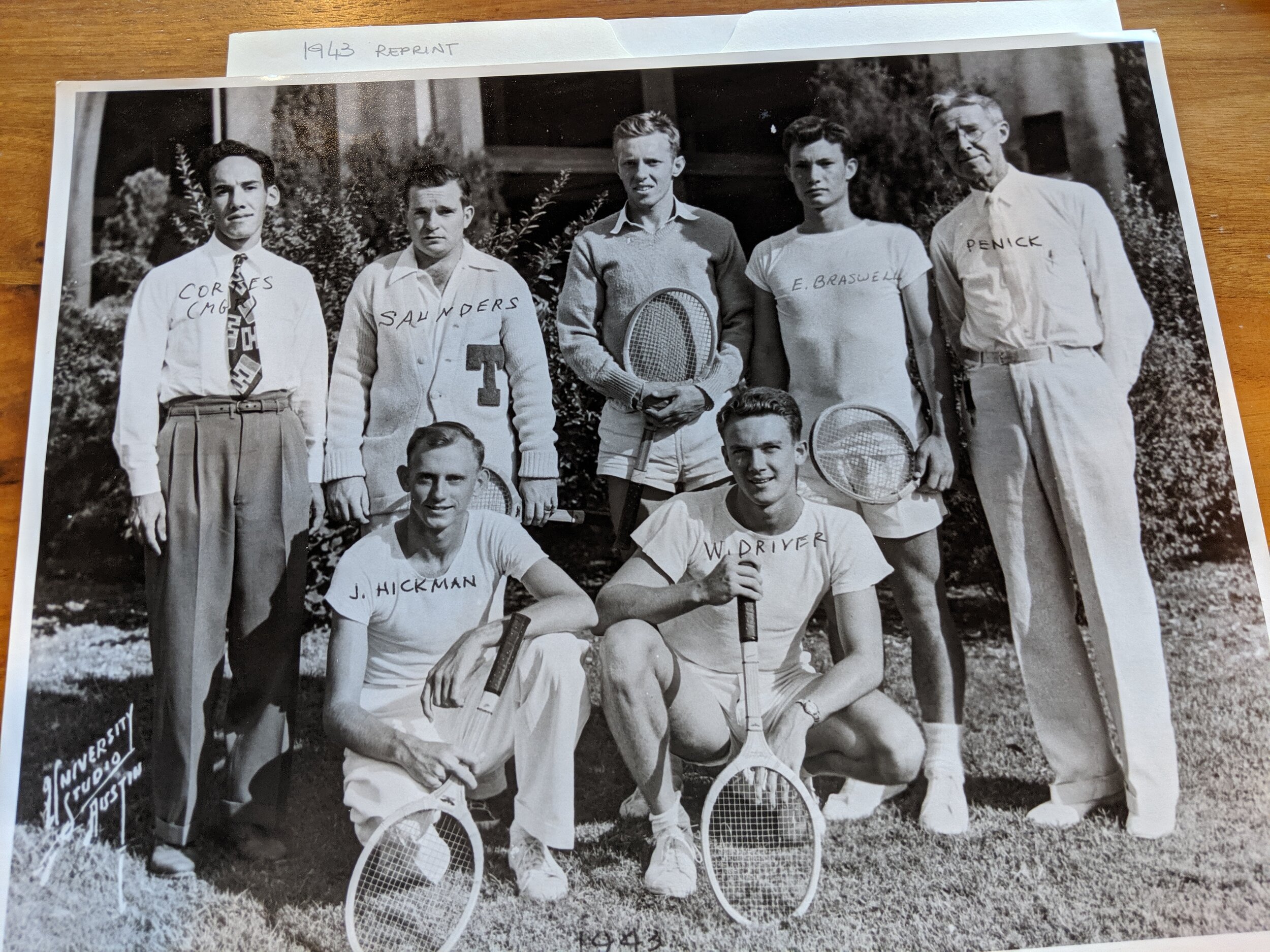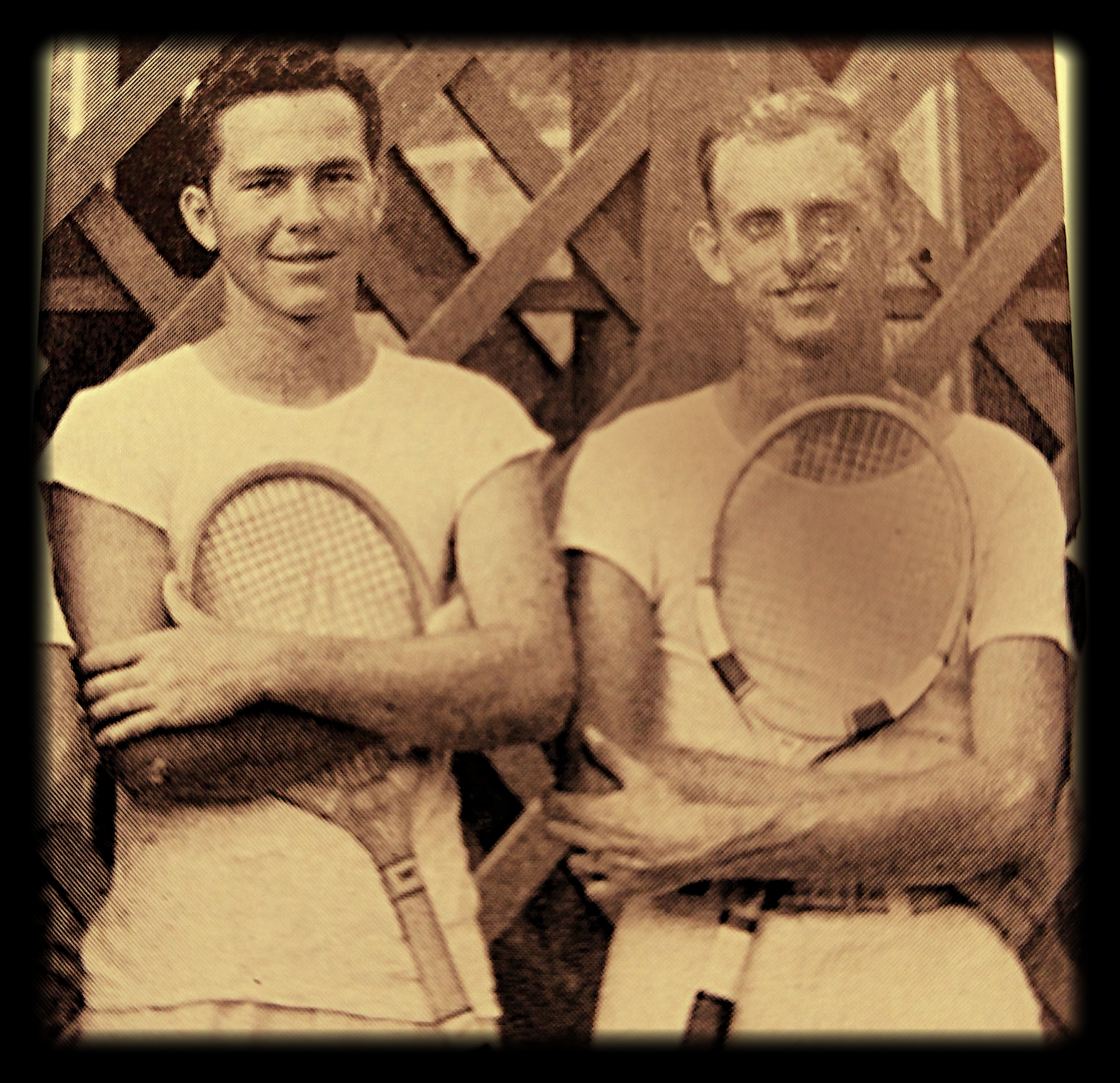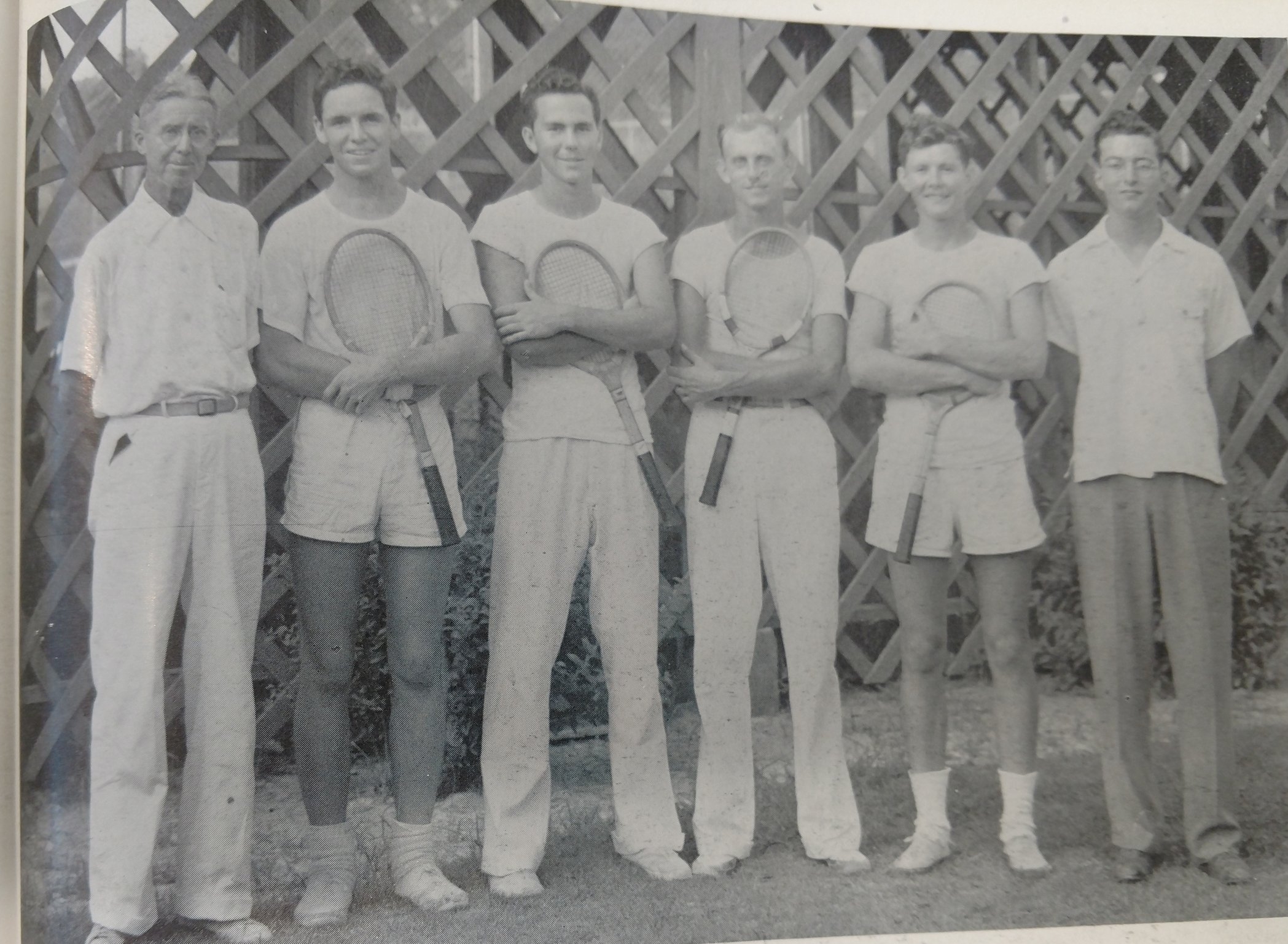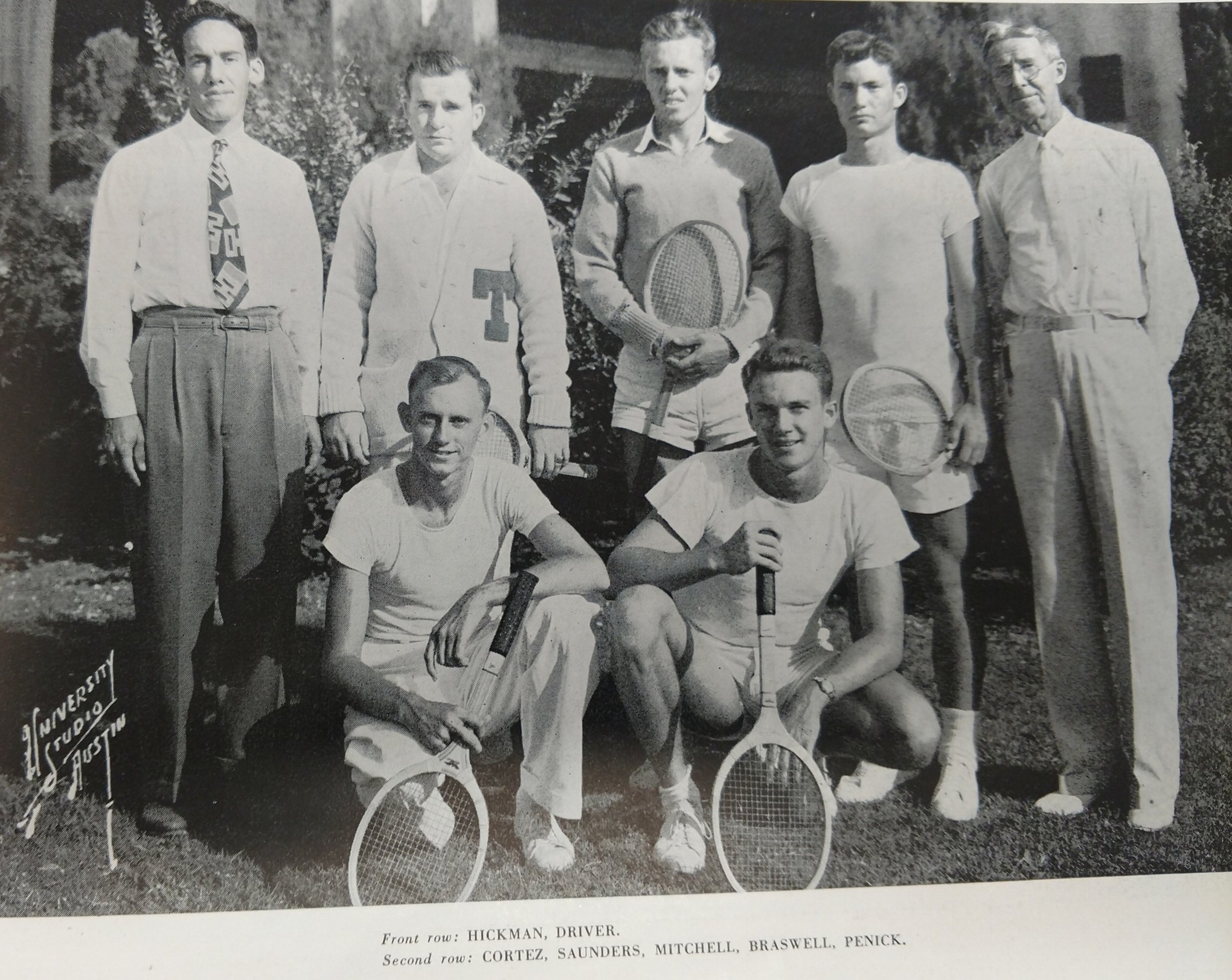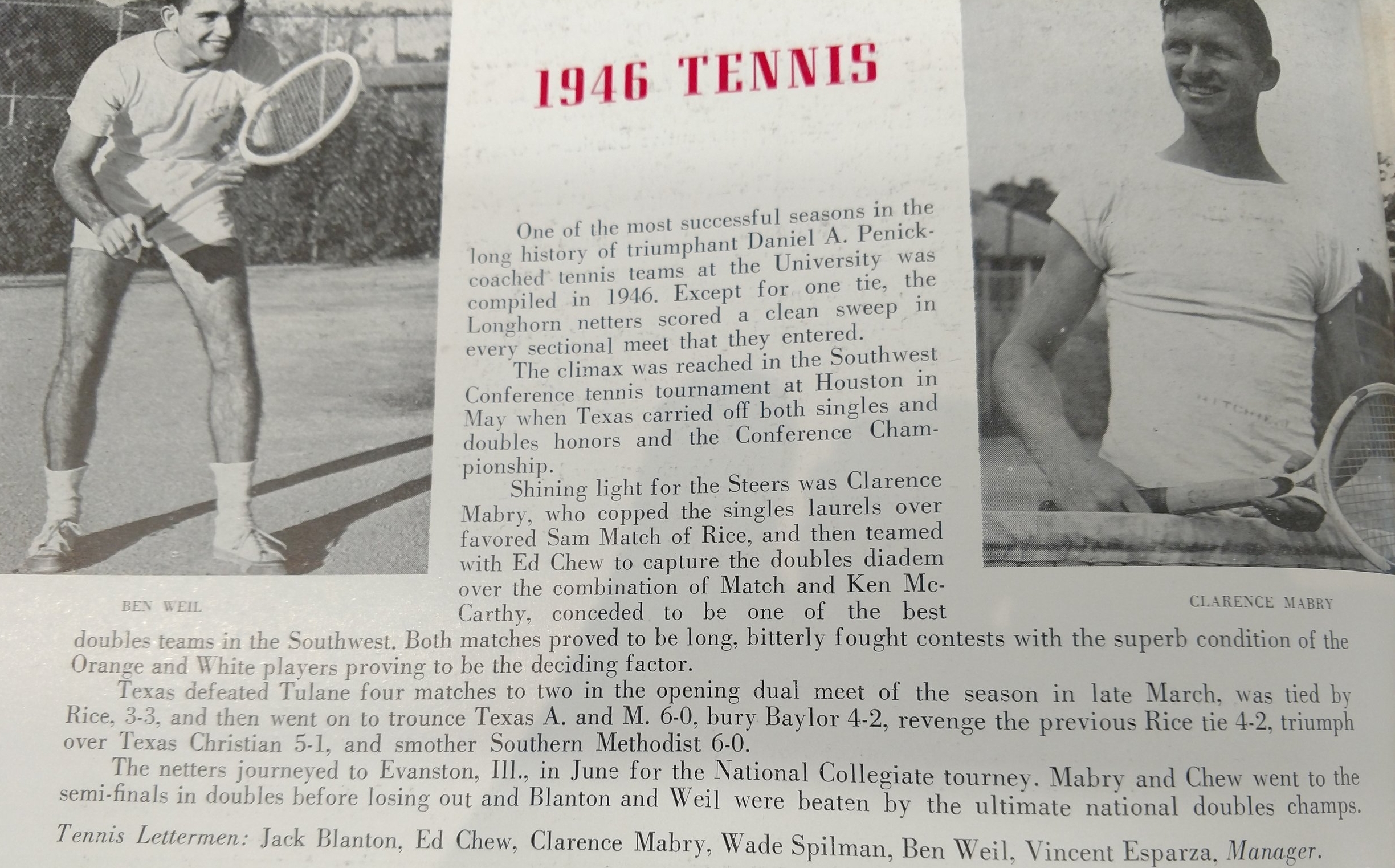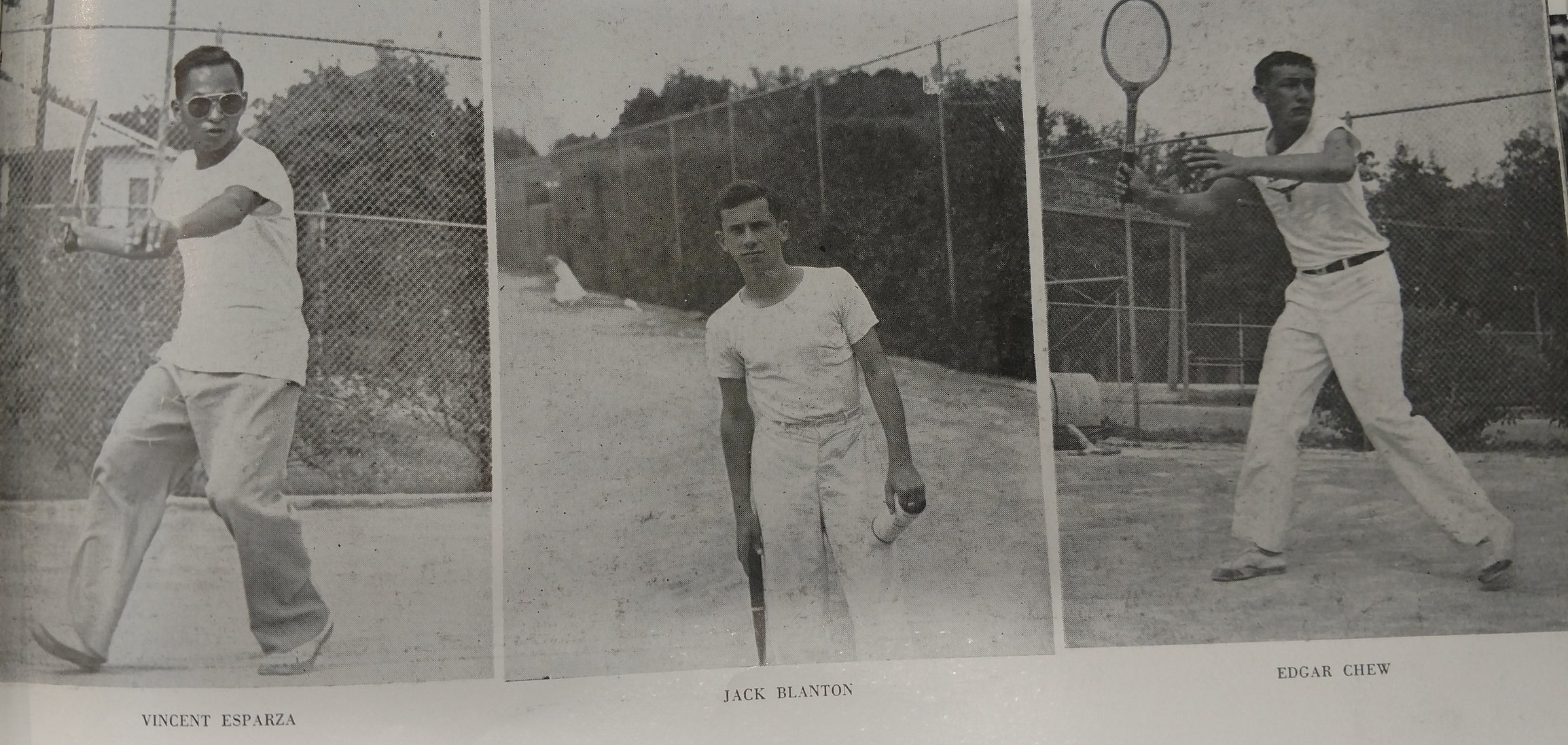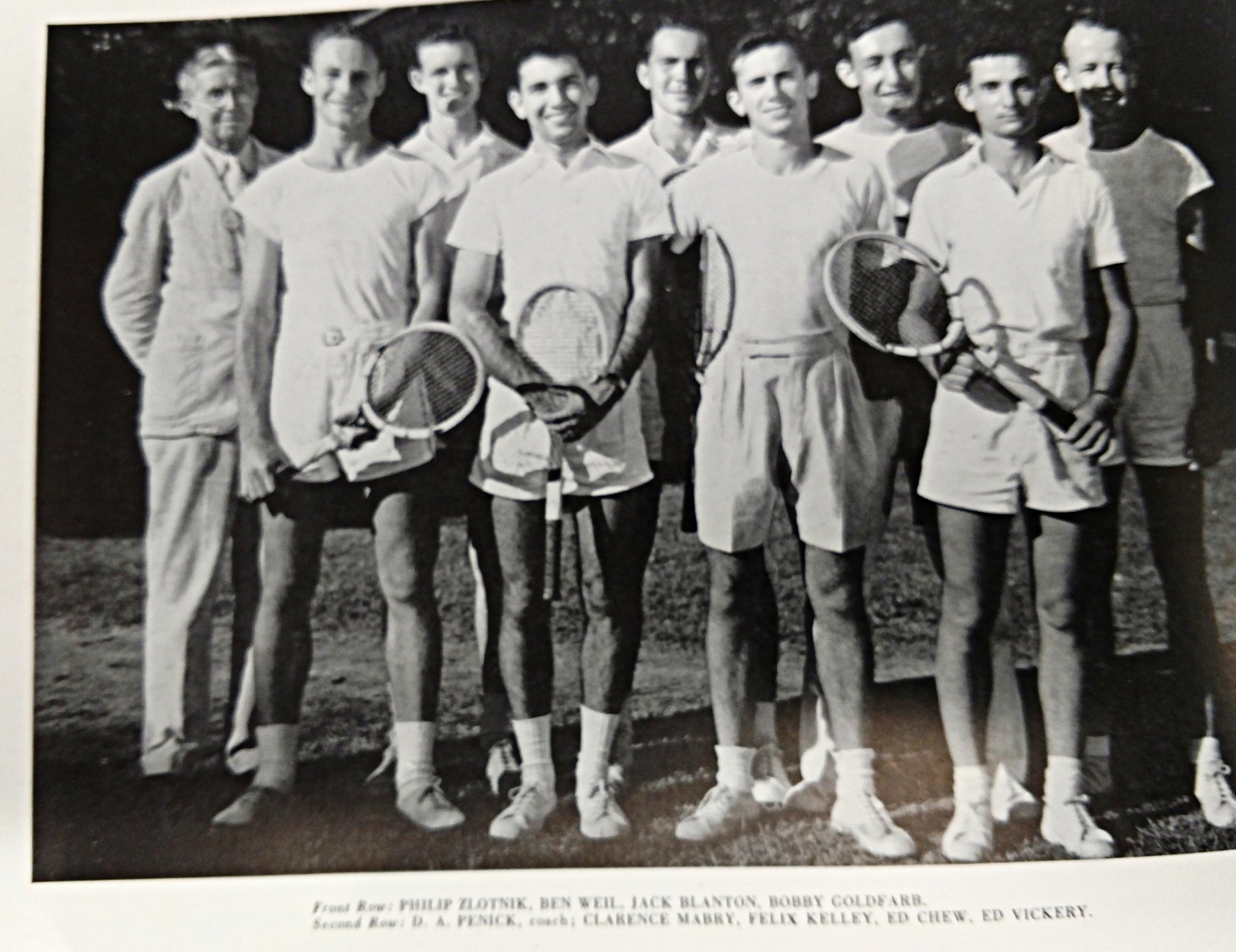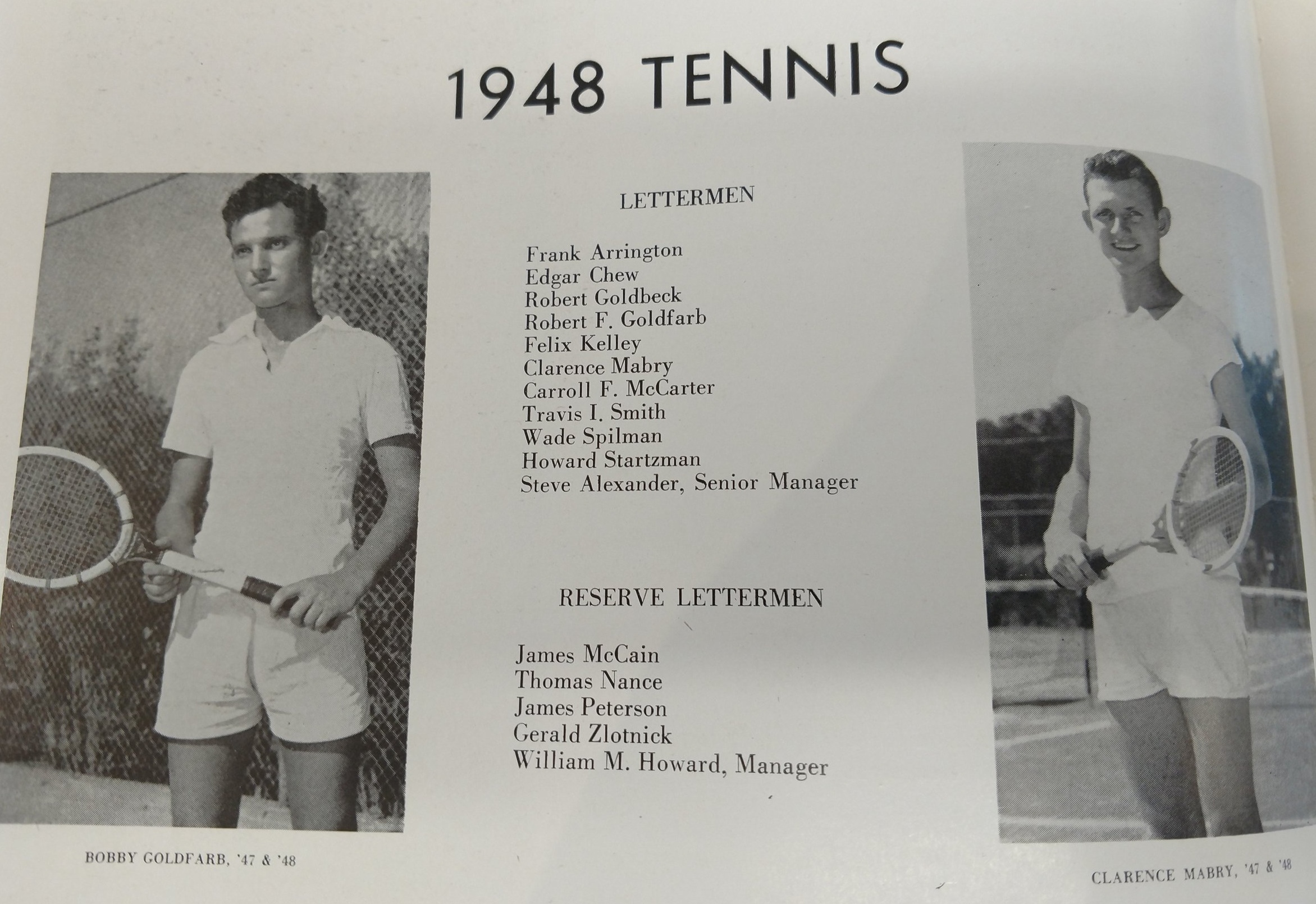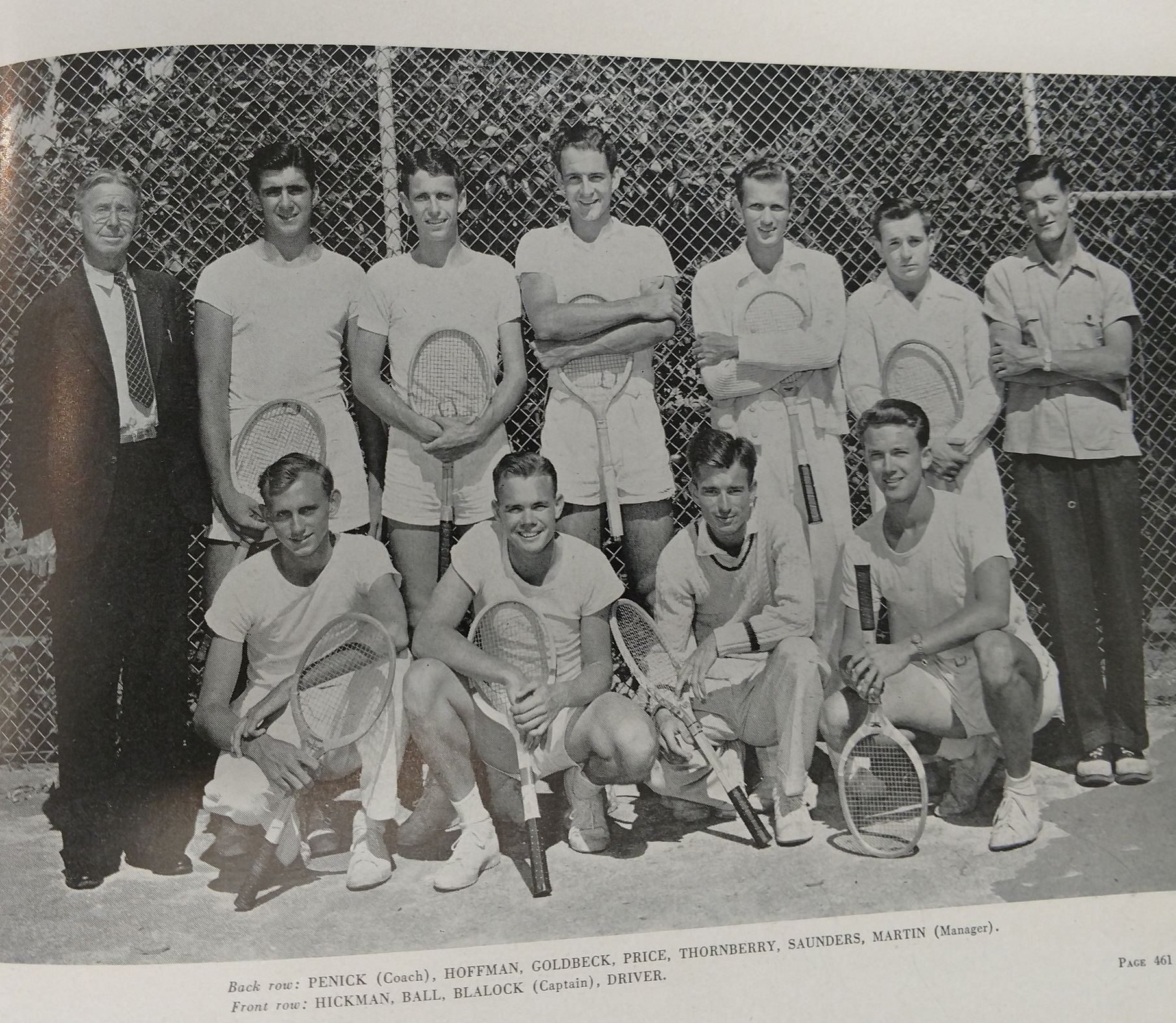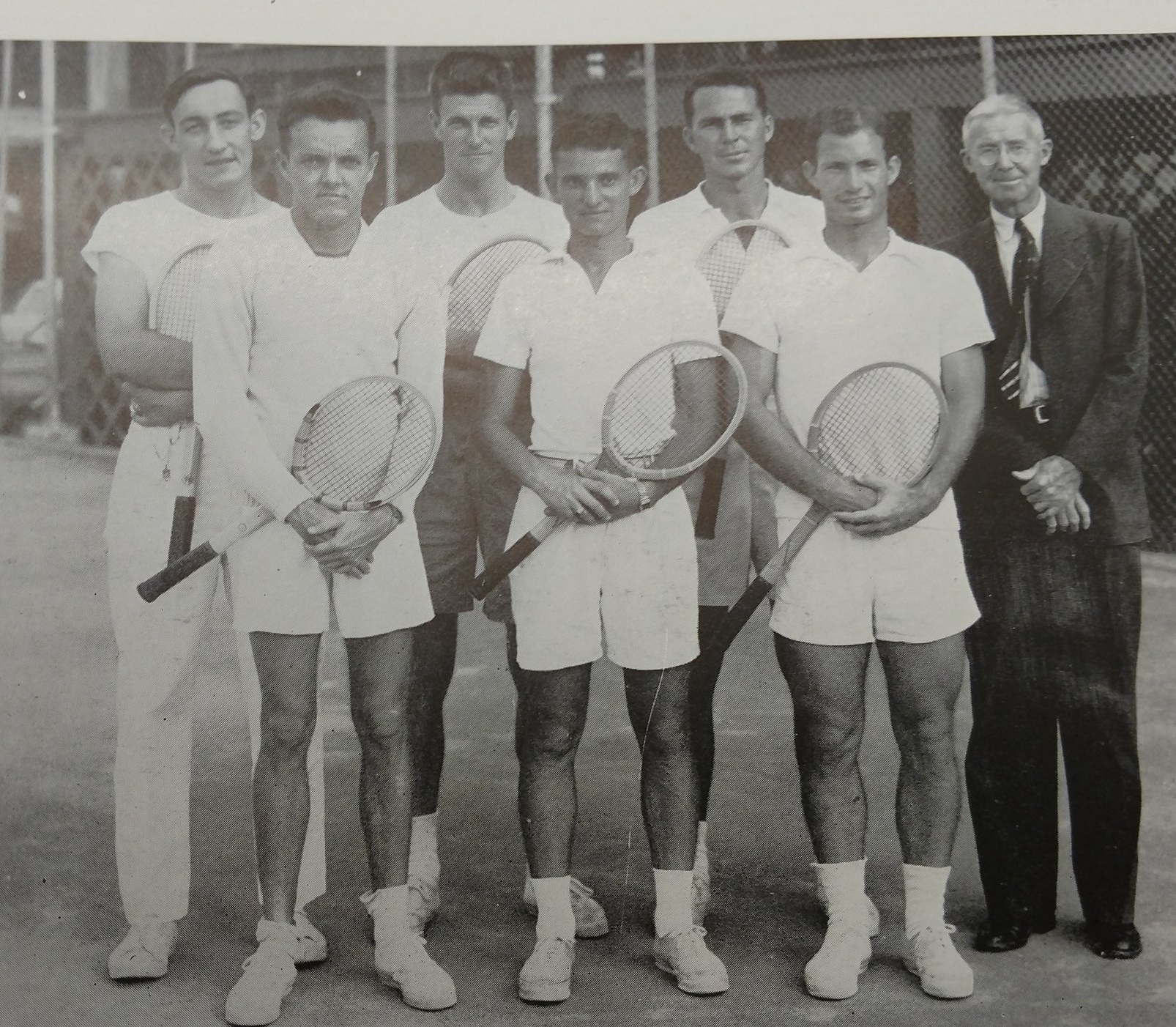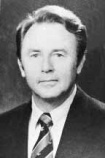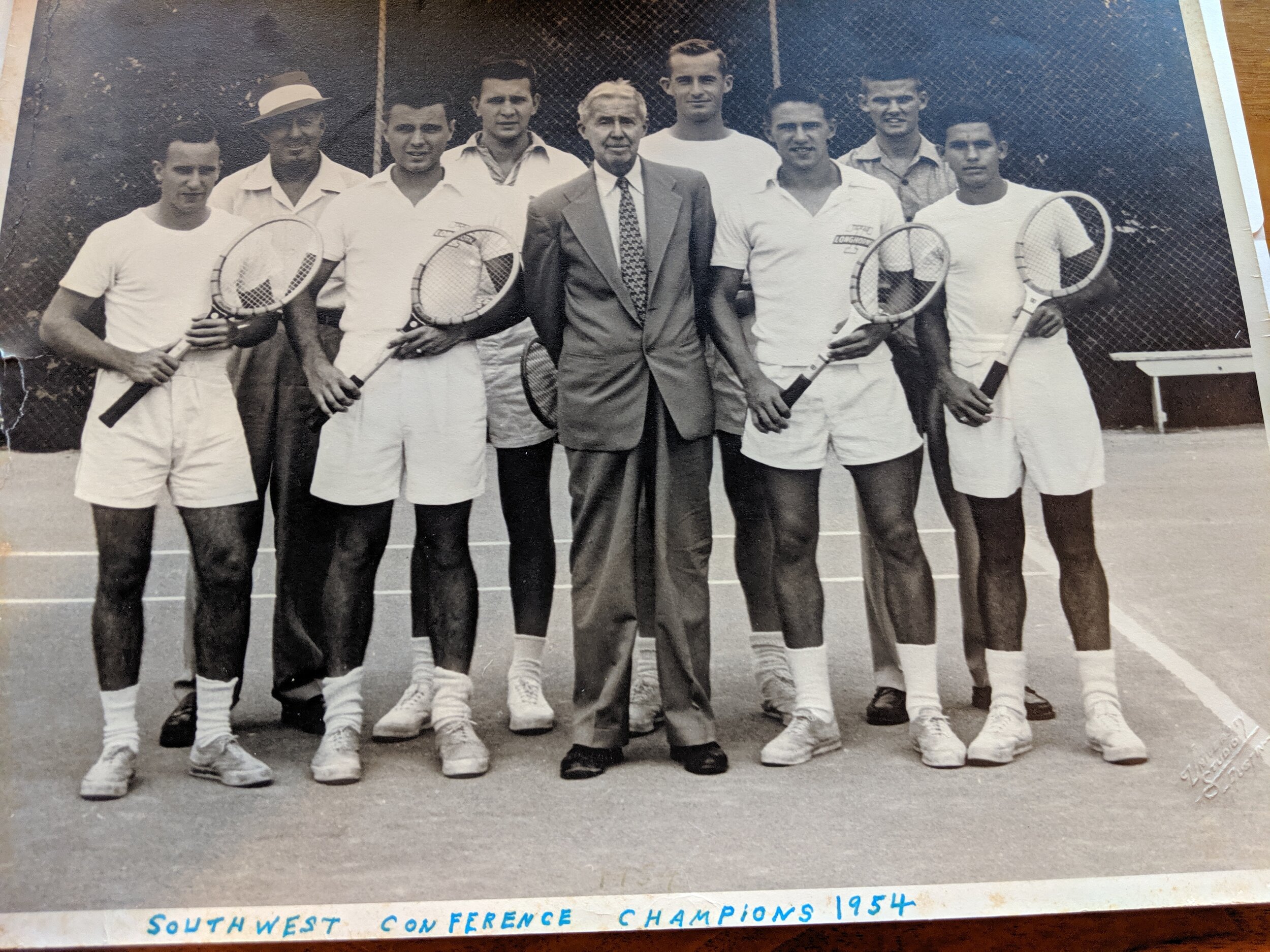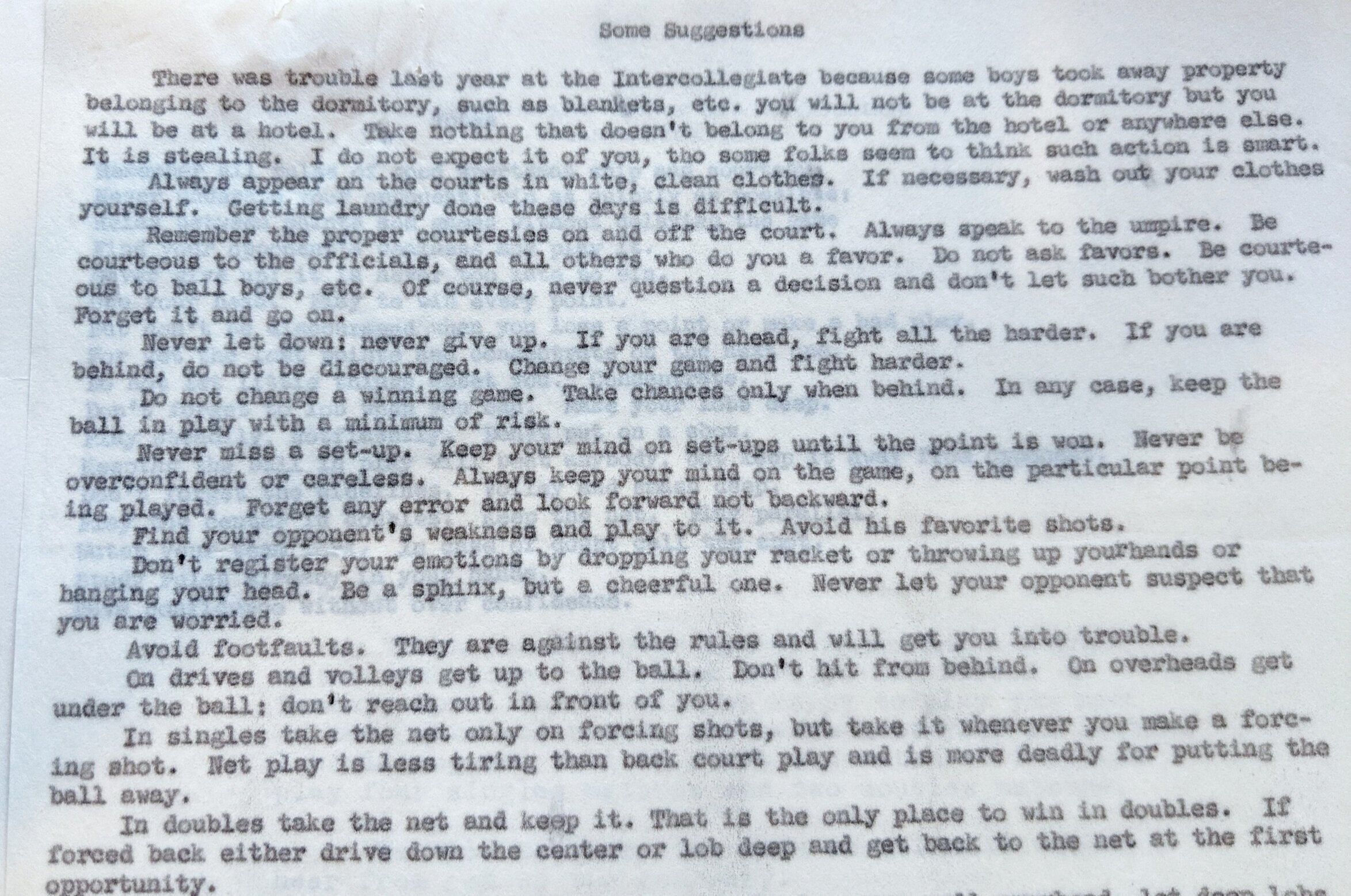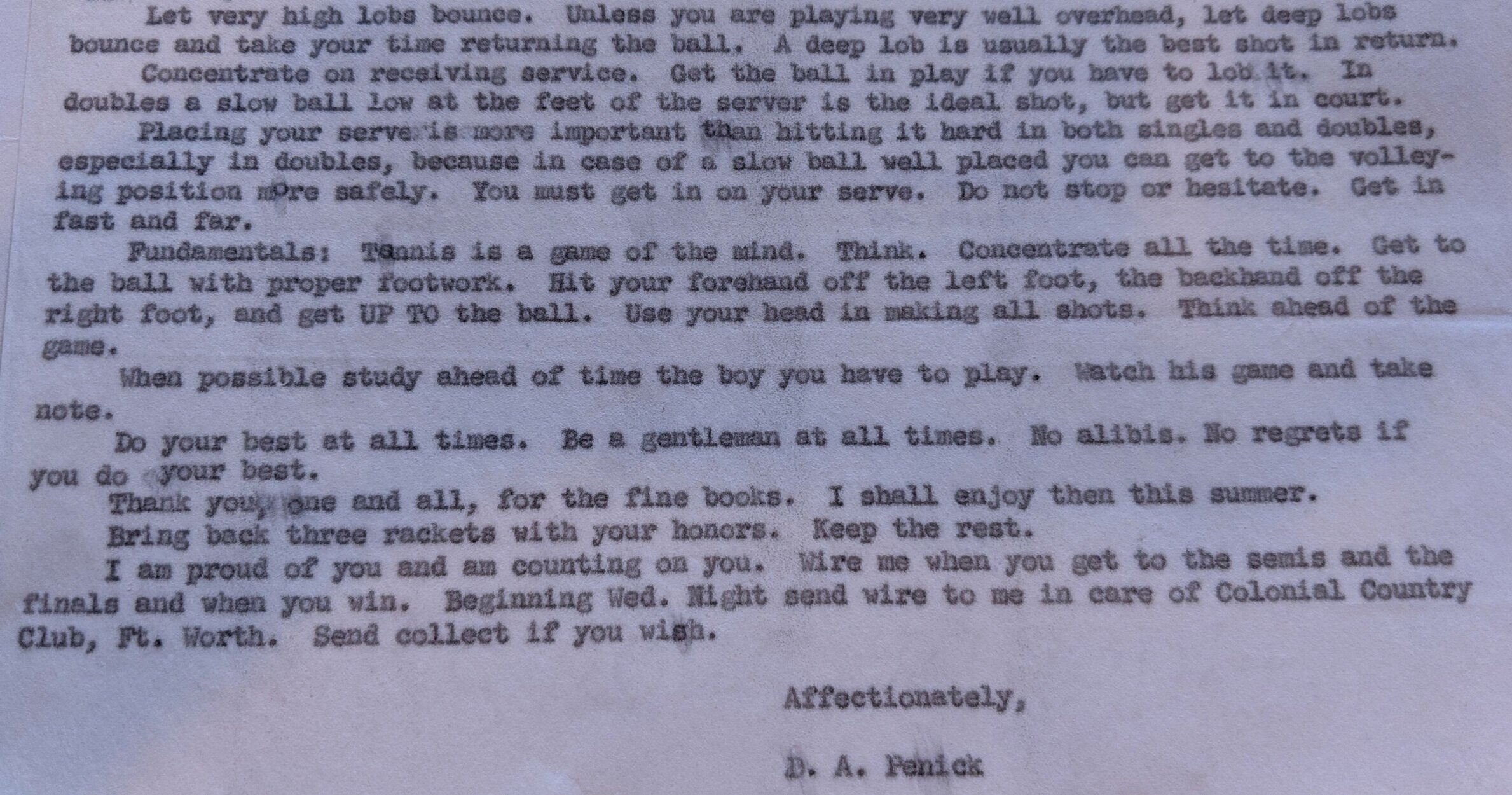“Click on the text denoted in red font on the side bar to visit other sites in this grid
Tennis begins at Texas in 1884
Tennis 1898
Unlike Texas Basketball, Football, Track And Baseball There Are Very Few Books Or Research Material That Discuss Longhorn tennis. I Hope With Time This Site Can Add Some Historical Insight And Tell The Full And Compelling Story Of The Texas tennis Tradition.
In the beginning Competition in tennis is primarily limited to UT students and UT organizations.
1901- 1957 D.A. Penick
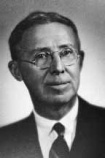
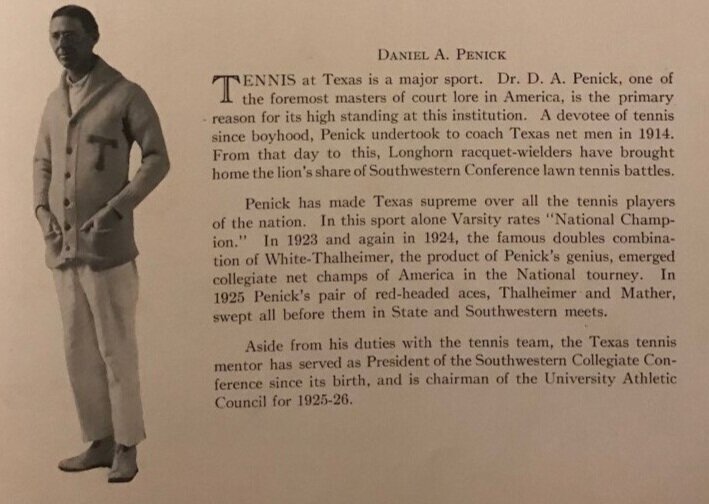
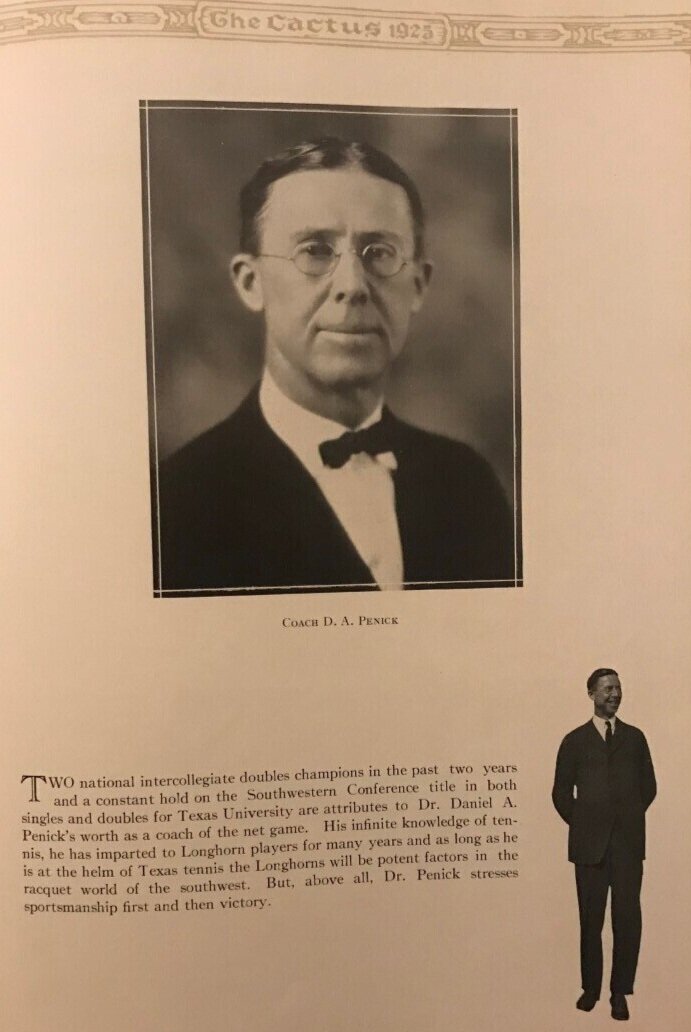
THE HANDBOOK OF TEXAS SAYS ABOUT COACH PENICK
Joined the University of Texas in 1899 as an instructor. Penick was known in the state and nation as a brilliantly successful tennis coach. In 1901 he led a campaign to get the university to provide tennis equipment for players and to stop charging students for time on the courts. He was an unofficial tennis coach for the university team until 1940, at which time he was put on modified status as professor of classics and tennis coach.
In 1899 the Longhorn tennis association says to the members that new courts have been built and old ones have been repaired and improved. The tennis court count is 7 with wire back-nets strung upon iron frames. The association is pleased that women are starting to participate in tennis for their health. There are other comments made that are as true in 2019 as they were true in 1899.
Tennis Association 1899
Tennis players wearing their "T" in 1900
1908- 1957- Coach Dr. D.A. Penick
While associated with the tennis team Coach Penick participated in:
all ten of the Southwest Conference team titles awarded;
thirty-one of the forty individual doubles championships;
twenty-six of the forty individual singles championships;
five national doubles championships;
two national singles championships; and
coached two members of Davis Cup teams.
Penick served as president of the Southwest Conference for twelve years, from 1923 to 1934, and president of the Texas Tennis Association for more than fifty years. He was voted into the Texas Sports Hall of Fame in 1962.
Penick is a great teacher who conveys his knowledge of the basics of Tennis to the players.
Looking from where the LBJ library is now to the Old Main building in 1906
1909 Coach Dr. D.A. Penick
Charles Granger was an All American
1911- Coach Dr. D.A. Penick
Before WWI, Stacy and Broad made a name for the Longhorns in the south and southwest.
1912-1921 tennis photos from the Stark Center
1913 - Coach Dr. D.A. Penick
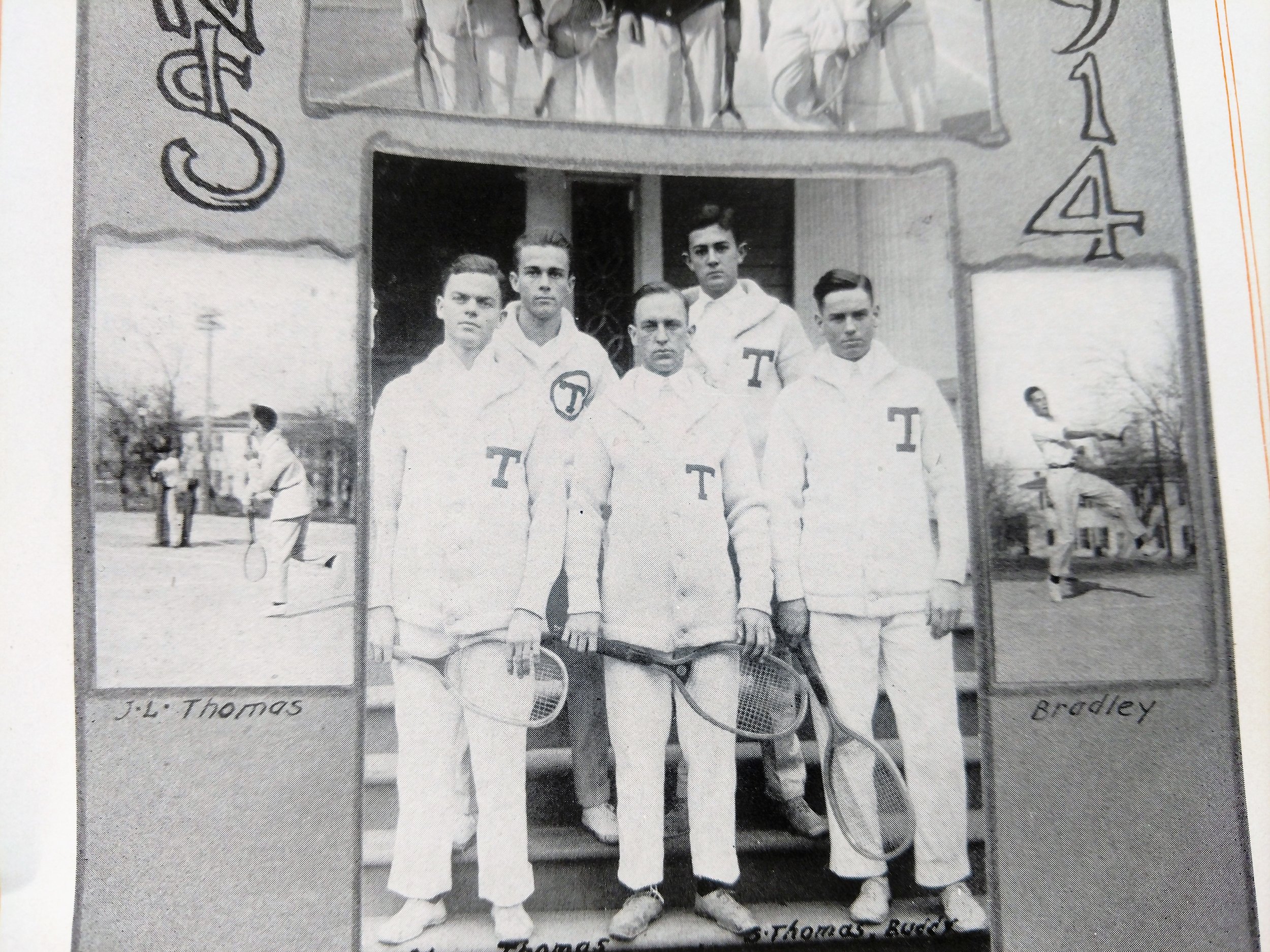
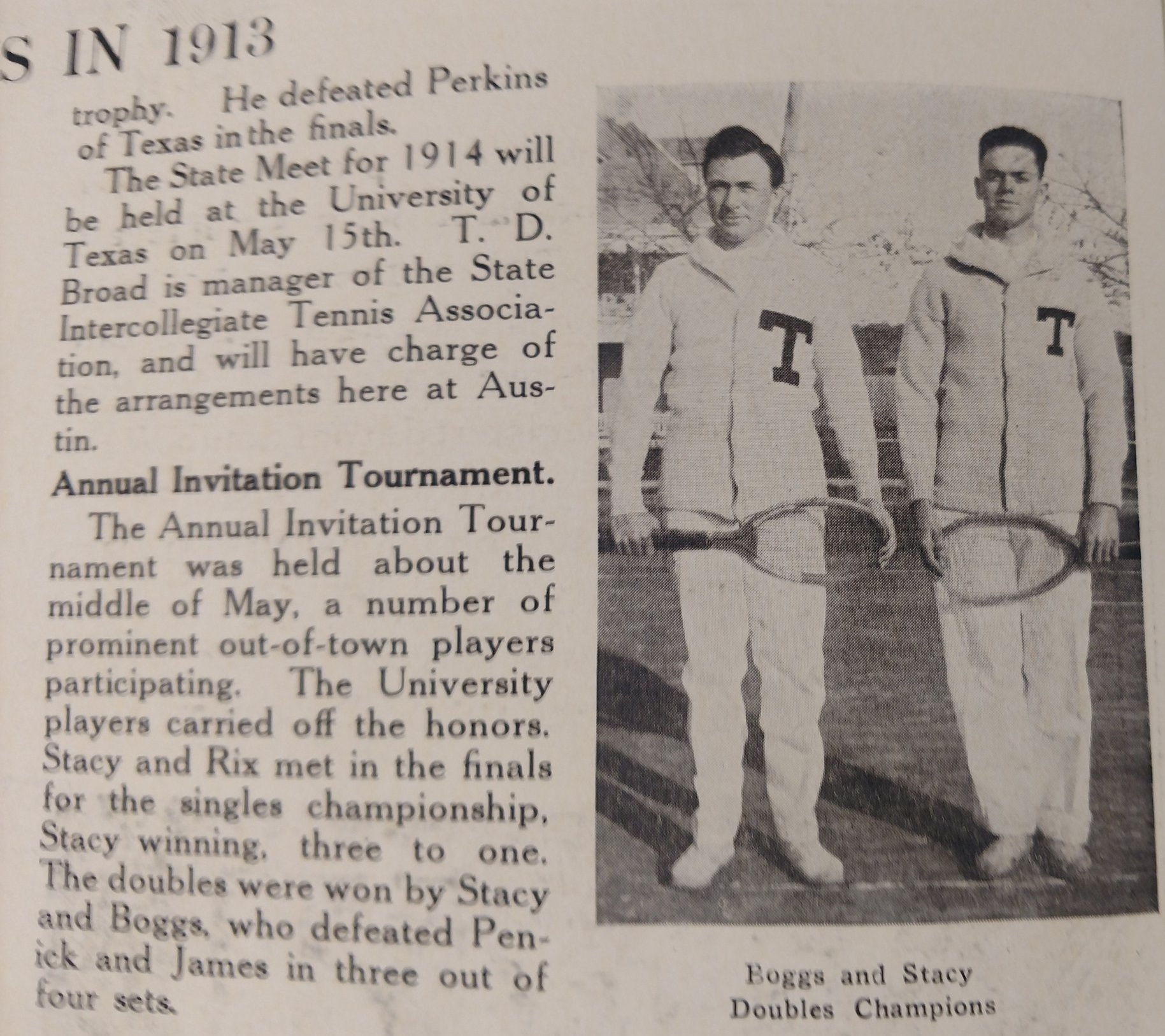
1916 - Coach Dr. D.A. Penick- pending more info.
1919 1920-Coach Dr. D.A. Penick pending more info.
Granger and Drumwright win the doubles in the Southern Inter-collegiate tournament and Granger wins the singles championship.
In 1921 Granger and Drumwright, who were two-point from capturing the double national championships in 1920, won the SWC in singles and doubles with Gregory, Klatt and Brown, winning 7 dual meets. Drumwright went to the semi-finals n the national meet and ranked 7th.
1921-1922-Coach Dr. D.A. Penick pending more info.
A TRIBUTE TO LONGHORN TENNIS STAR LOUIS WRIGHT FERGUSON BY HIS DAUGHTER PAMELA FERGUSON.
Click on link below for Louis story.
Dad’s letters to his mother the previous year described returning from successful tournaments in Oklahoma, Waco, and Fort Worth, where they played against “Oklahoma University, Baylor, and TCU, and all in all it was a very good trip. I haven’t lost a match yet and I’m going to try to go through the season without losing one. ... I have been trying to fight a lot harder this season after a slump last year.”
In 1922 the Longhorns won the SWC and White and Granger were 5th in national doubles..
1923 and 1924-Coach Dr. D.A. Penick - One of the best tennis teams of all time.
The 1924 team won all their dual meets capturing the SWC in singles and doubles. White and Thalheimer captured the national doubles title.
Penick was writing articles for the newspaper (see headlines below) . In the articles he still refers to the Texas team as “THE VARSITY”.
1924-1925 Coach Dr. D.A. Penick
Thalheimer wins the national championship in singles and Thalheimer and White win the national championship in doubles.
1925-1926 Coach Dr. D.A. Penick pending more info.
This team continues d the streak of never losing both the singles and doubles in any meet. They win every dual meet and the SWC Championship.
1926-1927-Coach Dr. D.A. Penick
Actual 1927 Penick Court sign at the Stark Center
Wilmer Allison National Champion and future Head Coach of the UT Men's tennis program. TSHA states "At UT he began an internationally acclaimed career as a tennis player. Under the tutelage of Daniel A. Penick he won the Southwest Conference and National Collegiate Athletic Association championships in 1927." He was the first player ever to win the national intercollegiate singles championship in his first year of competition
1927- 1928 Coach Dr. D.A. Penick .
1928-1929 Coach Dr. D.A. Penick .
Dad attended UT after oil was discovered on campus-owned land, which helped to swell campus coffers and fostered a solid reputation in mining engineering. “We used to step off campus into desert,” he’d say. Dad would recall streetcars rattling down Congress Avenue, and he regaled me with tales of how he and fellow chemistry students made bathtub gin during Prohibition. As their geology fieldwork spanned the Hill Country, he told me of a time they ended up at some rancher’s illegal still to see turkeys staggering around drunk on discarded corn mash.
Even though he admitted tennis sometimes shifted his attention away from his studies, he graduated and took his Hill Country rock knowledge to Africa, where he excelled in the exploration of strategic minerals, his focus when he joined the State Department in 1949 as a mineral attache under the Marshall Plan’s Economic Cooperation Administration.
My father, Louis Wright Ferguson, died in 1993. In some of my final moments with him, long after his days in Austin, Dad spent a lot of time in a recliner. He would often laugh, tilt back to lift his feet onto the footrest and clink ice in his bourbon. In soft moments, I would stand behind the chair and apply acupressure to his shoulders and neck to relieve pain and tension. A silent touch was one of the most bonding memories at the end. Or I would sit on a stool to work on his hands, especially his left hand with its missing ring finger and pinky, gone because of a shooting accident when he was a boy in El Paso. The accident had propelled him to become a star tennis player (and golfer, too), and to teach his four kids obsessively about gun safety.
After his death I picked though tax documents, personal papers and paperbacks, until I salvaged more important items. His old passport. My mother’s engagement photos. And some Hollywood-like glamour shots of Dad taken during his days at the University of Texas. These days, every time I wander by a University of Texas building that was around in the 1920s, I pause and think, “Dad used to walk by these same buildings. I feel closer to him in Austin than anywhere.
Pam Anderson shares more about her father who played for Daniel Penick in the late 1920’s
Pamela Ellen Ferguson is a teacher and author of ten fiction and nonfiction books. She has lived and worked in a dozen world capitals and was dean of Asian bodywork therapy at acupuncture school AOMA from 1996-2004. This tale is an excerpt from her in-progress memoir, “Cornish Cactus.”
While browsing through an antique market in Victoria a few years ago, imagine my joy when I happened upon the UT Cactus yearbook from 1930 and came across photos of my dad on the tennis team under the guidance of legendary tennis coach and classics professor Dr. Daniel Allen Penick. Headlined “The 1929 Season,” the text boasts about the undefeated squad that “captured all-Southwest Conference honors and then won half of the National Intercollegiate honors.” Team captain Hugh Dunlap and my dad were runners-up in the Southwest Conference Doubles competition.
Dad’s letters to his mother the previous year described returning from successful tournaments in Oklahoma, Waco, and Fort Worth, where they played against “Oklahoma University, Baylor, and TCU, and all in all, it was a very good trip. I haven’t lost a match yet, and I’m going to try to go through the season without losing one. ... I have been trying to fight a lot harder this season after a slump last year.”
Dad attended UT after oil was discovered on campus-owned land, which helped to swell campus coffers and fostered a solid reputation in mining engineering. “We used to step off campus into desert,” he’d say. Dad would recall streetcars rattling down Congress Avenue, and he regaled me with tales of how he and fellow chemistry students made bathtub gin during Prohibition. As their geology fieldwork spanned the Hill Country, he told me of a time they ended up at some rancher’s illegal still to see turkeys staggering around drunk on discarded corn mash.
Even though he admitted tennis sometimes shifted his attention away from his studies, he graduated and took his Hill Country rock knowledge to Africa, where he excelled in the exploration of strategic minerals, his focus when he joined the State Department in 1949 as a mineral attache under the Marshall Plan’s Economic Cooperation Administration.
My father, Louis Wright Ferguson, died in 1993. In some of my final moments with him, long after his days in Austin, Dad spent a lot of time in a recliner. He would often laugh, tilt back to lift his feet onto the footrest and clink ice in his bourbon. In soft moments, I would stand behind the chair and apply acupressure to his shoulders and neck to relieve pain and tension. A silent touch was one of the most bonding memories at the end. Or I would sit on a stool to work on his hands, especially his left hand with its missing ring finger and pinky, gone because of a shooting accident when he was a boy in El Paso. The accident had propelled him to become a star tennis player (and golfer, too), and to teach his four kids obsessively about gun safety.
After his death I picked though tax documents, personal papers and paperbacks, until I salvaged more important items. His old passport. My mother’s engagement photos. And some Hollywood-like glamour shots of Dad taken during his days at the University of Texas. These days, every time I wander by a University of Texas building that was around in the 1920s, I pause and think, “Dad used to walk by these same buildings. I feel closer to him in Austin than anywhere.
Bell wins the SWC championship in singles twice and the national championship in 1929.
1929-1930 Coach Dr. D.A. Penick
Penick tennis teams reach a new high and for the first time contend for the prestigious Merion Cup trophy against Stanford, Leland, and Yale. Allison, Mather, Thalheimer, White, Bell and Barnes tennis play was exemplary.
1930-1931 Coach Dr. D.A. Penick
Bruce Barnes and Karl Kamrath National Champions
Horns win the SWC with a perfect season at 10-0. All the finalists in singles and doubles were Longhorns. Bruce Barnes wins his 3rd straight Southwest Conference championship and Karl Kamrath and Barnes win in doubles.
Bruce Barnes -In three years as a Longhorn never loses a match. He wins the Southwest Conference singles and doubles championships three consecutive years (1929, 1930, 1931). In 1931, he teams with fellow Texan Karl Kamrath to win the national collegiate doubles title and is a singles finalist the same year.
1933-1934- 1935 Coach Dr. D.A. Penick
1933 team is one of Dr. Penick's best. Considered to be the best balanced in Texas net history, but they meet their match in Stanford. The upset of Karl Kamrath and Sterling Williams in doubles by Stanford eliminated Texas as a national champion contender.
1934 team starts the season off with a 27-1 record.
National Intercollegiate competition is held at the Merion Cricket Club in Haverford, PA. Competitors include Texas ,Princeton, Tulane, Georgia Tech, Univ. of California, USC, and others.
Buxby , Weltens, Brady, and Smalley represent Texas. The Horns are handicapped by a lack of practice on grass courts and all the Longhorns struggle. Buxby is the only one who reachs the quarterfinals. In doubles Buxby and Weltens make the semi-final round.
1935-1936 Coach Dr. D.A. Penick
1935 team is led by Bruce Baxter, Bert Weltens, Smalley, and Pease and finish 2nd in the SWC.
1936 -1937 Coach Dr. D.A. Penick - SWC champions
Penick says he was pleased with the performance of the team this year.
1937- 1938-Coach Dr. D.A. Penick
This year belongs to Bob Kamrath
This team returns 8 letterman and receives some national attention by defeating Miami University 5 - 4. Edgar Weller, Warren Christner, Melvin Lapman and Walthall win their singles matches, but Lapman is the hero against Miami.
In SWC play Bob Kamarath and Weller win the SWC.
Edgar Weller and Bob Kamrath are All Americans, and win doubles together at the SWC championship tournament in 1937 and 1938. In 1938 Bob Kamrath is ranked #8 in the nation.
The University of Texas broke ground and initiates construction of the Edgar O. and Melanie A. Weller Tennis Center on the grounds of The University of Texas Golf Club. The $8.8 million facility, which features six indoor tennis courts and four outdoor tennis courts, was dedicated and officially opened with a ribbon-cutting ceremony on Feb. 27, 2013.
Longhorn Tennis Logo 1938
1938-1939-Coach Dr. D.A. Penick Pending
Top Row Graves, Jilley, Fincher, Bill Billings, Riskind, Glenn, Batier, Penick
Bottom Row - Braubach, Hickman, Lapman, Bob Billings, Christner, Kamrath
1939-1940-Coach Dr. D.A. Penick Pending
Coach Penick is finally hired as the official UT Tennis Coach.
Front Row- Nixon, Bill Billings, Fincher, Lapman, Blalock Seco row - Robert Kamrath, La Borde, Hilley, Glenn, Batier, Riskind, Penick
Slide show below
1941-Coach Dr. D.A. Penick Pending More Info
Cupid and Illness wrecked Texas Net title hopes in 1941. Penick accepts and understands that matters of the heart are just as important as tennis. Four players are getting married this year, and Penick says, “Naturally honors had to be divided between tennis and the fair damsels.”
The illness of two of the first string players was more serious- Reuben Riskind and Warren Christner.
Front Row- Blalock, Poole, Batjer, Fincher, Christner, Laborde, Second Row - Penick, Ball, Hoffman, Riskind, Crain, Pou, Wilson, Goodman
1942-Coach Dr. D.A. Penick 7-2 Pending more Info
The singles championship is a match between two Longhorns with John Hickman defeating Walter Driver for the SWC Championship. The Longhorns lost the doubles match to Rice.
Captain Bill Blalock
1943-Coach Dr. D.A. Penick
John Hickman and Walter Driver National Champions
1944- Coach Penick Pending
John Hickman was the 3rd individual to win the SWC three years in a row.
1945- Coach Penick Pending SWC champions
Team wins doubles in SWC championship . Texas record in match play in the SWC is 37-2.
1946 Coach Penick
The first year that the NCAA recognizes a team champion with a postseason poll.
Jack Blanton leads the team to a SWC championship and wins the 1945 doubles crown in the SWC with Franklin McCarter. In later years he was selected to the UT Board of Regents.
Team is ranked 4th nationally
Mabry is the 1946 SWC singles and double champion, and a member of the Tennis Hall of Fame. Coached Trinity for 19 seasons.
Penick , Weil, Spilman, Chew, Blanton HOH, Mabry HOH, Franklin, Gerhardt, Esparza
1947 Coach Penick Pending
Team is ranked 8th in the nation but Rice wins the SWC. Mabry, Kelley, Braswell, and Goldfarb were invited to the NCAA tennis tournament. Kelley and Mabry advance to the quarter finals before losing to UCLA. Mabry makes it to the round of 16 in singles.
1948- 34-2 Coach Penick pending
Southwest Conference begins round-robin play.
SWC Champions
1949- 32-4 Coach Penick pendng
SWC Champions- Kelley and Goldfarb take the SWC doubles championship
Team is ranked 7th
1950- 25-5 Coach Penick pendng
Gerheardt, Reingold, Bludworth, R. Nettleton, Saunders, C. Nettleton
Julian Oats wins the double conference championship twice and in his last year at Texas also manages to be the the medalist in golf for the SWC.
1951- 25-5 Coach Penick pendng
Dick Smith, Bill Harris, Art Stiles, Clark Kleinschmidt
Team is ranked 5th nationally -
SWC Champions- Harris and Oates win the doubles SWC
1952- 27-3 Coach Penick pendng
Front- Allison, Bludworth, Gerhardt, Penick
Back- Bonham, Smith, Saunders, Kusin
Team is ranked 4th Nationally . It is the 5th consecutive year the Longhorns are the SWC Champs. Julian Oates and Bill Harris win the doubles in the SWC.
SWC Champions
1953- 28-2 Coach Penick pendng
Front- Silber, St. John, Saunders, Harris, Hernandez
Back- Allison, Bonham, Springer, Penick
Team is ranked 5th nationally but there is still no NCAA national championship tournament.
1954- Coach Penick Swc champions
The team is ranked 7th nationally.
1955- 30-0 Coach Penick runner-up for the national championship
- 8th straight year to win the SWC. Sammy Giammalva and Johnny Hernandez both lose in singles in the quarter-finals of the NCAA championship. Giammalva and Johnny Hernandez are runner-ups for the NCAA double championship. Tommy Springer beats Giammalva for the individual honors in the SWC tournament. Snyder is the NCAA consolation champ
Front- Russo, Snyder, Blanton, Hernandez
Back- Allison, Jordan, Springer, Kamrath, Giammalva, Penick
Team is ranked 2nd nationally . Team came within a point 4 times of winning NCAA doubles final
SWC Champions
1956- 28-2 Coach Penick pendng
SWC Champions-
It takes David Snyder and Sammy Giammalva 3 hours to defeat SMU for the doubles championship in the SWC. Giammalva wins the singles SWC championship convincingly.



